Canon
The first & most successful
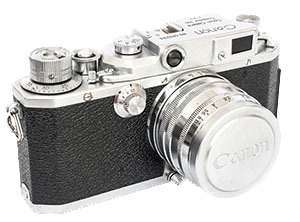
Contents
(Scroll down or click on Links)
User Manuals etc.
The Canon Story
Canon Distributors
Shimo-Maruko Factory
The “Canon” & Eagle Logos
The “Canon” Camera Name
“Made in” and Other Markings
Canon Serial No.s & Naming Conventions
Marked Model Names
Canon Rangefinder Body Dimensions
The Canon Rangefinder EBL
Black Bodies
Odd Spec Canon L and VL Cameras
The Models
Kwanon (prototype series)
Hansa Canon & Canon Original
Canon S
Canon J
Canon NS
Canon JS
Canon J II
Canon S I
Canon S II
Canon II B
Canon 1950 (trial series Canon III & IV)
Canon III
Canon II-C
Canon IV
Canon III-A
Canon IV-F
Canon II-A
Canon IV-S
Canon II-D
Canon II-D1
Canon IV-Sb/IV-S2
Canon II-AF
Canon II-AX
Canon II-F
Canon II-S
Canon IV-Sb2
Canon II-S2
Canon II-D2
Canon II-F2
Canon VT
Canon L2
Canon L1
Canon VT de luxe
Canon VT de luxe Z (Peter Dechert name)
Canon L3
Canon VL
Canon VL-2
Canon VT de luxe M (internal Canon name)
Canon VI-T
Canon VI-L
Canon P (Populaire)
Canon 7
Canon 7s
Canon 7sZ (Peter Dechert name)
Canon Lenses, Flash & Accessories Page
My Canon Page
I understand that there are Canon rangefinder owners, as there are Minolta 35 owners, that will take offence at the term “Leica copy” in reference to their camera. Like all categorisations, things are rarely black or white, most often they fall somewhere along a spectrum, in the case of Leica copies, from inspired by to exact copy. As explained on the Leica Copies Japan page, collectors, historians and authors such as HPR and Pont and Princelle have used certain criteria, not always agreed amongst themselves, to determine whether a camera is a Leica copy or not. In that context, the visual appearance and technical design solutions are secondary at best and maybe even immaterial. However, there is no doubt that Canon cameras were heavily influenced by Leica and that at least from 1951 onward, Canon was fully compatible with Leica, even if the designs diverged widely from the mid-1950s on.
My Canon page is different to both my other Japanese Leica copies pages on this site and my other site, Yashica TLR. Whilst I am fairly confident that those pages and site are the most detailed and accurate about their camera models that you will currently find on the Internet, I cannot claim the same for this Canon page, although I will continue to work hard towards that end.
I have come to Canon rangefinder cameras late, in fact it is the last step in my journey, whereas it is actually the starting point for the Japanese Leica copies story and along with initial lens partner, Nikon, one of the milestones and major drivers of the Japanese photographic industry. There are many Canon enthusiasts everywhere with a lifetime interest and commitment to the brand and I could not hope to match their knowledge in such a short space of time. And of course there is Canon itself.
Nevertheless, to complete this website and put the Leotax, Nicca, Minolta and Yashica models into context, I've dived right in. The Canon rangefinder range is vast and the lens and accessories ecosystem is huge and therefore I have had to be selective as to what is included. Some of the more nuanced detail may be lacking but I have tried to provide enough guidance about where to look. As with all my pages, my aim is to question everything and be as accurate as possible.
One area that I have devoted significant effort to are the historical facts around the Kwanon prototypes and the first production camera, the Hansa Canon. The reason is that the two heavyweights in Canon history research, author Peter Dechert and Canon itself, are in the ring duking it out over whether the advertised Kwanon cameras existed, or not, and hence their impact. In the process, some interesting observations and tidbits from Japanese sources seem to have been missed. Without giving anything away, I note that whilst Canon does seem to mess up some of the detail on its Camera Museum site, in regard to the big questions, it did have people there at the beginning, including one of its later presidents.
Links to the Good Stuff
First to the books. Anyone serious about collecting Canon interchangeable lens rangefinder cameras and/or their history should seek out the seminal work, “Canon Rangefinder Cameras 1933-1968” by Peter Dechert. This was first published in 1985 but time has not diminished its stature - work by others since has added to our knowledge but changed little of what Peter had researched. That's not to say that there is nothing that invites questioning. One such instance, concerning his Canon 1950 model, he corrected himself with his 2006 Shutterbug article. Nevertheless, I have relied heavily on the guidance his book provides, both directly and through other sites and authors. Now out of print but used copies do become available. His monograph, “The Contax Connection”, which can be found on the Internet, also covers early Canon history and the company's relationship with Nikon and is worth the read for that, but in my view, then gets some things wrong about post-War Nicca history and Yashica rangefinder models, which in fairness was not the focus of this article, or his research. However, that is more of a problem for those pages of this site than this one.
In his preface, Peter Dechert acknowledges people that assisted him along the way. Two of the most important are Japanese contributors Mikio Awano and Hayato Ueyama. Mikio Awano was the editor and publisher of “Camera Collectors' News” and also a key contributor to Koichi Sugiyama's book, “Collector’s Guide to Japanese Cameras”. I have relied on Camera Collectors News articles for several camera histories on this site, including this page, see below. Hayato Ueyama was a Canon ex-employee and is the author mentioned further below.
A camera is only as good as the lens/lenses it is offered with. Peter Dechert didn't provide much detail in this regard, particularly of the many minor variations found, but Canon aficionado and author Peter Kitchingman has covered it all in his really excellent book “Canon M39 Rangefinder Lenses 1939-1971”. Published in 2008, also out of print but in early 2023, the author still has some copies. (I'll say it now, whilst it is easy shorthand and has become common practice, I think the use of the “M39” name is misguided, the “M” stands for metric and applies to mainly Soviet cameras, both rangefinder and early SLRs. Although early Canons used bayonet, “J” and semi-universal mount lenses, the vast majority of Canon lenses used the Leica standard 26 threads per inch Whitworth, i.e. it is not a metric thread despite the 39 mm diameter. To argue that M39 is acceptable is to argue that the J mount with its 39 mm diameter is also M39.)
An excellent book recommended by Peter Kitchingman and others is “Canon Vol.1 All About Seiki Kogaku” by Japanese author Hayato Ueyama (see connection to Peter Dechert above) published in 1990 in Japanese. It covers the Seiki Kogaku period from the beginning to the name change to Canon in September 1947 with the focus being on the cameras and variations, including lenses, accessories and also prototypes, but there are also fascinating insights that only a native Japanese speaker with many contacts in the enthusiast community would have acces to, including Seiki Kogaku employees from the early days. Flynn Marr has a machine translated version on his website, link below. That in itself has been a massive task but be aware that not everything in Hayato Ueyama's book is included in the PDF, nor does the PDF reflect the quality of the images.
Japanese enthusiast magazine, Camera Collectors’s News. This is the magazine edited and published by Mikio Awano mentioned above. Both the magazine and Mikio Awano are referenced by Hayato Ueyama. I have a December 1977 edition with an article by Awano on the Canon J, JS and J II and I also have the May and June 1982 editions which include Parts 2 and 3 respectively of the early Canon story, both featuring the Hansa Canon and Canon original and offering some interesting insights and alternatives. I believe that Part 1, presumably April 1982, covers the Kwanon period and that there is at least a Part 4 covering subsequent models, these I have yet to find. The author of Parts 2 and 3, and possibly all parts, is Kannonji Makoto.
Next the Facebook page, “Canon Historical Society” established by Pacific Rim Camera. Peter Dechert posted here before his passing and Peter Kitchingman is a regular plus there are other luminaries and many, many other contributors doing their own research - an excellent resource.
Finally, links to Canon Rangefinder Related Sites. Not in any particular order but for anyone looking for documentation like user manuals, brochures etc., Pacific Rim Camera offers a boatload of free stuff for download as PDFs (plus lots of stuff for sale) and a great guide for identifying your Canon model (similar on the flynngraphics site):
https://global.canon/en/c-museum/ Canon History Museum (Note, Canon is not infallible with its own history, there do appear to be errors and omissions)
https://pacificrimcamera.com/rl/rlCanonRF.htm Reference Library - Canon Rangefinder. Camera, lens and flash manuals, brochures, price lists
https://butkus.org/chinon/canon.htm Mike Butkus. Camera and flash manuals
http://photosynthesis.co.nz/nikon/lenses.html#RF_5cm Roland. Nikkor lenses for early Canons
https://w.atwiki.jp/saltysugar/pages/28.html A PDF copy of the 1936 Omiya Photo Supply catalogue with 7 pages devoted to the new Hansa Canon can be downloaded from Hansa Canon & Canon Original below, or Mike Eckman's Hansa Canon/ Canon Original review page, however, the original document was located on this Japanese site. Unfortunately, the links to PDFs of manuals and catalogues no longer work, but for lens nerds, clicking on “Top Page” in the sidebar will take you to a page of links including “Calculating the Canon 50mm F0.95”. Suggest using the Google Translate feature of Chrome
https://mikeeckman.com/2022/02/canon-original-hansa-1935/ Mike Eckman. Hansa Canon
https://mikeeckman.com/2019/10/canon-ivsb-1952/ Mike Eckman. Canon IV-Sb
https://mikeeckman.com/2016/02/canon-p-1961/ Mike Eckman. Canon P
https://mikeeckman.com/2021/02/canon-7-1961/ Mike Eckman. Canon 7
http://corsopolaris.net/supercameras/CanonRF/CanonRF.html
https://flynngraphics.ca/the-collection/ Flynn Marr. Canon collection, camera and flash manuals
https://flickr.com/photos/80936052@N00/albums/72157704498817892 Kirk Thorsteinson. Canon X-ray cameras, copy stand and other Canon stuff.
https://yashicasailorboy.com/category/canon-model-7/ Chris Whelan. A little Canon 7 stuff, but this is an unashamed plug for my friend whose contributions have helped and encouraged me across the pages of my sites. For lovers of rangefinders, you'll also find a little on a Leica IIIg, Niccas and Yashicas. Not to mention his Canon F-1s.
User Manuals etc.
Links to download user manuals and other useful documents were provided above. Below are links to my own small number of manuals, some the same as elsewhere, some a little different. These are also linked from the items they relate too. Click on cover for PDF of full manual, or for larger image, as appropriate.
(Note for MacOS users only: Safari is sometimes displaying only the left half of double page scanned PDFs if the first scan is a single page - common with my cover pages. If it is a problem, suggest using different browser, or Preview, instead.)
Cameras
Canon II-D and IV-S2 manual (July 1953), Canon II-F (and D) addendum and Japanese Canon L2 and L3 manual (October 1957):
Lenses
Canon Lenses Directions and Tables, undated but identical to August 1954 and January 1955 printings:
Flash
Two page Flash Unit B instruction sheet in English on fragile rice paper which may well be 75 years old. Whether this served as the English instructions at the time, or it has been copied from the original, the wording seems to be in the authentic Canon style:
Flash Unit B 1 packing slip below left and user manual on the right, both dated December 1950:
Late Flash Unit X manual, August 1952, and late Flash Unit Y manual, October 1955:
Auto-Up
Japanese instructions for V series Auto-Up, June 1957:
The Canon Story
The historical context leading up to the establishment of Canon as Seiki Kogaku Kenkyujo (Precision Optical Instruments Laboratory) and its early models, including Nippon Kogaku's (today's Nikon) important role, is broadly covered in The Japanese Copy Makers. Seiki Kogaku was founded in November 1933 by two men with no real experience in camera design, or production, and no product but they had a belief that Japan could produce a camera equal to the German Leica and Contax. The enterprise was initially located on the third floor of the Takekawaya apartment building at 62 Roppongi, Azabu-ku (Azabu Ward, these days, 7-14-4 Roppongi, Minato-ku, or Minato Ward) in Tokyo:

Goro Yoshida had the ideas and his brother-in-law, Saburo Uchida, was the businessman. Others that joined them included Takeo Maeda, a colleague of Uchida, and Tomitaru Kaneko who became the first factory manager. Only Maeda would remain long term, becoming Canon's president in 1974. Goro Yoshida (1900-1993) at age 41 after he had left Seiki Kogaku and later in life:

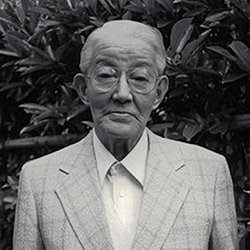
(Left image from Hayato Ueyama's book)
Later in life photos of Saburo Uchida (1899-1982) and Takeo Maeda (1909-1977):
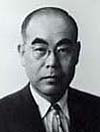
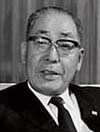
Goro Yoshida was the driving force force for developing a Japanese precision 35 mm camera and principally responsible for the prototype, or perhaps more correctly, concept designs. Without his dream, there likely would not have been the birth of Canon, although ultimately, he probably contributed little to the first Canon production model. Yoshida was born in Fukuyama-shi, Hiroshima-ken (Fukuyama City, Hiroshima Prefecture) in 1900 and went to Tokyo before completing his middle school education and was apprenticed with a company repairing and remodeling motion picture cameras and projectors so he knew his way around camera type equipment, tools and instruments. In October 1933, Yoshida approached Uchida to ask for financial assistance for his venture and so the journey commenced. Uchida was born to a wealthy kimono wholesaler in Kurashiki-shi, Okayama-ken (Kurashiki City, Okayama Prefecture) in 1899 and after graduating in law at Tokyo Imperial University, was employed by a securities firm. At some point between 1932 and 1934, Yoshida famously disassembled a Leica II camera and discovered it was made of ordinary materials that didn't seem to justify its exorbitant price, not “special items like diamonds”.
The prototype designs, the first evidence of which was a drawing that appeared in a June 1934 advertisement, were named “Kwanon” after the Buddhist Goddess of Mercy and its 50 mm f/3.5 lens with Leitz Elmar-like collapsible lens barrel was called “KasyaPa” (note, written on the lens with a capital “P”) after a disciple of the Buddha, Mahakasyapa. The source of the lens is unknown but also presumed to be a prototype - there, was as yet no market for a 35 mm lens. According to Hayato Ueyama, when asked about the source of the KasyaPa lens, Goro Yoshida claimed it was made by a “lens shop near Kanda Manseibashi Bridge”, but Ueyama says that the actual location of the “lens shop” is unknown and the claim can't be verified. June 1934 ad:

The body design was influenced by both an admiration for the Contax I and its Zeiss Ikon creator and the practicality of the Leica II. Film transport was cassette to cassette so no rewind knob was required. The film winding and shutter cocking knob looked similar to the Leica item but was mounted on the front in Contax I style.
It was decided to rename the production camera “Canon” which was pronounced the same but perceived as less religious and also more acceptable in English. Somewhat perversely, “canon” means rule, law or principle but is most often used in the context of Christian law. A trademark application for the name was filed in June 1935 and granted in September 1935. The first mention of the Canon (already as the “Hansa Canon”) was in the new products column of the October 1935 edition of Asahi Camera magazine with sales believed to have begun in February 1936. Below is a schematic of the Laboratory's workforce structure in around 1935 translated from Hayato Ueyama's book (page 14):

Internal layout of the Laboratory, as translated from page 13 of Hayato Ueyama's book. I suspect that this is also from 1935, or early 1936, as it seems to be set up more for making cameras than the design phase and there is no mention of Goro Yoshida. Ueyama lists the equipment as one Pauley(?) bench mill, one Lorch bench lathe, one small lathe and two drill presses. He says that drawings were done freehand and the only inspection tools were callipers and micrometers:

Initially, production was very low as new skills were being learnt and experience developed with much rework needed. Equipment was basic. It picked up in June 1936 when a larger facility was acquired at No. 82, Nakane-cho (Nakane town), Meguro-ku (Meguro Ward), Tokyo. According to Hayato Ueyama, it was a long single story building among farming plots near the Nomigawa River. At the same time, the Laboratory's name was changed to “Nippon Precision Optical Instruments Laboratory”, first appearing in the Hansa Canon ad in the August 1936 edition of Asahi camera. The new factory pictured in 1937 (page 16 of Hayato Ueyama's book):

The production camera was somewhat different to the Kwanon with lens, focusing mount and rangefinder system now designed and made by Nippon Kogaku. These were significantly changed to avoid infringing Leica's Japanese patents granted in 1934. Goro Yoshida had been unable to come up with a workable alternative so Saburo Uchida approached Nippon Kogaku where his brother, Ryonosuke Uchida, had worked as an auditor. Nippon Kogaku had been actively seeking to diversify from mostly military work and had appointed Toyotaro Hori to investigate potential opportunities. However, it meant that probably more than half of the value of the camera and lens set was now contributed by Nippon Kogaku, as was the accompanying research and development. Goro Yoshida became disillusioned with the direction camera production was taking and departed in late 1934 with design becoming the responsibility of Tomitaru Kaneko, a Nippon Kogaku graduate and factory manager.
Instead of the Leica mount's 39 mm thread with a pitch of 26 threads per inch (TPI), the mount for the Canon featured the same 39mm diameter but with a pitch of 24 TPI and the Nippon Kogaku made focusing mount was screwed into this. The removable lens barrel was inserted into it using a bayonet fitting. The design and execution was more than somewhat similar to the Zeiss Contax arrangement but the rangefinder connection was unique.
The viewfinder arrangement was also different, the rangefinder windows were in their expected positions but the viewfinder itself was a pop up type designed by Tomitaru Kaneko. This was colloquially known as “surprise box” (Canon Camera Museum, and Hayato Ueyama). The initial Kwanon drawings showed a centrally placed typically Leica type whereas the last design show a folding type mounted in a shallow recess on top of the rangefinder cover. The large dial on the front was the frame counter left over from the earlier Kwanon designs with the winding knob on the front. Curiously, but no doubt coincidentally, the counter arrangement was also somewhat reminiscent of the 1913 Ur-Leica (original prototype). Brochure featuring earliest type with viewfinder popped up in viewing position:

Slightly later example showing viewfinder stowed:
 (Web image)
(Web image)
Perhaps in response to the 1934 release by Kodak of the disposable film cassette, production cameras featured a typical rewind knob in place of the cassette to cassette system of the prototype Kwanon (the reason for the change was possibly more complicated than that, see “Kwanon D - Peter Dechert, Hayato Ueyama” in the Kwanon section).
Commonly called “Hansa Canon” by collectors for convenience sake, and even by Canon in more recent times, the model name was simply “Canon” and back then, Seiki Kogaku called it “The Canon Camera”, or “Canon Standard Model”. “Hansa” was, and still is, a trademarked brand name used by the camera's distributor, Omiya Shashin Yohin Kabushiki-Kaisha (meaning Omiya Photo Supply Co., Ltd.) which usually appears above “Canon” on the camera's top plate (apparently derived from the “Hanseatic League”, a middle and northern European mercantile network originating in medieval times). Omiya Shashin Yohin owner, Hikotaro Noro, was one of the people instrumental in changing the name from Kwanon to Canon along with Saburo Uchida, Goro Yoshida’s brother-in-law and manager of the Laboratory’s business affairs. A very small number of cameras were sold directly by the factory and these don't have the Hansa engraving (called “Canon Original” by collectors). Marketing material issued by Omiya Shashin Yohin usually referred to the camera as “Hansa Canon”.
At this stage, the fledgling camera maker was only barely being kept afloat by Nippon Kogaku's interest in the project when Dr. Mitarai, an obstetrician and friend of Saburo Uchida, made his first investment in the business in 1937 and became its auditor. On 10 August of that year, with capital of 1 million yen, Precision Optical Instruments Laboratory was formed into Precision Optical Industry, Co., Ltd. (Seiki Kogaku Kogyo Kabushiki Kaisha) with the abbreviated maker name “Seiki Kogaku” appearing on models after the Hansa Canon.
In an article for Camera Collectors' News of September 1982, Kannonji Makoto writes that in September 1937, following Seiki Kogaku becoming a company, the Hansa name disappeared from advertising and later, also from the top plate. This is also confirmed by Hayato Ueyama. My database contains two early Canon Originals, one in the late middle and four right at the end, so that is consistent. More on this at Hansa Canon & Canon Original.
Peter Dechert tells us that “Dr Mitarai appears at first to have been interested in the development of indirect X-ray recording cameras” and Peter Kitchingman goes further to say that he “encouraged the company in its early days to produce and develop special X-ray equipment”. However, according to Hayato Ueyama, Seiki Kogaku first got involved when approached in 1939 by Dr Junjiro Okanishi, a relative of Saburo Uchida and Deputy Director of the National Research Institute for Infectious Diseases. Takeo Maeda and Katsuo Ando met with Dr Okanishi who showed them a foreign magazine which described how such a device might work and asked whether Seiki Kogaku could make him one to experiment with. The request was declined because there wasn't enough information about the camera and set-up and pressures of other work. Although nothing came of this, 12 months later when Nippon Kogaku and Konishiroku (later day Konica) couldn't accept orders placed by the Navy and Army Medical Schools because of exisiting military commitments, Seiki Kogaku was asked to develop one. It was a simple device and although it evolved over time, the basic design remained largely the same from 1940 until 1956, a 6 x 6 cmm version was added to the 35 mm camera in the late 1940s.
Back in 1939, a young lens technician cum designer Ryouzou Furukawa (Canon Camera Museum calls him Yoshizo Furukawa which may be more correct given translation issues) and several other workers were transferred from Nippon Kogaku along with some lens making equipment. One of the Seiki Kogaku first lenses was for a finger print camera and according to Hayato Ueyama, a number of prototype lenses were made including a 13.5 cm f/4 and a 20 cm f/4. An X-ray camera lens was developed (initially f/2 but redesigned into the R-Serenar 5 cm f/1.5) with the “Serenar” name being trademarked in December 1941.
To put the X-ray camera into perspective, Seiki Kogaku was not the only War-time producer. Konishiroku did actually develop their own Rubicon X-ray camera around 1940. It was based on its pre-War Rubikon prototype fixed lens leaf shutter 35 mm rangefinder camera and fitted with its own Luminon f/1.6 lenses (both 50 mm and 75 mm lenses are known to have been used). Like Seiki Kogaku's camera, versions continued to be made after the War. There was also the Nippon Koken X-ray camera, dating from 1942 or 1943, fitted initially with a Lumitar (unknown maker) 5cm f/1.5 and then a 5cm f/1.5 Xebec for Röntgen lens made by K.O.L. (Kajiro Optical Laboratory).
In July 1940, the Japanese Military Government had proclaimed that all camera production was to be for military use only, thereby complicating Seiki Kogaku's growth options. Production increasingly turned to munitions of various kinds, some optical, some not, some supporting Nippon Kogaku, some direct orders. In 1944, the company was placed under the control of the Ministry of Munitions, the Ministry of War and the Ministry of the Navy.
Earlier, Dr Mitarai became concerned with its business direction and in 1942, he became president of Seiki Kogaku. He guided the company through the War years including the acquisition of independent optical manufacturing company, Yamato Kogaku Seisakusho, in February 1944 and also the post-War reconstruction. Note, I understand that the Kanji character “大和” for Yamato can also be pronounced Daiwa - Canon uses Yamato, Peter Dechert calls it Daiwa. At the time of acquisition, it's production was almost entirely focused on 10x aviation binoculars.
To avoid confusion and lack of recognition between the company name and its product name, Dr Mitarai was instrumental in changing the Seiki Kogaku company name to “Canon Camera Company, Ltd.” with effect 15 September 1947 (Peter Dechert's book says 15 August), changing again in January 1951 to “Canon Camera Co., Inc.” On 1 March 1969, the name was shortened to “Canon Inc.” to reflect the fact that Canon was no longer just a camera company. Together with Takeo Maeda, the only surviving member of the original team, Dr Mitarai continued to lead Canon through its growth as president until 1974 after which he served as chairman until his death on 12 October 1984. Takeo Maeda succeeded Dr Mitarai as company president until 1977.
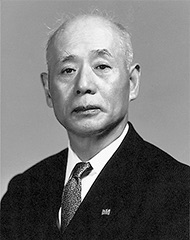 Dr Takeshi Mitarai (1901-1984)
Dr Takeshi Mitarai (1901-1984)
The pre-War introduced models following the Hansa Canon continued to be different from Leica because of patent concerns. According to Hayato Ueyama, the Canon S was announced in October 1938 and advertised in November 1938 but the camera was still a prototype with the slow speed shutter dial offset and without crank - this was not finalised until 1939 which fits with the Canon claim that it was “marketed” in April 1939. It wasn't called the “S” back then, Seiki Kogaku called it “Canon Newest Model” whilst referring to the still current Hansa Canon/Canon Original as “Canon Standard model without slow speeds”. After Hansa Canon/Canon Original production ended and stock petered out, probably in 1940, the Newest Model became the new “Canon Standard model”. According to Peter Dechert, the reference to it as the “S model” became so established that by the end of the War, even the factory used the name:
 (Web image)
(Web image)
Also released in 1939, the budget model Canon J without rangefinder and slow speeds eliminated the expensive Nikon focusing mount and instead used the 39 mm 24 TPI screw mount directly in Leica fashion but of course was not Leica compatible. Without a rangefinder, it avoided Leica's focusing patent. This is now referred to as the “J mount”. At the time, Seiki Kogaku called the camera “Popular Model”. Peter Dechert tells us that early orders referred to as the “Junior Canon”, hence “J”, and after the War, the name stuck.

(From December 1977 edition of Camera Collectors' News magazine)
There were also the minor variations, the pre-War budget Canon NS, an S without slow speeds, and the Canon JS, a J with added slow speeds, perhaps intended as a copy camera for the military.
The War devastated Japan and afterwards companies were struggling to exist let alone survive or thrive. Seiki Kogaku had been fortunate, only the Itabashi factory, a legacy of the Yamato acquisition, sustained significant damage and that was the result of an accidental fire. The main Meguro factory and the Takara-mura and Yamura-machi factories, established to undertake War-time production evacuated from Tokyo, remained operational but were closed with the end of the War. In order to restart production, Dr Mitarai applied to the Allied Occupation Forces for permission to produce consumer goods and this was granted on 1 October 1945. According to sources quoted by Mikio Awano in his December 1977 Camera Collectors' News article, camera production restarted with a workforce of 156, including 43 women.
Initially, production used up War-time stocks of mainly Canon S parts but the focus was on the J model because this was the easiest and quickest to assemble into a saleable camera. The formally big and well resourced Nippon Kogaku was in a much worse postion post-War and may have struggled to provide focusing mounts, rangefinders and even lenses. Although a few J model cameras may have been made for the military during the War, “volume” production of a “few hundred” had ended in 1941 so the post-War version commonly used S bodies with the slow speed shutter dial hole blanked off and S viewfinder/rangefinder cover pressings. This version was called the “Canon J II”.
The Canon J II went on sale in December 1945 (Mikio Awano, January 1946 according to Canon) but by the end of 1945, only three cameras had been completed. However, by the time production ended in November 1946, some 560 had been made. The S model was produced at the same time but according to Peter Dechert, there were only a total of 97 made. However, unlike the J II, it appears to be physically identical to late War-time production and much the same as when released. This post-War production was referred to as the “S I” model but because they were assembled mainly from parts produced perhaps years earlier, even experts have trouble identifying an S I from an S.
Interestingly, the Canon Camera Museum acknowledges the role of an American automobile engineer, William Reagan Gorham, who became a naturalised Japanese citizen in 1941, having moved there in 1918, and during the 1940s provided Seiki Kogaku valuable production and quality assurance advice.
With German patents no longer an issue, the first post-War designed model was the Canon S II released in October 1946. Still with the signature Canon hexagonal body ends, it otherwise looked very similar to a Leica III except for the first major innovation, the rangefinder and viewfinder were combined and there was a single viewfinder window. It was initially fitted with Seiki Kōgaku's newly developed “Serenar” 5 cm f/3.5 lens followed by an f/2 option, although early on, there were still some Nikkor f/3.5 lenses as well. As Seiki Kōgaku production increased, the partnership with Nippon Kōgaku finally ended in 1948. Canon S II with Serenar f/3.5 5 cm lens shortly after the maker name change to “Canon Camera Co.”:

Peter Dechert tells us that the Canon S II featured a mount referred to as “semi-universal” which was close to the Leica standard but would accept the earlier J mount lenses as well as most Leica lenses - to make it work, the threads were cut sloppier (some have suggested more so on the body mount). Peter Dechert says that until 1947, Seiki Kōgaku and Nippon Kōgaku engineers, like the Soviets before them, believed that the Leica thread pitch was 1 mm (metric) without realising it was 0.977 mm (based on 26 threads per inch Whitworth). The rigid barrel f/1.8 50 mm Serenar, developed during 1951 and released with the Canon IV-F in January 1952, was the first Canon lens with “universal” mount, meaning it was finally fully Leica compatible.
The real innovation and major success came with the next model, the 1949 Canon II B (initially called the S IIb), which added three level magnification to the viewfinder and was a unique Canon feature appreciated by photographers until parallax corrected frame lines were introduced in 1959:

Progress continued with evolution rather than revolution with flash sync being added in 1951. The IV-Sb (IV-S2 in export markets) released at the end of 1952 became the biggest selling Canon bottom loading model and the first to find real succes in export markets:

The last of the Series IV models receiving a new shutter in 1954 with 1/30 changeover speed and a two piece main dial that could be set cocked or uncocked. However, the Leica M3 release, also in 1954, caused shockwaves in the industry and Canon responded with bigger changes in 1956 introducing a revised body with hinged opening back, a viewfinder with provision for the 35 mm focal length and a choice of trigger or lever film wind. The single non-rotating shutter dial appeared in 1958.
1956 Canon VT with trigger wind:
 (Web image)
(Web image)
1957 Canon L2 with lever wind:

It was also in 1956 that Canon diversified into movie cameras with the release of the Canon Cine 8-T:
 (Web image)
(Web image)
The interest in SLRs was rising, something Canon could not ignore, and in May 1959 Canon released its first model, the Canonflex. It was developed alongside the VI series rangefinders and shared some of the technical design, including Canon's ill-founded fondness for bottom winding designs. Whilst undoubtedly of professional quality, it felt more of a design exercise to test the market than its arch-competitor, the Nikon F, which had been designed for professionals by professionals and arrived on the market one month earlier:

(Image courtesy of Chris Whelan)
By 1959, most interchangeable lens rangefinder makers had either fallen by the wayside, or moved on to SLRs themselves, e.g. Minolta and Yashica. Nikon also bet its future on the SLR and discontinued mass production of its professionally successful rangefinders. However, Canon was still principally a rangefinder company and in September 1961, Canon launched its most successful model yet, the Canon 7. It took the shutter coupled accessory Canon Meter of recent models, patterned on the Leica M3's Leicameter, and built it in, the frame lines were projected rather than the reflected of the earlier Canon VI and P models and the lens mount included an external bayonet for the optional f/0.95 50mm lens:
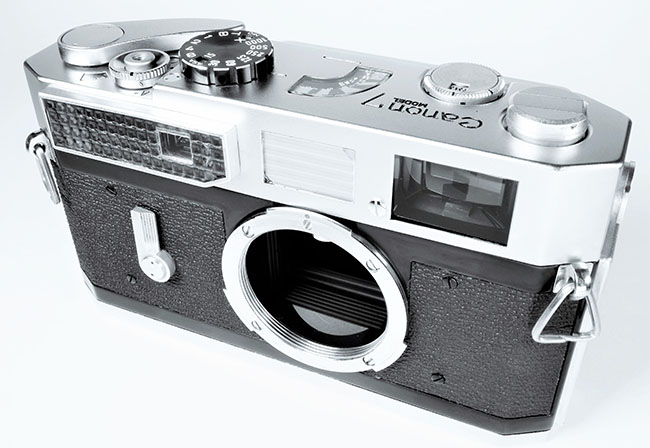
(Image courtesy of Chris Whelan)
One of the reasons for Canon's growth and success during the 1950s was its strategy to leverage the development costs of its premium models and offer many variations of lower spec'd models at various price points to appeal to the biggest cross section of the market possible. If you wanted a Canon rangefinder, there was likely to be one within your budget and it still looked like the premium offering. By the time of the Canon 7, the market had changed and SLRs were making inroads at an ever increasing pace. Canon now only offered a single spec body but you could have a 50 mm lens with an f/1.8, f/1.4, f/1.2 or f/0.95 aperture.
The updated 1965 7s with CdS exposure meter was the last hurrah and in 1968, Canon's, and Japan's, interchangeable lens rangefinder camera era was over. SLRs, fixed lens leaf shutter rangefinders, point and shoot cameras, movie cameras and diversification into other products was now the company's future.
Canon Distributors
Seiki Kogaku was a small start-up camera maker without marketing or sales skills trying to sell into a difficult, low wages market. The use of sales agents and distributors seemed to be common practice by the Japanese photographic industry both before the War and in the early post-War years, and later in Canon's case. As we have already seen, Omiya Shashin Yohin Co., Ltd. (Omiya Photo Supply), was appointed the exclusive sales agent for the Hansa Canon. Whilst the Hansa name didn't appear on subsequent models, the relationship seemed to continue until at least the War.
After recovering post-War, a large part due to targeting sales to occupation forces, Canon sought to kick-start exports to achieve further growth. In early 1950, C.R. Skinner Manufacturing Co. of San Francisco was appointed to handle US sales, but as it turned out, a roll it was apparently ill equipped to do. C.R. Skinner ad for the Canon II B in the April 1950 Popular Photography magazine:
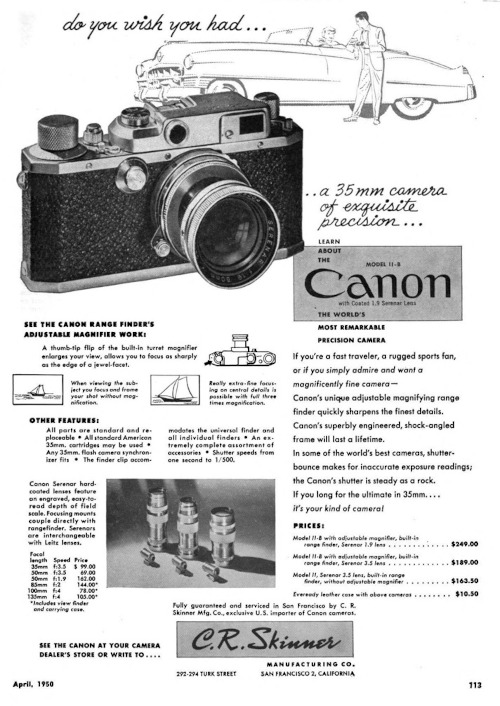
Also in 1950, Dr Mitarai visited the US International Trade Fair in Chicago, held from 7 to 20 August. Whilst in the US, Dr Mitarai met with Bell and Howell to seek a distribution deal but this proved unsuccessful, mainly because of concerns about Canon's timber factories, typical for Japan, and the fire risk they posed.
In November 1951, a five year export agreement was entered into with Hong Kong based trading company Jardine Matheson Co. and with continued disappointing sales in the US, Canon and Jardine replaced Skinner with Balfour, Guthrie and Co., Ltd. which continued to be responsible for sales operations even after Canon set up New York based Canon Sales Co., Inc. in 1955 to take over US distribution. This was located at 550 Fifth Avenue, New York 10036, NY. In 1957, Canon opened the European Distribution Center in Geneva, Switzerland, to replace Jardine in that market area, in 1963 becoming Canon Geneva S.A.
Back in the US, Canon appointed Scopus to handle distribution for subsidiary Canon Camera Co., Inc., a role that Bell & Howell took over in 1962. Bell & Howell co-branding appeared on a number of models including the Canon 7 rangefinder.
Shimo-Maruko Factory
As a consequence of the initial rejection of a business relationship by Bell and Howell on fire safety grounds, Canon purchased the former Fuji Aviation Instruments Co., Ltd., factory in Shimo-Maruko, Ohta Ward, Tokyo, in June 1951. Note, these days, the hyphenated “Shimo-Maruko” is often translated as the single word “Shimomaruko”. According to a Japanese website, the building measured 23,255 square metres in total floor area on 23,100 square metres of land. By November, after some modifications, Canon began relocating major functions from its head office in Ginza and the Meguro and Itabashi factories to its new flagship site:

The official translated address in 1950s documents was usually in the form of “Canon Camera Co., Inc., 312, Shimo-Maruko-Cho, Ohta-Ku, Tokyo, Japan”.
The ad below, with a machine translated version below that, is from the beginning of 1952 and notified the Japanese public that the move was complete:


The Meguro and Itabashi factories were then apparently sold.
The “Canon” & Eagle Logos
The development of the “Canon” logo is explained on the Canon Global site. The earliest prototype, the Kwanon X, featured an engraving of the Kwanon deity, see Kwanon (prototype series). The “logos”, as defined as such by Canon, seem to progress from what was on the camera (but often not on other items) to what remains now as the official corporate identity:
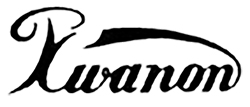 1934 Engraved on some of the Kwanon prototype series.
1934 Engraved on some of the Kwanon prototype series.
 1935 Engraved on cameras from Hansa Canon to early production 1957 Canon L2.
1935 Engraved on cameras from Hansa Canon to early production 1957 Canon L2.
 1953 Described as “unification” & “further refined” (the “Canon” name on the covers of the 1946 S II & 1949 II B manuals are already close).
1953 Described as “unification” & “further refined” (the “Canon” name on the covers of the 1946 S II & 1949 II B manuals are already close).
 1956 Corporate logo (but which already appears on the cover of the February 1955 printing of the IV SB2 user manual). It began to appear on more recent cameras (1963 Canon Demi may have been the first), but not on interchangeable lens rangefinders, except for items such as user manuals, lens caps, cases, boxes, flash units and other accessories.
1956 Corporate logo (but which already appears on the cover of the February 1955 printing of the IV SB2 user manual). It began to appear on more recent cameras (1963 Canon Demi may have been the first), but not on interchangeable lens rangefinders, except for items such as user manuals, lens caps, cases, boxes, flash units and other accessories.
The Canon Eagle and the earlier Seiki Eagle logos don't rate a mention by Canon. The Seiki Eagle first appeared in advertising at least as early as August 1936. Initially, it appeared as a complete bird as in this ad for a “New Canon”, which is what we know as the Canon J, probably from 1939:
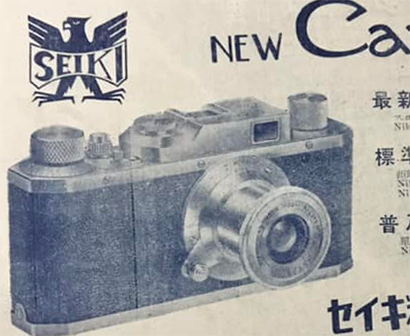
Possibly its final appearances was in an August 1947 Japanese magazine ad where it again was displayed as the full bird with legs:

(Ad scan courtesy of Martin Bacardi of the Canon Historical Society Facebook group)
Martin Bacardi has collected and investigated Seiki Kogaku magazine ads and other marketing material and notes that there were two main versions of the Eagle design, the second replacing the first in literature from 1937 but the first continuing to be used on accessories such as the Seiki Albada Finder, Seiki Precision Finder and Seiki Sport Finder, possibly because it was easier to engrave. The quality of the graphic design also varied. It was also sometimes depicted without legs as on the early X-Ray camera below and the finger print camera from probably 1940, or 1941, shown in Peter Kitchingman's Book:
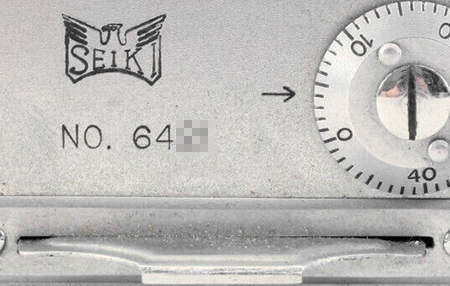
With the change of the company name to Canon in September 1947, it became the Canon Eagle but now lost its legs for evermore. These examples linked to the company name changes are courtesy of Kirk Thorsteinson and are smaller versions of those on the Canon page of his Flickr site:

However, as with the Seiki Eagle, there were variations depending on use case, compare his first type with the version embossed on a 1947 13.5 cm f/4 Type 4 lens case (Peter Kitchingman classification):
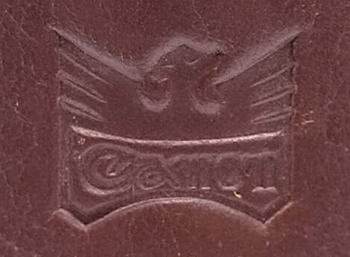 (Web image)
(Web image)
This example is from the inside of the lid of a presentation box for a Serenar 100mm f/4 lens from 1952 (see Lens Boxes):

The Canon Eagle was embossed on late 1940s to 1955 camera ever-ready cases and lens cases. This one is on the lower back of an IV-Sb ever-ready case:
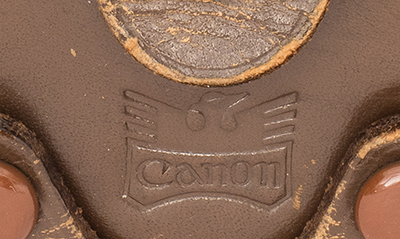
And this one is on a similar vintage 135 mm f/3.5 lens case:

It also featured on the backs of user manuals and on many ads and brochures, the last widespread appearance being for the 1956 “Model V” (Model VT). The eagles at the end of a circa 1956 brochure and on the back of the Model V instructions:
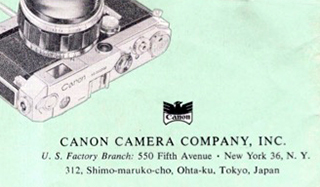
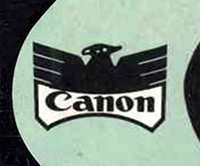
The only camera to feature the Canon Eagle was the special edition 25th Anniversary Canon P (probably 1961 production) which was only offered to the Canon workforce, its last hurrah, as far as I am aware:

The “Canon” Camera Name
How the “Canon” name appeared on things like ever-ready cases, lens caps and other places varied over time with both logos and fashion, but, there was only one real change of style with how it appeared on cameras and a minor change in presentation. On every camera, the Canon name letters featured serifs, the little decorative angled pieces on the Canon “C” and “n”s and the later “a” at least. Some people refer to the 1957 “C” as the “C with the Serif” but whilst it has a long serif, the very short one on the Hansa Canon is also a serif. Top row are the bookends of the first style, the 1935 Hansa Canon and 1957 Canon L2 up to about serial number 523143. Next row is a Canon L1. It, the later production L2 and the VT de luxe ushered in the change to a longer serif on the “C” and flattened serifs on the “a” and two “n”s, but the size and emphasis remained similar - it may be a stylised interpretation of the 1956 Corporate logo, but it is certainly not the same. The Series VI cameras (VI-T, VI-L and P) moved the name from the top of the top plate to the left front on the top superstructure but the style didn't change. On the third row by itself is a Canon 7 which returns the name to the top of the top plate in the same font, but now in bold, and combining the model name for the first time:





“Made in” and Other Markings
“Made in”
The Japanese World War II surrender was announced on 15 August 1945 and formally signed on 2 September 1945. This was in accordance with the conditions of the Allies' Potsdam Declaration issued on 26 July 1945. On 14 August 1945, General Douglas MacArthur, Commander-in-Chief, U.S. Army Forces in the Pacific, CINCAFPAC, was appointed Supreme Commander for the Allied Powers in Japan, SCAP, pursuant to the agreement reached by the Allies and became the head of the Occupation forces.
On 20 February 1947, SCAP issued an instruction, SCAPIN 1535 (the “IN” in SCAPIN standing for Index Number) requiring all export products to be marked “Made in Occupied Japan” (MIOJ). Prior to this, it was not common practice to mark the country of origin on Japanese items, such as cameras, as most had not been intended for export. The need to earn export income only became an imperative after the War. Under the US Tariff Act of 1930, for example, items imported into the US were required to have their country of origin marked. With General MacArthur handing power over to the Japanese government, the requirement to use the MIOJ marking was repealed by SCAPIN 2061 on 5 December 1949 and could be replaced by “Made in Japan” or simply, “Japan”. However, the occupation only ended with the San Francisco Peace Treaty signed on 8 September 1951 to take effect on 28 April 1952. Many camera makers (e.g.makers of Minolta, Leotax and Nicca cameras) continued to use the MIOJ marking until 1951 but Canon ceased more quickly - as far as I am aware, no 1951 examples of any model have the marking, although there are some other early 1951 items).
On Canon cameras, the marking was engraved on the base plate:

With lenses, it was on the lens end cap and lens hoods of accessory lenses sold separately whereas as standard lenses sold with the camera were not marked. Camera ever-ready cases and lens cases had it embossed on the bottom, this one also with the <CPO> marking, see below:
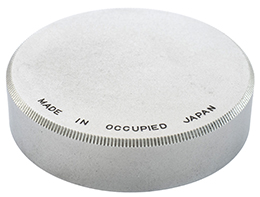

In my database, there are a few Canon S II examples marked MIOJ starting from serial number 1610x onward with increasing frequency until, after 2021x, it is nearly all examples. There are the odd ones without it, perhaps destined for domestic consumption, and/or possibly, there has been some swapping of base plates. Most Canon II Bs have the marking up to and including 38944. From 39333 onward, none have the marking and like all Canon examples before MIOJ was introduced, there is nothing to indicate country of origin until late Canon III and all III-A examples have “Japan” engraved on the top plate. A few of those also have “Made in Japan” engraved on the bottom plate, a practice that seemed very short-lived. Top and bottom plates of same camera:
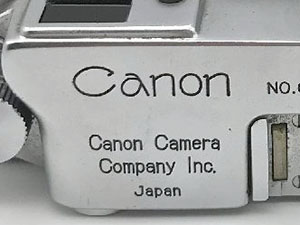
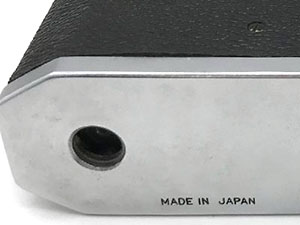
(Detail from larger web images)
From then on, “Japan” remained on the top plate, or back of top plate for Series V and VI models, until and including the Canon P. Series 7 models changed to “Made in Japan”, still on the back of the top plate. Canon L2 on left and Canon 7 on right:
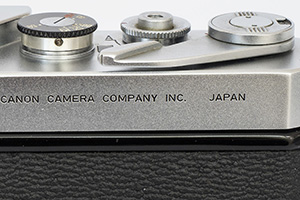
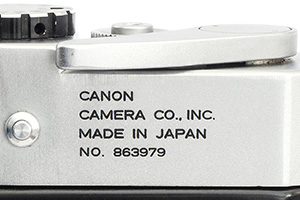
<CPO> Mark
Cameras sold to occupation forces, typically, but not only, through US Military Exchange stores (see <EP> Mark below), were not subject to the high taxes applied to post-War domestic Japanese consumption and in order to control those sales to prevent a black market developing with consequent loss of revenue to the Japanese Government, cameras and some other goods (accessory lenses, binoculars and porcelain have been identified) destined for the stores were marked with a diamond and inside that, the letters <CPO> standing for Central Purchasing Office, later changing to their Japanese katakana equivalent, <シーピーオー>, so that it was understandable to the Japanese population.
Note: Peter Dechert referred to the Japanese version as an “ideogram” and this has been repeated by many people and websites. This is incorrect. The Japanese language has three sets of characters, hiragana, katakana and kanji. Kanji is based on Chinese characters where each character has a particular meaning. It is the only form which is an ideogram. Both hiragana and katakana represent phonetic sounds and are NOT ideograms. The katakana characters in the mark represent the sounds; “shee” (シ), “pee” (ピ) and “oh” (オ), each followed by a dash, or hyphen.
Camera-wiki.org tells us that the use of the <CPO> mark started in 1948, or 1949. In the Notes at the bottom of the page are these quotes from a 23 November 1948 General HQ, Far East Command (GHQ, FEC) letter:
“The Central Purchasing Office is established as a special staff section of General Headquarters, Far East Command, for the purpose of purchasing indigenous Japanese merchandise for resale to the Post Exchange type systems of the Allied Occupation Forces”. And “All CPO marked merchandise found in the possession of other than Allied personnel will be confiscated.”
I think that Camera-wiki.org has based its start date estimate on the date of that letter but to me, it is a statement of fact, not necessarily a notice of introduction, or implementation. The found cameras and lenses suggest that the requirement was introduced in 1947.
Chapter 3 of the Volume 1 Supplement to the Reports of General MacArthur published by Department of Army tells us that FEC had been established on 1 January 1947 as a reorganisation of the earlier AFPAC (see MIOJ above) and General MacArthur's title changed from CINCAFPAC to CINCFE (Commander-in-Chief, Far East). GHQ, FEC (and GHQ, AFPAC beforehand) and GHQ, SCAP were physically combined. General MacArthur was two-hatted; as SCAP, his responsibility was limited to Japan, but as CICFE, he was responsible for all US Army Forces in the Pacific. An organisation chart locates the Central Purchasing Office within the Administrative and Executive Group of FEC. As I understand it, FEC also provided support to SCAP.
Canon put the mark on its camera base plates and the bottom of camera and lens cases (see MIOJ above), typical <CPO> shown on left and red <シーピーオー> on right. The earliest CPO mark is in red as are more than 50% of the katakana marks. I believe that the red infill was applied over black, with wear and time, it is likely that all of the black ones were originally red:
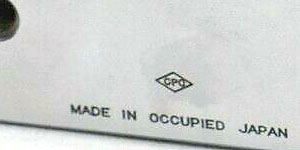

(Detail from larger web images)
The bodies of lenses not sold as part of the standard camera package were also marked. According to Peter Kitchingman, the <CPO> mark on lenses was introduced in October, or November 1947. Below are two Canon Camera Co. Serenar 13.5 cm f/4 lenses, both Peter Kitchingman's Type 7. Both marks have remnants of red infill, difficult to see. The serial numbers are only a few hundred apart, 34209 on the left which has a <CPO> mark and 34703 on the right with a <シーピーオー> mark:
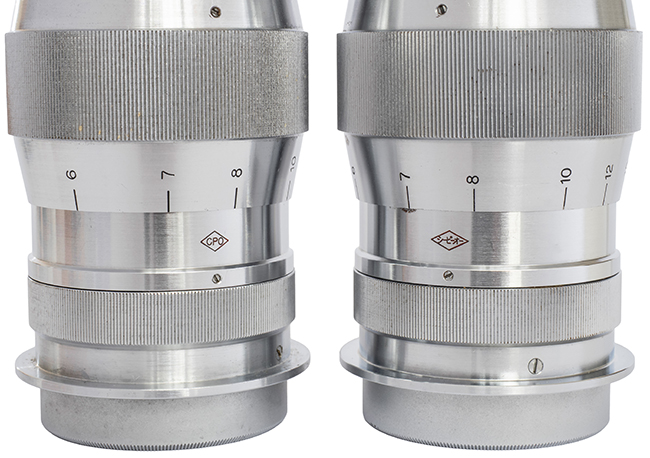
As Type 7 lenses ran from the beginning of January 1948 until the end of March 1949, and the range was from 31547 (found) to 34754, roughly 3,000 lenses, or 200 per month, you could guess that the right lens was from March 1949 and therefore the left lens might be from January 1949. So based on these two lenses, the changeover from <CPO> to <シーピーオー> probably occurred in the January to March 1949 period. Peter Kitchingman seems uncertain of how long <シーピーオー> lasted but certainly seems to believe that it ended before 1950. I agree that it seemed to end in late 1949, perhaps because SCAP was handing power and responsibilities back to the Japanese.
Cameras with removable base plates are more difficult to place because no doubt some swapping does occur. Also, as noted elsewhere, according to Hayato Ueyama, Canon subcontracted engraving to a number of suppliers and there are anomalies with the order of Canon S II models caused by some being returned slower than others. The earliest Canon camera in my database with the mark and serial number visible is Canon S II 1802x with the already later katakana <シーピーオー> version - that one is unlikely to be an original base plate. Next are late Canon S II examples from perhaps the end of 1948, beginning of 1949 with serial numbers 2237x and 2279x with <CPO> marks and 2265x with a <シーピーオー> version sandwiched in between and another immediately following this group, by now it should be the correct type. The katakana <シーピーオー> mark appears on a number of early Canon II Bs, the last example being camera 2936x, almost certainly from before the end of 1949. The cameras in my Nicca database are also of the katakana type and span from the end of 1948 to 1949, however, my Minolta 35 database is more interesting. I have details of five early cameras with the earlier <CPO> mark. The earliest of these are three Model A, type b examples which are undoubtedly from 1947 based on the many claims that the Minolta 35 was introduced in May 1947. That would make the start of the scheme at least 12 months earlier than the 1948-1949 claimed by Camera-wiki.org and maybe earlier than Peter Kitchingman's estimate. Then there are another 6 katakana types in the period from late 1948 to 1949 but none later, just like the other camera brands.
<EP> Mark
In 1953, a new <EP> mark was introduced for similar purposes, presumably by the Japanese Government, i.e. the mark indicates that the item was sold without excise tax being paid and is not available to Japanese consumers (or non-eligible foreigners). Items found with the mark include cameras, accessory lenses, binoculars and 1960s and 1970s hifi gear. Items so marked have commonly been claimed to have been purchased in US military Exchange stores located in Japan and on the weight of evidence, that seems to be correct. There have also been claims that some could have been sold outside the US Exchange system in Japan and other claims that <EP> marked items were sold in US Exchange stores throughout the World. None of these have been verifiable and I think that the World-wide sales claim particularly is very unlikely to be correct.
Incredibly, the mark was in use for at least 29 years (1953 to 1982, see below), yet the only concrete information I have seen about it is the existence of the mark itself, the fact that it was found only/predominantly on items sold tax free by Military Exchange stores in Japan and a document which purports to be a translated Nippon Kogaku (Nikon) notification (instruction) update for engraving the mark issued in July 1960. This document was noticed by contributor Chris Whelan on a Nikon Facebook group, top half shown (rest refers to binoculars and the <EP> engraving itself, for the “T” mark, see Canon's “TE” mark further below):
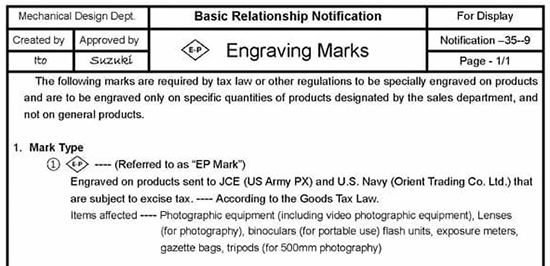
The original poster cannot remember where he found the document but has provided a copy of the original in Japanese:

For the <EP> mark, the relevant words are:
“Engraved on products sent to JCE (US Army PX) and U.S. Navy (Orient Trading Co. Ltd.) that are subject to excise tax --- according to the Goods Tax Law. Items affected --- photographic equipment (including video photographic equipment), lenses (for photography), binoculars (for portable use), flash units, exposure meters, gazette bags, tripods (for 500mm photography).”
(Note, “video photographic equipment” is presumably a modern mis-translation of cine equipment.)
My interpretation is that the specified items sent by Nippon Kogaku to Army and Navy Exchange stores, either directly, or through an intermediary, are to be engraved with the <EP> mark in accordance with with the Japanese Goods Tax Law, i.e. the requirement applies to goods sold through US military Exchanges in Japan only.
The US Exchange stores are typically Army Post Exchange (PX), Navy Exchange (NEX), Air Force Base Exchange (BX) and Marine Corps Exchange (MCX), but Army and Air Force Exchanges are run by the same organisation and Navy and Marine Corps are both Department of Navy and their Exchange stores are named according to whether ship, or whose base. The important thing to note here is that the Army PX has no more precedence than the others and the widely reported belief that “EP” stands for “Exchange Post”, which is Post Exchange backward, doesen't really make sense on any logical level, nor have I seen any evidence to support it.
The exact meaning of the abbreviation seems to have been lost in the mists of time. The suggestions that it is “Exchange Purchase”, or “Exchange Product”, seem more plausible. Others focus on the tax status with examples such as “Exempt Purchase”, “Exempt Product”, “Export Product” and “Export Permitted”.
Contributor Chris Whelan was stationed at a US Naval base in Japan in the late 1970s, by then the system had probably been phased out, he thought, because the mark didn't appear on any of the photographic, or HiFi, items he bought, but see below. He's of the understanding that the <EP> mark stood for either “Exempt Purchase”, or perhaps “Exempt Product”.
Camera-wiki.org claims that it started in 1948 (confused with CPO mark?) and was phased out starting from 1955 as inventories were sold off, but “was applied until the early 1970s”, none of which make much sense to me and seems to be just plain incorrect. The mark does not appear on Canon, or other brand cameras I have collected information on, before 1953 and that is consistent with other sources. My Yashica TLR website notes quite a few 1960's Yashica cameras and two from as late as 1976 and 1977 with the marks and the latest Canon rangefinder I have found is a latish 7s. A member of the Canon Historical Society posted photos of his Canon EF SLR, released in 1973, with the mark and another noted his purchase of a Canon F-1 in Okinawa. More recently, a Canon FD 50 mm f/1.4 lens was listed on eBay with the mark on the rear of the lens next to the Canon date code which indicates 1982:
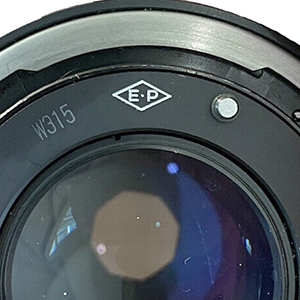 (Web image)
(Web image)
Given Wikipedia's comments, Chris Whelan's experience and the diminishing numbers of Canon cameras with the mark from 1956 onward, it may be that the system was indeed phased out gradually but retained much longer for some special circumstances.
Typical of the Canon Series IV to VI models on left, typical of Series 7 models on right:
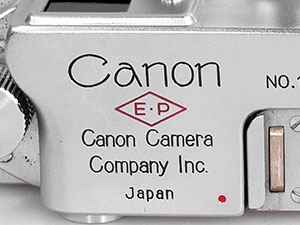
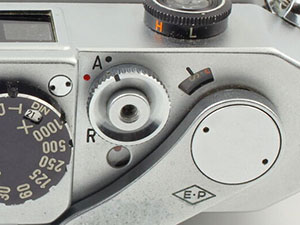
(Detail from larger web images)
Note, the mark on Canon, Minolta, Nicca and most marked cameras includes a central dot between the “E” and the “P”, peculiarly, Yashica cameras omitted the dot from 1953 until at least 1960.
As I have already noted, the <EP> mark first appeared on Canon cameras in 1953. The first Canon IV-Sb example in my database is 12013x after which almost 50% of that model have the mark. No Canon II-D model (or II-D1, or later II-D2) in my database has the mark. Some claim that the Canon II-F was only sold through Exchange stores - that may be close to being correct. There is no mark on the first 1953 cameras from 9817x to 10777x then most have the mark with only the odd exception, my 149293 being one exception. By the IV-Sb2, the incidence of the mark as a proportion of overall production was diminishing as Canon's exports to overseas markets was increasing and from the VT on, they only appear infrequently.
Other Markings
Apart from the mandated markings, small numbers of some models were produced with customer requested markings, or in one case Canon's own commemorative insignia.
After the Hansa Canon, the first known special marking was the War-time Canon S with Imperial Japanese Navy engraving and serial numbers, see Canon S below for details and photo.
In 1950, the U.S. Army Signal Corps purchased a very small number of Canon II B cameras and lenses (Peter Kitchingman has recorded three 135 mm f/4 and one 100 mm f/4 lens) which are engraved “U.S. ARMY Signal Corps”. There was a slightly larger and better known acquisition of Canon III-A cameras and lenses in 1952 which are engraved “U.S. ARMY. SIGNAL CORPS”.
Cherry Blossom, or Sakura
There were later cameras, most commonly the Canon P, marked with what is believed (but not confirmed) to be the cherry blossom logo of the Japan Self-Defense Force on the top plate in red, or less often in black, below left, and on the right, the version claimed to belong to the Japan Maritime Self-Defence Force complete with presumably a sequence number of some sort - this is the only one I have seen, maybe real, maybe not (although I have seen a similar, but not the same, unnumbered logo in white on a make-believe green painted fantasy P):

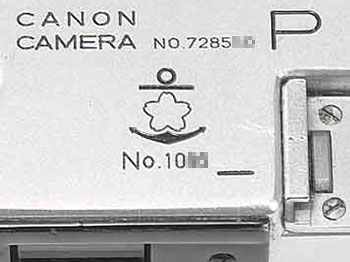
(Detail from larger web images)
The logo is also referred to as “Sakura” meaning cherry blossom in Japanese.
Canon Eagle
Canon P cameras are also found in small numbers with a Canon eagle engraving. This was to commemorate the 1962 25th anniversary of the establishment of Seiki Kogaku Kogyo Kabushiki Kaisha (Precision Optical Industry, Co., Ltd.) in 1937. According to Peter Dechert, these cameras were only made available to Canon employees:
 (Detail from web image)
(Detail from web image)
With all the engraving types, if there is money to be made from adding perceived value, you can be fairly certain that there will be forgeries. The anniversary eagle seems to be one of the more lucrative and great care is needed if seeking to buy one. Obvious deficiencies found with fakes include incorrect eye detail and the missing vertical line delineating the beak from the head. Also, low serial numbers are an issue. Canon P production was from 1958 to 1961 so it seems likely that engraved cameras will be from towards the end.
TE
Some Canon Ps have a “TE” in a rectangular box marking in their accessory shoes. These seem to appear in the last 1/3 of production, probably from sometime in 1960 onward:
 (Web image)
(Web image)

(Image courtesy of Bruce Thomas)
Although the mark has been found on mainly Canon P cameras, it has been found on the bottom mounted film wind lever of at least three Canonflex RP examples that I have seen photos of and there are claims of at least 10 others being counted. Released in September 1960, the RP is from a similar period as the found P examples:

(Image courtesy of Bruce Thomas)
As far as I am aware, little substantive is known about the origin of these. One theory is that it is the initials of some unknown company, organisation, or group. I doubt that is likely, I've seen at least half a dozen without looking too hard and a respected collector in the Canon Historical Society Facebook Group has recorded at least 28 Canon P examples with the mark - that means that there would have been quite a few made, far more than likely for any organisation and only one brand and two models at that. Another theory is that TE stands for “Tax Exempt”. Whilst clearly it is not a form of the <EP> mark, which continued unchanged through the 1970s to at least 1982, it could have had a different use case, or even have been applicable to some other jurisdiction, such as Hong Kong, popular with international tourists, but again, if it was a formal scheme, why was it only found on one brand?
In fact in one case, Hong Kong and duty free shopping are definitely linked to the mark, but not in an obvious way and not limited to Hong Kong. According to contributor Bruce Thomas, the above Canonflex RP was purchased in 1961 from a duty free store at Kai Tak International Airport in Hong Kong. The store had been opened by two Americans in November 1960 and later became the large Worldwide chain, Duty Free Shoppers.
Based on my research, with the assistance of contributor Chris Whelan, I do agree that the mark very likely stands for “Tax Exempt” and that it is related to tax free purchases by tourists but also that the marking of cameras was not mandated and was an informal arrangement managed by camera makers themselves for their own purposes, i.e., if a mark was used, different brands used different marks. For evidence, we have to look to several other brands from the early 1960s.
At the time, the Japanese Government operated a tax exemption scheme for tourists. Whilst there was no broad based commodity tax, there were narrowly focused sales taxes on certain items (a Japanese forum participant recalled these to be a tax imposed on luxury goods, the rates varying depending on item). Based on period price lists, the tax on cameras and lenses was around 10-11%. Duty free shopping was in its infancy Worldwide and in Japan, it seemed to be available at a number of licensed camera stores (I'm aware of one chain in Tokyo and one in Kyoto, neither mention airport outlets). The first example is an item sold at one of these stores and is relevant as background for the second example. It is a “TAX EXEMPTED MUTSUMIDO” label on a Nikkor 300 mm f4.5 lens released in 1964. Mutsumido was a Japanese camera chain with three stores in Tokyo which sold a number of popular brands of cameras, including Canon, so it is also possible to find Canon gear with similar stickers:
 (Detail from web image)
(Detail from web image)
The second example is part of the back page and cover of a 1961 Mutsumido brochure which explains how the government sponsored scheme worked:

This was clearly a retail store managed process but at the factory level, even though it was not required by law, Nippon Kogaku in the early 1960s managed “traveler duty free” items with a “T” engraving. The reference to “damage” in the the “T Mark” description, which continues on from the 1960 EP mark notification translation further above, suggests to me that it may have been for warranty purposes, possibly because warranties were normally managed by distributors in the country of sale but they would have to cover these cameras as well:

The “T Mark” has been found in small numbers on the rewind crank knob of Nikon SP and S4 rangefinder cameras and the early Nikon F SLR. Below are a Nikon S4 and Nikon F:

(Image courtesy of Bruce Thomas)
Contributor Chris Whelan has sent me details of what might be a similar mark on Asahi Pentax cameras. This is a “NO TAX” marking on the back left hand side edge of the bottom plate of an Asahi Pentax SV camera released in 1962 :

Other such markings have been recorded on Pentax SVs and apparently on earlier S2/H2 (released in 1959) and S3 models, and no, it's not a substitute for the <EP> mark which on SVs is usually found on the back edge of the film wind lever.
Interestingly, a 1971 Yokohama Camera Co., Ltd. catalogue confirms that at some point, the Japanese tourist tax exemption was extended to the merchant marine as well:

(Image courtesy of Chris Whelan)
By this time, there is no evidence of cameras being physically marked, that only seems to have lasted for a couple of years at the most; Canon from mid-1960 to June 1961 (release of the Canon 7), Nippon Kogaku from probably 1959 to the end of 1960 (based on 13 examples) and Asahi Optical Co. (AOC) a bit longer to at least 1962. Nippon Kogaku, or AOC, may have been the first and the other two followed suit. We know part of the reasoning behind Nippon Kogaku's “T” mark. Whilst only circumstantial, the timing and naming of Canon's “TE” and AOC's “No Tax” marks suggest that the purpose was broadly similar. I have not managed to find any evidence of similar markings on other brand cameras.
Canon Serial No.s & Naming Conventions
Some Canon models feature model names marked on the body but more don't. Canon serial numbers will get you to the correct series of models and even the correct model before serial number 52000 in 1951 or after 700000 in 1959. In the middle period range, you will also have to identify the camera's features against the specs listed further below.
Pacific Rim Camera have made the process easy with their Canon Rangefinder Identification Guide based on a question and answer process. There are other sites which have either borrowed it, or use a similar approach. “Naming Schema & Model Identification” after “Serial Numbering” below may not be as intuitive but it should get you to the right model, or close enough to confirm from more detailed information further down.
Serial Numbering
Peter Dechert tells us that the only way to identify the production order of the Hansa Canon/ Canon Original is by the lens mount serial numbers, the internally stamped 4 digit numbers on the base plate indicating design types; 1xxx, 2xxx, or 3xxx (see Hansa Canon & Canon Original). Whilst they may indicate design types, they are also Seiki Kogaku's serial numbers, but there's the obvious problem of the base plates getting swapped around. Japanese authors Hayato Ueyama and Kannonji Makoto note the issues and agree that both lens mounts and base plates were supplied wildly out of order, sometimes because of lens mounts needing rework, or base plates not fitting particular batches of cameras. However, they seem to prefer the base plate numbers. A wise person would consider both numbers and then date the camera relative to others by its particular set of variable design elements instead. I think that at least one of the authors also said something similar.
The next model was the Canon S but I'll come back to it. The Canon J, JS and J II had their own 4 digit serial numbers, the J and JS sharing one range and the J II with its own unique range.
The common style of serial numbers began with the Canon S model which used a 5 digit number starting with 10xxx. Peter Dechert says from 10520. These continued consecutively ever upward. When a new model was released, it was easy because even if production overlapped, up to a point in the numbering, all the cameras were one model, all numbers past that were the next model, usually with a small gap of unused numbers in between. According to Peter Dechert, there is a slight overlap at the end of the Canon S II and the beginning of the Canon II B, but so far, I haven't observed examples of either model in this range. However, that changed in early 1951 when the Canon II-C was released as a cheaper version of the Canon III and both shared the same serial number range starting from 52000. That was the first of many instances. There was no duplication but whilst a serial number remained a good indicator of relative ages of cameras, it could no longer assist with identifying the model, not till much later anyway.
One advantage for the company was that the same pool of pre-engraved viewfinder/rangefinder covers (top plates of later models) could be used for any of the models in production.
Some time in probably 1953, the serial numbers clicked over to 6 digits as 100000 was passed. In 1955, they reached around 229000 at the end of the Leica inspired models. The launch of the Canon VT at the beginning of V series cameras restarted numbering at 500000, Peter Dechert says VT production was numbered from 500010 on, but the system remained similar where a serial number could belong to any of several contemporary models but it was a little more complicated because there were differences in top plates, e.g. between knob wind and crank wind models, and even though numbers seem to overlap, they appear to have been issued in blocks so are not such a good indicator of relative age between cameras of different models, only within models. V series cameras continued until 1958 and ended at about serial 592000.
The Canon VI-T and VI-L launched in 1958 with serial numbering nominally starting at 600000 with both models using the same block. They ended at about 620000 and 621000 respectively. However, when the Canon P, a simplified VI-L, launched in 1959, the starting serial number was reset to 700000 and from that point, all models used a discreet block. The Canon P ended at 798000, the Canon 7 ranged from 800000 to 999000 and the Canon 7s turned back the clock to restart with 6 digit serial number 100000. This ended at about 123000 (last found is 123001). The 7sZ is an unofficial model first named that by Peter Dechert to identify late examples with an updated feature set. There was a transition period from 115000 to 118000 during which examples with either feature set, or with only half the feature set, can be found.
Naming Schema & Model Identification
Whilst Canon's naming schema seems to to be chaotic, it does sort of make sense. This might also be the point to note that I'm not altogether comfortable with Peter Dechert's practice for identifying variations as models and giving them their own model names; Canon 1950, VT de luxe Z, VT de luxe M and Canon 7sZ. It may be clever from a collector's point of view but it rewrites Canon's history.
Bottom Loading Knob Wind Models
Pre-War Designs: Seiki Kogaku called the Hansa Canon/Canon Original “Canon Standard Model”. This featured a frame counter on the front, a pop-up viewfinder and a bayonet mount lens in a fixed focusing mount. The Canon S added slow speeds and moved the frame counter to under the rewind knob. Before the War, it was known as the “Canon Newest Model”. When production of the Hansa Canon ceased in 1940, the Canon Newest Model, became the new Canon Standard Model, a title first briefly held by the short-lived Canon NS - with popular usage of the “model S” abbreviation, that name stuck after the War. Similarly, the model that became known as the Canon J was initially called “Canon Popular Model”. It had no rangefinder and a screw mount lens. Some initial orders referred to “Junior Canon” and from that, “J” for junior became accepted. Variations included the Canon NS which was an S without slow speeds (NS, “New Standard” because both it and the Hansa were without slow speeds) and the Canon JS which was a J with slow speeds added. The J II arose from War-time shortages and was a J typically using a Canon S body with blanked off slow speeds and an S rangefinder cover pressing without the rangefinder.
Series II (from 1946): These are the first post-War designs and feature a combined viewfinder/rangefinder window. Top speed is still 1/500 with shutter dial split at 1/20. There are only two models, the Canon S II and II B with variable magnification viewfinder.
Series III (from 1951): Shutter dial split now at 1/25, the top models, the Canon III and Canon III-A featured the new top speed of 1/1000. The III-A added a new one piece magnification lever and film reminder in the rewind knob. The Roman II would be used until 1955 and then, from 1956, the Arabic 2 to denote lesser variants with 1/500 top speed. The budget model Canon II-C had the same features as the Canon III, except the top speed remained 1/500.
Series IV (from 1951): Flash sync via side rail added to top models Canon IV, IV-F, IV-S, IV-Sb (IV-S2 in some markets, the “b” signifying the addition of X sync) and IV-Sb2 (the “2” signifying new shutter with 2 piece dial and 1/30 speed split). Lesser II variants included the Canon II-A (no sync or slow speeds), II-AF (FP sync only, no slow speeds), II-AX (X sync only, no slow speeds), II-D and II-D1 (slow speeds, no sync), II-F (slow speeds, FP sync only) and II-S (slow speeds, slow speed sync, high speed sync and X sync). There were also “2” versions; II-D2, II-F2 and II-S2.
Hinged Back, Trigger or Lever Wind
Series V (from 1956): The Canon VT was initially advertised as the “Canon Model V”, undoubtedly the V meaning 5. However, the way the names developed, if a “V” is in the name, it means self-timer, not simply Series V (“V” stands for the German “Vorlaufwerk” meaning self-timer, e.g. Compur MXV and Prontor SV shutters). “T” means trigger wind and “L” means lever wind - top models included Canon VT, VT de luxe, L1 and VL, the L1 not featuring a self-timer. A “2” in the name signified a top speed of 1/500 and and pop-up rewind knob instead of crank (except in the case of the VT which pioneered the pop-up rewind knob), some didn't have X sync and some did, e.g. L2 and VL-2 respectively. The one “3” model, the L3 was the L2 without any flash sync at all (except sometimes, see Canon L3).
Series VI (from 1958): Series VI is in the name of both the Canon VI-T and VI-L, the first with trigger, the second with lever. These introduced a single non-rotating shutter dial, parallax corrected reflected frame lines and auto frame counter reset. The 1959 Canon P (also known as “Populaire”) was a simplified VI-L:
Series 7 (from 1961): The Canon 7 incorporates an in-built selenium cell exposure meter, projected frame lines and an external bayonet on the lens mount. The Canon 7s replaced the exposure meter with a CdS version and added back the missing accessory shoe. The 7s7 (not an official Canon model) features an improved viewfinder and larger rewind knob.
Marked Model Names
More models don't than do have their names marked on the body. The following are the Canon cameras that have them, however, note that some models only feature them for the first or last part of their production runs:
Bottom Loading Knob Wind Models
(Note, earlier cameras don't have marked model names but whilst I don't have any idea about the Canon II-A, II-AF, II-AX or II-D1 models from a similar time as the cameras noted below, Peter Dechert doesn't include them either.)
The Canon IV, IV F, IV S, IV-Sb/IV-S2 and the IV-Sb2 and IV-Sb2 derivatives with the new shutter do not have their names marked.
Bottom loading cameras that have marked names have them on the bottom of the shutter crate like this Canon II-F:
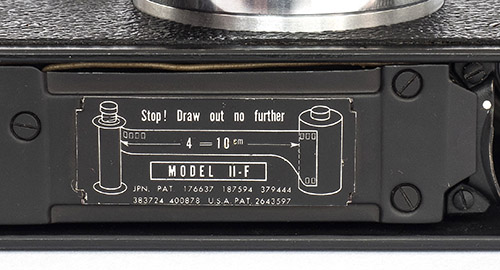
Canon II-D: No name inside up to serial no. 11399x, then all have “MODEL II-D”from serial no. 11498x on.
Canon II-F: No name inside up to serial no. 12704x, then all have “MODEL II-F” from serial no. 13991x onward (in between those numbers is a cross over period where both types are found).
Canon II-S: Serial no. 10826x doesn't have the name inside, serial no. 11327x and later cameras have “MODEL II-S”.
Hinged Back, Trigger or Lever Wind
Canon VT: “MODEL VT” on front face of base plate.
Canon L2: “MODEL L2” on bottom of
base plate.
Canon L1: “MODEL L1” on bottom of
base plate, in red on earliest example 54xxxx.
Canon VT de luxe: “MODEL VT de luxe” on front face of
base plate, in red on earliest examples 54011x, 54074x and 54126x I have found and in black from 54245x.
Canon L3: “MODEL L3” on bottom of
base plate up to serial no. 53734x, no name after serial no. 53797x.
Canon VI-T: “MODEL VI-T” on front face of base plate.
Canon P: “P” on top of top plate.
Canon 7: “Canon 7” on top of top plate.
Canon 7s: “Canon 7s” on top of top plate.
Canon Rangefinder Body Dimensions
The Canon History Museum gives dimensions and weights of each model but the problem is that it is very inconsistent. Quite obviously, the Museum changes the rules about what is being measured with each model without telling us what is included and sometimes lenses are included and sometimes not. Personally, I think small protuberances like slow speed dials and strap lugs are inconsequential, I'm more interested in the footprint, basically the length and width of the base plate and the height of a camera and that is consistent with my other Leica Copies Japan pages. The dimensions and bare body weights are listed further down.
The four cameras below represent the two basic generations of post-War bodies; the bottom loaders and the the hinged backs. Top to bottom; Canon II B, Canon II-F (same body as IV-Sb), Canon L2 and Canon 7. The top two have the same footprint and the bottom two the same slightly larger footprint (5 mm longer):
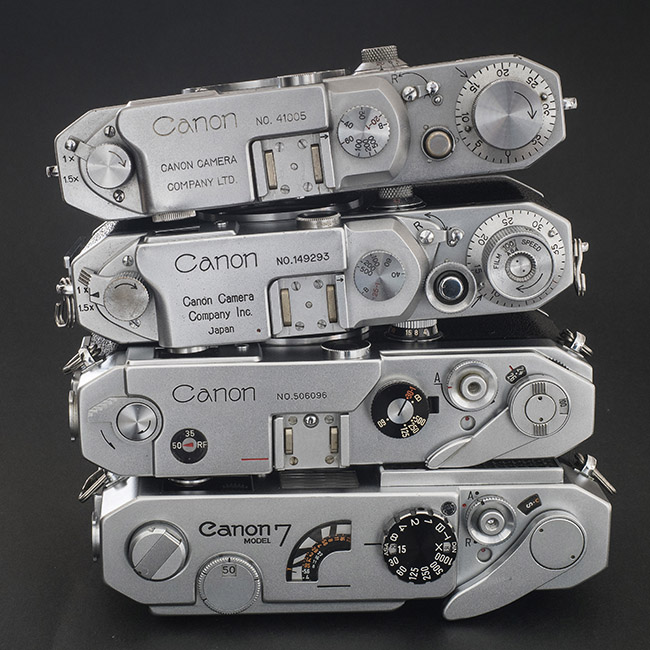
Canon II B on left, Canon 7 on right:
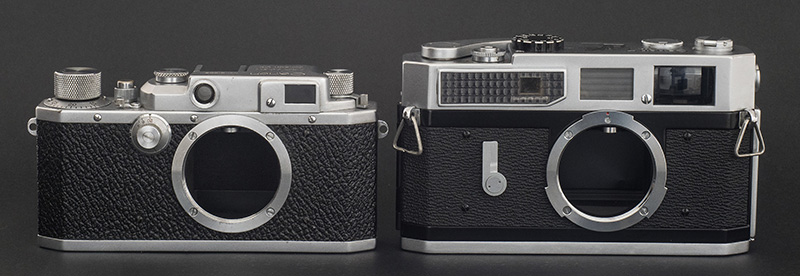
Canon L2 on left, Canon 7 on right. Lever wind models up to and including the Canon P are the same height as the Canon L2, the Canon VT and other trigger wind models are the same height as the Canon 7:
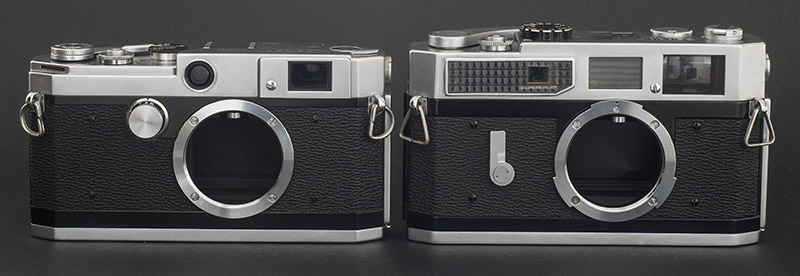
| Camera | Base Plate | Height | Weight | |
|---|---|---|---|---|
Length |
Width |
|||
Leica II/III |
133mm |
67mm |
406g |
|
Leica IIIc/IIIf |
135mm |
30mm |
69mm |
425/430g |
Canon S II |
135mm |
30mm |
69.5mm |
|
Canon II B |
135mm |
30mm |
71.5mm |
|
Canon III to IV-Sb2 |
135mm |
30mm |
72.2mm |
500g |
Canon VT to VI-T |
140mm |
31mm |
81mm |
|
Canon L1 to P |
140mm |
31mm |
76mm |
530g (L1-3) |
Canon 7 |
140mm |
31mm |
81mm |
670g |
Canon 7s/7sZ |
140mm |
31mm |
81mm |
630g |
The earlier model dimension from Hansa Canon to Canon S I are quoted within .05mm to 1 mm of the 1946 Canon S II and I suspect that the base plate dimensions are identical. As far as I can tell, I don't think that the basic body grew in this time except that the Canon S II seems to be 0.5 mm taller with its new single window viewfinder/rangefinder .
The Canon Rangefinder EBL
Rangefinder accuracy is critical to obtaining sharp in-focus images. With smaller apertures and shorter focal lengths there is greater depth of field (DoF) and it is less important but as apertures and/or focal lengths increase, particularly at shorter camera to subject distances, DoF becomes razor thin and there is little margin for error.
Rangefinder accuracy is determined by “effective base length” (EBL), the longer the better. EBL = base length x magnification. Canon rangefinders are a bit short in this regard, particularly the Canon P but also the Canon 7 series with its optional f/0.95 lens. The models with variable magnification have a respectable EBL but only at the 1.5x setting. Whilst you can focus using any of the positions, depending on DoF, switching to the 1.5x view to focus accurately and back again to recompose might be a bit inconvenient but whether it is better or worse than switching between eyepieces on a Leica III and similar cameras is a matter of personal preference and use case. However, best practice was to have a long base, combined viewfinder/rangefinder and a big viewfinder that did not require positive magnification to achieve accuracy, the best camera EBLs include Kiev 4 at 72 mm, Contax II & III at 67.8 mm, Leica M3 at 62.33 mm and Nikon S2 and later at 60 mm.
For the record, Leica III models have a 39 mm base and a rangefinder magnification of 1.5 times giving an EBL of 58.5 mm. Official and/or confirmed details of Canon EBLs are hard to find but this is what I know:
- Canon S II: Base length 38.5 mm, magnification 0.6x, EBL = 23.1 mm
- Canon II B: Only magnification is known, I'm guessing base length is the same 38.5 mm. At magnification 0.67x (F position, or 50 mm lens view), EBL = 25.8 mm. At 1x (100 mm lens view), EBL = 38.5 mm. At 1.5x (135 mm lens view and accurate focusing position), EBL = 57.75 mm.
- Series III and IV: The magnification is unchanged, the base length may be the same as the S II in which case the EBLs are the same as for the II B.
- Series V: Note, the Canon Camera Museum quotes a base length of 43 mm for both Series V and VI models but Internet references quote 41 mm for VI, V not mentioned. I'm basing my EBLs on 43 mm for both series but it may or may not be correct. Series V magnification is now 0.4x equating to a 35 mm lens view with EBL = 17.2 mm, 0.72x equating to a 50 mm lens view with EBL = 31 mm and 1.4x for accurate focus purposes only with EBL = 60 mm.
- Series VI, Canon VI-T & VI-L: The magnification has changed again. Magnification is now 0.65x equating to a 35 mm view with EBL = 28 mm, 1x equating to a 50 mm view with EBL = 43 mm and 1.55x with EBL = 65.5 mm.
- Series VI, Canon P: Variable magnification is absent on the Canon P and subsequent Series 7 models. I am assuming the same 43 mm Series VI base length. With 1x magnification, EBL = 43 mm.
- Series 7: Base length is 59 mm, with 0.8x magnification, EBL = 47.2 mm.
Black Bodies
A number of models were also offered with black painted metalwork instead of chrome plated finish. At the time, there was an extra cost and these days, they appear in very limited numbers and bring a significant premium at sales. This of course makes creating fakes a lucrative endeavour but there are also honest vendors that declare that a camera is a repaint and buyers who are willing to pay extra for a black body whether original or not. I'm not an expert in this regard and I would recommend that anyone interested in purchasing an original black body search the Facebook page of the Canon Historical Society first and then ask the forum if still not sure.
Of course, the first black bodies were the renderings of the Kwanon prototypes (not including the possibly earlier chrome version held by Canon). However, there were no black bodied versions of the bottom loaders made for retail sale or known military use.
According to Peter Dechert, the L1 and VT de luxe were the first Canon models offered in black and the Canon 7 was the last. The economy models, the L2, L3 and VL-2 were definitely not available in black. In regard to the VL, Stephen Gandy's Cameraquest site says the following: “Original black paint Canon VL rangefinder, a camera so rare that Peter Dechert had never seen one when he wrote his classic Canon Rangefinder Cameras 1933 to 1968. Apparently a few were produced as samples, but never marketed to the public.” The VL pictured, serial number 560986, appears to be the real deal, matching the obvious original Canon factory specs.
Apparently, until mid-way, or so, through Canon P production, Canon painted the black over the original chrome finish, it is only later Canon P and Canon 7 models which are painted over bare brass. Typically, black camera self-timer levers have a small circular indentation near their tip which is filled in with white paint, chrome cameras have no indentation (or paint). Black cameras also feature both black painted strap lugs and strap hangers. These detail differences are the same for all affected models and are reflected in the chrome Canon P on left, original black Canon P on right:


(Web images)
Note, the strap hangers changed from “D” shaped to triangular. All the black P bodies in my database with strap hangers have the “D” type but there may be later examples with the other, whereas the chrome bodies can have either depending on age. An additional feature with Canon 7 cameras is that the rewind crank handle remains chrome.
Although post 1956 lenses generally trended to predominantly black, Canon did offer special all black versions of three standard lenses for the black bodies. These were the 50 mm f/1.8, 50 mm f/1.2 and the very rare 35 mm f/1.8.
Odd Spec Canon L and VL Cameras
The Canon L3 entry in “The Models” below identifies 14 examples in my database with what is almost certainly factory installed flash sync when the key marketing headline of this model was that it was an “L” model without flash sync. Four of the examples have a 1000 shutter speed instead of 500. Also, the Canon VL entry identifies 5 examples that, on the face of it, appear to be VLs but 4 are outside the serial number range and all have some features/parts from other models, including three with L1 base plates. These may be the tip of the proverbial iceberg.
Canon rangefinder collector Todd Belcher has recorded a number of examples of Canon L (L1, L2 and L3) and VL (VL and VL-2) cameras that don’t comply with Canon’s published model specs of the time, i.e. there is a non-standard mix and match of features. It appears that only these noted model lines are affected, no VT, earlier bottom loading, or later VI, P and 7 series show this variability of feature additions (or subtractions). He notes features like a self-timer, electronic flash synch, metal curtains, 1000 shutter speed, or silver coated optics (cooler colour) may be an unexpected “upgrade” to a particular camera. Many decades and a lifetime later, there is no obvious simple explanation, but Todd has a theory these cameras may have been sold at a reduced price to Canon employees who were allowed to customise their camera from the parts bin. He thinks that with new models on the horizon, there may have been excess parts and camera inventory to clear of the L and VL model lines.
As the only thing that identifies the sync'd L3s is the “L3” base plate, which is only there on the first half of L3 production, and the synch features are a far more substantial differentiator, and likewise, the only reason I identified the odd VLs as VLs was the self-timer lever, it is perhaps best not to try to categorise these cameras into one formally defined model, or another. As Todd has said, they can be a mix of any feature of the L and VL models. There is one example, which is not in my database because the serial number is not visible, which has an L3 base plate, a self-timer and although the sync socket is not visible, it has a sync switch and main shutter dial with X sync and 1000 speed. So is it an L3 or VL? At heart, maybe neither.
The Models
The models are listed in chronological order of release. From an impact perspective, I'm more focused on when they went on sale, based on Canon Camera Museum's “advertised date”, than Peter Dechert's production dates but I have quoted both. Typically, camera makers build up some stock before release and sales continue after production ends until stock is exhausted. When several models were going to be released simultaneously, at least in the same month, it could have been a toss of a coin which would go down the production line first. Clearly though, in a number of cases, the dates are out of step with each other. Canon has made some obvious errors on its Camera Museum site so it's probably Peter Dechert who is more likely to be correct.
Also, Peter Dechert's researched serial numbers are far more meaningful than my relatively small pool of found numbers (circa 1,130 across all models in 2024). However, the found numbers do indicate the spread of the more easily found examples and in several instances, I have found serial numbers slightly outside of his range. I have also included a table of lenses likely supplied as original options with each model and serial numbers found. I have tried to exclude any obvious later swaps and other outliers but this is not definitive nor necessarily accurate. Serial numbers are indicative only and many lenses will lie outside my small sample size range. When numbers fall outside the range, compare to the the previous camera model for lower numbers or the next model for higher numbers. Obviously, body and lens serial numbers do not apply to the Kwanon.
Where I have quoted production numbers, these are Peter Dechert's, unless stated otherwise.
Kwanon (prototype series)
There were a number of different designs of the Kwanon prototype, all fitted with the 50 mm f/3.5 Leitz Elmar-like collapsible lens called “KasyaPa” (identified as a Tessar design in an ad), although it is murky about what was actually built and what were operational or mock-ups. There is the original Leica II like Kwanon X which Canon acknowledges was built by Goro Yoshida but in regard to the advertised versions which led to the Hansa Canon, the History Hall of the Canon Camera Museum tells us that:
“A total of three Kwanon camera variations appeared in ads but the cameras were all either illustrations or wooden models, not actual products. In other words, the “Kwanon” was never actually put on the market. Although Yoshida testified that he had completed ten “Kwanon” cameras, no one had actually seen any one of them.”
Canon doesn't leave much room for doubt about its view. Presumably, that means that people that worked directly with Goro Yoshida hadn't seen them either and that must include Takeo Maeda who became Canon's president in 1974. Any thoughts to the contrary would need some very solid evidence. However, two separate stories may have become conflated. Whilst there is still no evidence of any additional Kwanons being made, Hayato Ueyama tells us (page 30 of his book) that after Goro Yoshida resigned from the Laboratory in late 1934, he set up in the Takeda Building in Kobiki-cho, Kyobashi-ku, Tokyo, where he “prototyped a brother to the Kwanon camera” and that some
The period advertisements show a somewhat Leica II-like black enamelled camera but with the film winding knob unusually placed on the front for the first three versions and no rewind knob, the film was transported from cassette to cassette. The body was hexagonal instead of with rounded ends and this would remain a signature design feature throughout the life of the Canon interchangeable lens rangefinder cameras and into the SLR era. The shutter speeds range followed the typical Leica II progression, Z, 20, 30 40 60 100, 200 and 500. There were no slow speeds. Specific details of the lens mount are unknown so whether it met Leica specifications is also not known, although each of the ads further down claims that “any lens can be attached according to your wishes”, implying some degree of compatibility with interchangeable lenses. It is clearly not a Zeiss Contax mount so Leica (Whitworth 26 TPI) would be presumed but noting Peter Dechert's comments in his book that until 1947, Seiki Kogaku and Nippon Kogaku engineers thought that Leica used a 1 mm metric thread (M39, equivalent to 25.4 TPI), it could have actually been M39.
Hayato Ueyama believes that due to the lack of money, equipment, people and skills, rather than representing separate prototypes, models A through D (A to C appeared in the advertisements) are the same “camera” with some reworked ideas about mainly the viewfinder and concerns about Leica's patents. He also believes that it was a real prototype, but more Leica II than the Contax inspired ads. There is some evidence quoted from people that worked there at the time that at least one body did exist in some form but I'm not convinced about the timing - there must have been a number built between Goro Yoshida departing and the first camera being marketed in the time that Nippon Kogaku was developing the lens and the mount - the first prototype mount took 8 months to complete.
If a prototype camera did exist in some form in mid to late 1934, I don't believe that it is any of the cameras pictured in the ads further below. The two June 1934 Kwanon A images are clearly both illustrations. The July 1934 Asahi Kwanon B is clearly a more sophisticated illustration but not a photo. The Ars Camera version is more life-like and perhaps the only one that is not pure illustration, although that is not certain and at the miniumum, there is artistic touch-up work involved. If a photo is the basis, what was the photo of? Canon says maybe a wooden model. Camera, or model, why didn't it appear in the other ads? The September 1934 Asahi Kwanon C ad is the most telling. Even in its low resolution form, it is clearly based on the same illustration as the July 1934 Asahi Kwanon B ad, only the viewfinder has been changed. The viewpoint, the proportions, the shadows, the “reflections” and the positions of the dials are all identical.
According to Hayato Ueyama, the Kwanon ads were placed by Goro Yoshida without consent being sought from anyone else. To put the timing of these ads into perspective, the Precision Optical Instruments Laboratory was established in November 1933 by some blokes with few skills, not much money, or other resources, and working out of an apartment building and the first ad appeared in June 1934. That's only 7 to 8 months later, a similar time that it later took engineers at Nippon Kogaku to just design the lens mount for the Canon. The last Kwanon ad was in September 1934, only 10 to 11 months after the Laboratory was established. If you believe the ads at face value, you would have the impression that in that time, they had investigated, designed and built prototypes of a camera that was now available to buy and was a cross between a Leica (lens mount, body and rangefinder) and a Contax (shutter), not to mention a self-timer that somehow incorporated slow speeds. In other words, none of the ads implies that it is an announcement for a camera “in development”, or “available soon”, it simply says “here is this remarkable camera and this is the price”.
Each of the ads for the Kwanon A, B and C features the same marketing slogan attributed to Yoshida (note, my app translation of submarine and aeroplane types and my amendment by cross reference to known types may not be accurate, but you get the idea):
“The submarine is I (type)
The plane is Type 92
The camera is KWANON
These are all best in the World”
All the ads also highlight the same 6 features (words and/or translations may vary slightly):
(1) Equipped with automatic focusing (rangefinder). The connection between the lens and the rangefinder is equipped with a steel rod with ball bearings, so there is no need to worry about one spot wearing out quickly.
(2) The rangefinder uses prisms eliminating the risk of double images.
(3) After shooting, there is no need to rewind the film and it can be immediately replaced with a new one.
(4) The self-timer device also serves as a slow shutter.
(5) The Z-type focal plane shutter is made of metal, (see below) so it does not warp in hot or cold, or when it is wet or dry, and is durable.
(6) Any lens can be attached according to your preference.
I can't comment on the focusing, the “rod” confuses me (and Hayato Ueyama too), but the rangefinder seems to be what would be expected. Although we don't know anything concrete about the proposed magazine to magazine system, it is likely that it was inspired by the Contax which could be loaded magazine to magazine, or to a spool and the film rewound at the end (unlike the Kwanon A to C, it had a rewind knob). The Kwanon film magazines likely also followed the Zeiss design which was adopted for the Hansa Canon and following Canon bottom loaders.
However, leaving aside point 6 and the fact that no affordable accessory lenses were being offered or available, two features clearly indicate this is an ambitious laundry list of aspirations rather than reflective of any available camera, or in development by the Laboratory, i.e. it was still at the concept stage. The self-timer, which doubles as a slow shutter and the metal shutter were clearly far in advance of both existing technologies and the Laboratory's capabilities. Regarding the self-timer, when Hayato Ueyama asked Tamotsu Fukazawa, who joined Seiki Kogaku in March 1935, i.e. some 9 months after the first ad, he confirmed that it was the dial in front of the shutter button (when asked many years later, Yoshida apparently couldn't remember it). Relevantly, Hayato Ueyama adds that Tamotsu Fukazawa's work was apparently not influenced by the “black bodied Canons”, i.e. the advertised Kwanons, implying that a line had been drawn earlier on, although clearly, some design elements were retained.
My translate app has trouble with the shutter material, but according to Hayato Ueyama, “it is said to be a metal shutter made of duralumin”, an aluminium alloy containing copper and magnesium. This could not be used for curtains, the metal foil type not appearing until the late 1950s anyway. The “Z-type” is undoubtedly a clue, quite possibly it means “Zeiss type”. Other than curtains and vertically travelling Contax metal slat shutters, there are metal blade type shutters, but the first didn't appear until the 1950s and the first successful one was not until the 1961 Copal Square.
Whilst modern comparisons focus on the simpler Leica II, in the beginning at Roppongi, there certainly seemed to be great admiration for the technically more interesting Contax and the large Carl Zeiss conglomerate generally, e.g. the addition of the front mounted film wind knob and probably the magazine to magazine system. Hayato Ueyama tells the story that shortly after starting at Roppongi, Rentaro Uchida, Saburo Uchida's nephew, dismantled both a Contax I and Leica II, but whilst putting the Leica back together again was straightforward, he had to take the box of Contax parts to the Carl Zeiss facility for reassembly. According to Rentaro Uchida, that is when it was decided to follow the Leica internal design rather than that of the Contax. To me, that suggests that the Contax shutter had indeed been the inspiration, but undoubtedly, no working Kwanon A, B or C could ever have been made incorporating all the advertised features, and clearly, there was much work still to be done between these ads and the first Hansa Canon.
Whilst Peter Dechert simply dismisses some of the features with, “the six numbered claims in the copy include several features which apparently never existed”, I think that misses the question of whether any of these Kwanons existed other than as design ideas. I'm only guessing, but Yoshida's motivation for placing the ads may have been simply to excite market attention to assist with a search for financial backers. Hayato Ueyama quotes several people who expressed frustration at the time with the apparent unavailability of the Kwanon and lack of response to enquiries.
Below is part of a detailed design drawing from a Japanese site, unfortunately of low resolution (the sheet was curved and photographed at an angle, I have sort of straightened it, increased the contrast and upsized it). The heading machine translates to “Kannon Camera Assembly Diagram”. It's not known whether this is a copy of an original, or a more recent depiction, but it clearly features a cassette to cassette film transport system with central tripod socket and it looks like a Leica type viewfinder/rangefinder system so it is undoubtedly depicting either the Kwanon A or B (see further below):
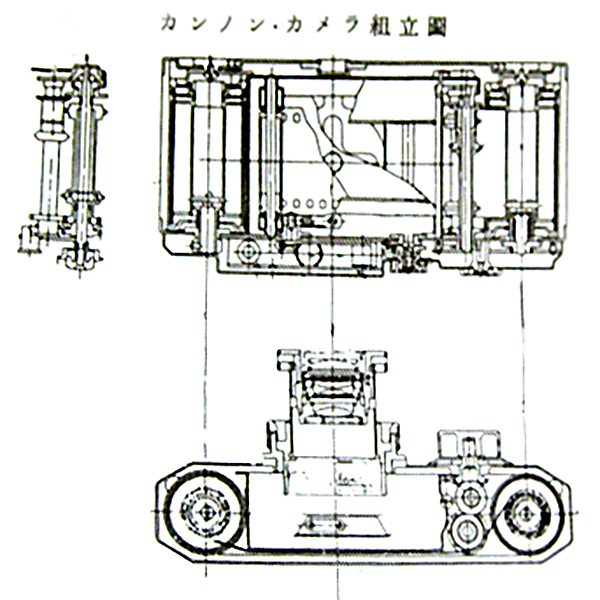
Note, the elevation view is shown upside down. There are also two interesting things to note in relation to the Canon D Replica discussion further below; the centre hole in the pressure plate and back for focus adjustment and the tripod mount is on the lens axis, not in the centre of the bottom plate like the early Hansa Canon. Therefore the Hansa Canon bottom plate is more likely to be an adapted Kwanon design rather than an adapted Kwanon part.
Whilst camera-wiki.org identifies four prototype designs referred to alphabetically as A to D, Peter Dechert refers to three designs, lumping A and B together as the first design, plus a magazine photo which he calls D. There is another quite different one called the “Kwanon X” which is an actual camera which Canon tells us came first. For this section, I am relying on Peter Dechert, Hayato Ueyama, the History Hall of the Canon Camera Museum and camera-wiki.org which references both Dechert and a later 1996 book by Japanese author Yoji Miyazaki, “Canon Rangefinder Camera”. At the end of the list, there is one more camera to consider but my belief is that it is a replica of some sort.
Kwanon X
1933 Kwanon X:
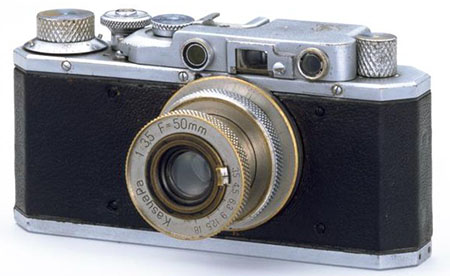
It features the Kwanon name plus the logo depicting the deity on the top plate. On the left is the engraving on the Camera Museum display copy (see camera further below) and on the right is a graphic artist's interpretation on the Canon Global site:
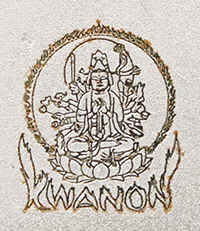
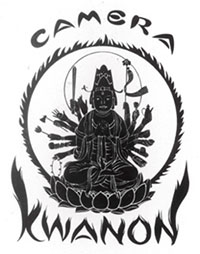
It is unlike either the other Kwanon designs, or the Hansa Canon, or later models. The camera is a close copy of the Leica II but with the distinctive hexagonal body ends of all Canon rangefinder cameras. The lens is engraved “KasyaPa” like the other Kwanon lenses and looks similar to those depicted in illustrations with a knurled focusing ring differentiating it from the Leitz Elmar's finger operated tab with knob.
The History Hall of the Canon Camera Museum tells us:
“When Yoshida made his first prototype camera he named it the Kwanon, after Kannon, the Buddhist goddess of mercy, as he was a Buddhist and an ardent believer in Kannon. The camera’s logo depicted a thousand-arm Kwannon Goddess, and even its lens was named “Kasyapa” which came from Mahakasyapa, a disciple of the Buddha.”
Although Canon dates it to 1934 like the other prototype designs, the Museum description clearly puts this camera before the others. This is Peter Dechert's theory too but he thinks that it could date to as early as 1933 and Hayato Ueyama is unequivocal that it is from 1933 before the Laboratory was established. It shows no influences from the technically superior Contax released in 1932 but by the time of the Kwanon prototypes/concepts, there were clearly aspirations in that direction.
However, there are some that apparently believe that it was assembled from leftover and later parts some time afterwards. Whilst it looks quite presentable in photos, it is described as being crudely made. Certainly, neither the viewfinder, nor viewfinder/rangefinder cover, are “leftover”, or “later”, Canon items.
The provenance of this camera is, according to Peter Dechert, that it was sold by the Shimbido camera shop in Tokyo in 1937 and was bought back by Canon at an Osaka trade fair in the late 1950s. I believe that Canon wouldn't have bought Kwanon X back or featured it so heavily over the years if it had any doubts. Peter Dechert also notes that Takeo Maeda, one of the original founding group and in charge of sales by the early 1960s (president from 1974), used it prominently to promote the Canon 7. For marketing purposes, Canon actually made several reasonably accurate replicas, except for the odd rangefinder windows. One of these is the camera that represents the Kwanon X on the Canon History Museum site (the one at the top of this section is the real one which is the same image used on the Canon Global site, but there, Canon toned down the brassing):
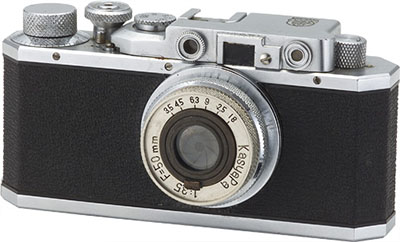
Kwanon A
June 1934 magazine ads, Ars Camera ad on left, Asahi Camera ad on right:
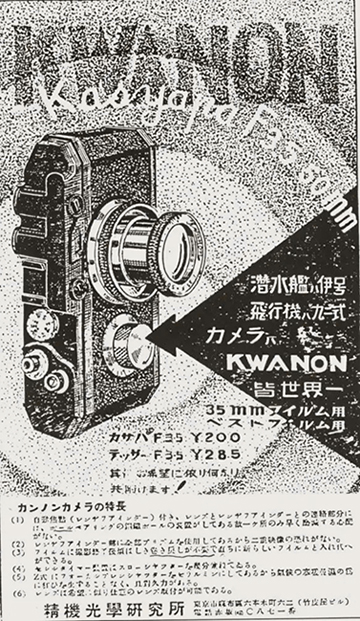
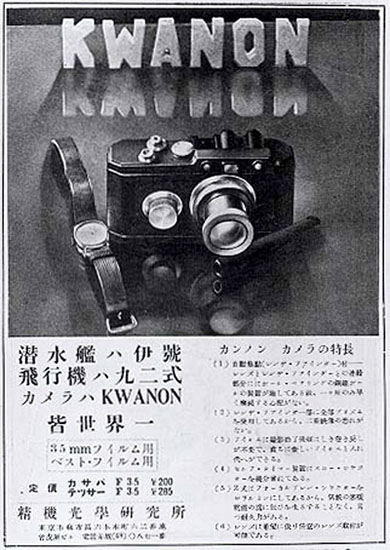
For the first three designs, the film advance and counter are on the front and there is no rewind knob. They all also have the dial in front of the shutter button which is claimed to be the advertised self-timer. The main variation seems to be the viewfinder. This first version depicts a narrow cover over the rangefinder mechanism, a typical centrally placed Leica-like viewfinder window and two tubes running back to the viewfinder and rangefinder eyepieces. There was no top plate engraving.
Kwanon B
The image in the July 1934 magazine ads depicts a very similar camera except that instead of the tubes for the viewfinder and rangefinder eyepieces, there was a more Leica II-like viewfinder/rangefinder cover. Also, the self-timer dial is more resolved and there may be an extra button, or it might be the knob on the end of a black A-R shutter release lever according to Hayato Ueyama - he calls it that several times in his book. The ad on the left is from Ars Camera, on the right from Asahi Camera:
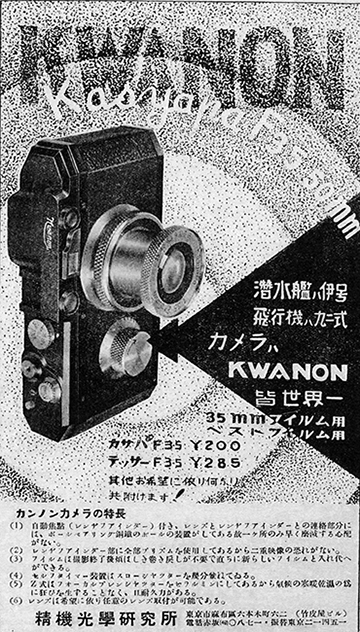
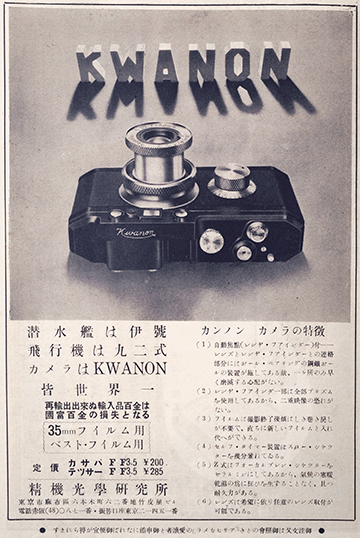
Detail from the first ad of the area behind the self-timer dial. I have lightened the camera detail and at full resolution, it definitely looks like there is a lever to me and what is often assumed to be a button is unquestionably a ribbed knob, but is a release lever needed when film is not going to be rewound in a magazine to magazine system? No other authority that I am aware of has identified it as a lever and knob and Peter Dechert has also simply drawn it as a button. If it is a lever, its purpose may be something else, but what, and on the other hand, Ueyama has spoken to people who were there at the time and that must carry a lot of weight. Also, the Contax allowed either magazine to magazine operation, or magazine to spool - perhaps Yoshida was thinking about either incorporating a similar facility, or abandoning the magazine to magazine system altogether, even though the rewind knob was not yet in evidence:
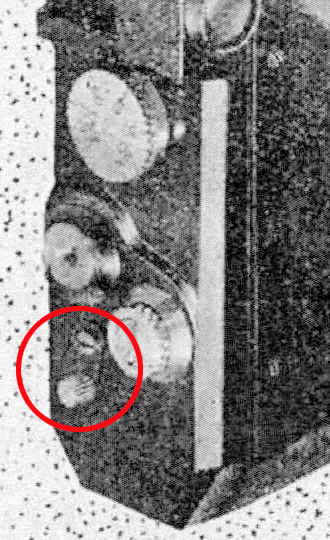
The camera in the second ad looks like more of an artistic interpretation and lacks detail in the shadow area of where the lever might be but the ribbing on the knob is visible:
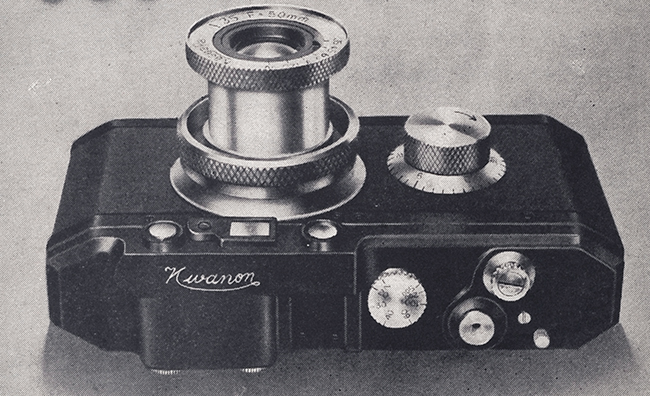
Peter Dechert calls it the final stage of the first design. The Kwanon name with a curved line under was now engraved on the top plate.
Kwanon C
The Asahi Camera September 1934 ad in Hayato Ueyama's book depicts an otherwise similar body (I believe the July 1934 illustration reworked), but significantly, the built-in Leica type viewfinder between the two rangefinder windows has been replaced by a foldable albada finder mounted in a shallow recess in the top plate:
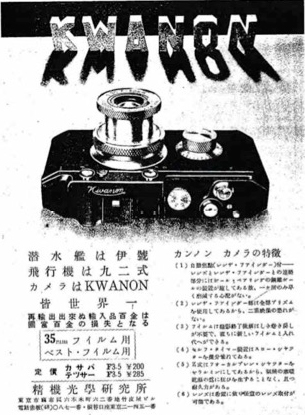
Peter Dechert explains that it is commonly called the Kwanon C but refers to this as the second design based on the main difference, the viewfinder system. This is his drawing based on the ad:
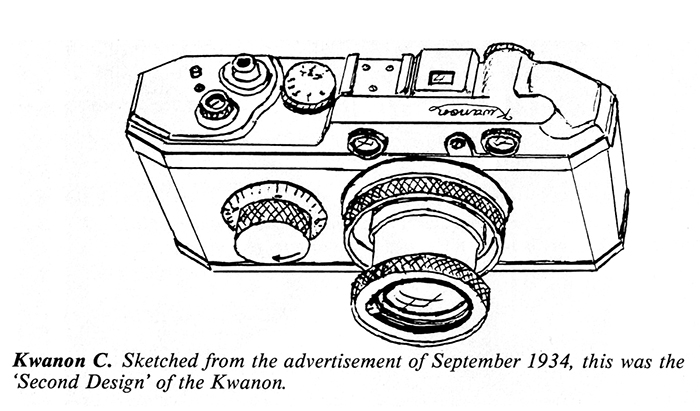
(Image from Peter Dechert's book, Canon Rangefinder Cameras 1933-1968)
Kwanon D - camera-wiki.org/Third Design - Peter Dechert
Camera-wiki.org calls this one the Kwanon D, Peter Dechert calls this the Third Design. Both he and camera-wiki.org (Dechert is quoted as the camera-wiki source) cast doubts on whether the vague illustrations are of the Kwanon D/Third Design, or are still of the Kwanon C/Second Design. Nevertheless, both the drawing in Dechert's book and the camera-wiki.org description speculate that this design has already adopted some of the forthcoming Hansa Canon features, e.g. the film wind knob has moved to the top plate with the film counter remaining on the front. However, Peter Dechert's drawing shows that the lens mount is the Nippon Kogaku focusing type of the Hansa Canon. Given the vagueness of the original illustrations and descriptions, I'm not sure how he can make any claims about the design other than by assuming, as he says on page 19 of his book, that “many of its structural features can be inferred from parts used on the very earliest Canon Hansa cameras”, i.e., by guesswork. In fact his drawing on page 22 is entitled “Suggested ‘Third Design’ Kwanon.” It could be accurate, but most likely is not.
Nippon Kogaku was approached late in 1934 and Goro Yoshida left shortly afterwards. Hayato Ueyama quotes Nippon Kogaku's focusing mount designer, Eiichi Yamanaka, who says it took about 8 months to complete the prototype mount. According to research done by Hans Braakhuis, a patent was applied for on 27 June 1935 so the two claims line up. Therefore, its first appearance on a camera body would unlikely have been before the “Canon” name trademark application was also submitted in June 1935. By this time, the complete Canon design must have been approaching finality under new designer, Tomitaru Kaneko, with the Hansa Canon being announced in October 1935, complete with a photo of the camera as we know it. The idea of a Kwanon fitted with the mount seems highly improbable.
Notably, Hayato Ueyama doesn't mention this version of the Kwanon, but does note that Goro Yoshida did have different ideas that he would sketch out, possibly explaining the “vague illustrations” referred to above.
Kwanon D - Peter Dechert, Hayato Ueyama
Peter Dechert's book features a blown up small image said to be from a post-War Japanese magazine of a camera that looks very similar to what I have called the “Kwanon D Replica” below. Hayato Ueyama features the same image and says it is the Kwanon D picture in the “much delayed” book, “How to Use a Camera”, published by Kogeisha in January 1949. Given the difficulties with Japanese translations, it may be the same publication. The Japanese text above the camera in the image in Dechert's book says that it is a “Kanon” (name in English) first produced in Showa 9 (1934) and fitted with a “KasyaPa f3.5” lens. Peter Dechert also calls it “Kwanon D” which seems to imply it is the same as the previous one. With the film wind knob still on the front, it's not like his “third design”, or the equivalent camera-wiki.org Kwanon D. It looks like both their Kwanon C designs but with what looks like a rewind knob added:
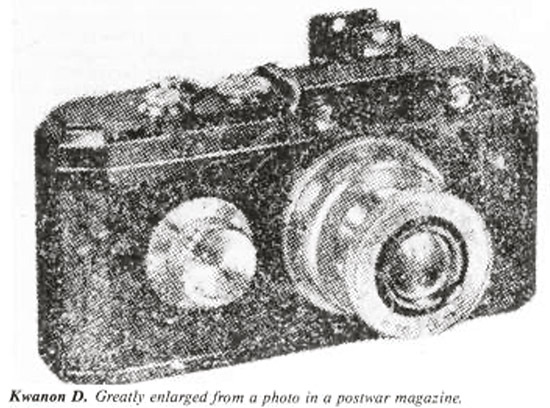
Because of the rewind knob, it may be assumed that this version abandons the magazine to magazine film loading feature. However, there may be an alternative to be considered. The camera is the same as the Kwanon C, except for the rewind knob. It still includes the self-timer, which makes me think that it is again unlikely to be a working example, if such things existed at this time. The camera is still clearly the Goro Yoshida design and therefore still likely based on unrealistic aspirations. The B was advertised in July 1934, the C in September 1934 following the viewfinder rethink to avoid Leica's patents and Yoshida departed before the end of 1934. The 1934 release of the pre-packaged disposable daylight loading 35 mm film cassette by Kodak was unlikely to have had an immediate impact on the Laboratory's thinking and Hayato Ueyama instead surmises that the change in film transport may have been caused by difficulties due to the fact that the Contax had a removable back and the Kwanon didn't. That would assume a working prototype to test his ideas.
My alternative thought is that the appearance of the rewind knob on what looks like the Kwanon C could just be Yoshida adding a magazine to spool option to the earlier magazine to magazine film tranport to bring it into line with its Contax inspiration. I'm not promoting this as a more likely scenario, simply suggesting that there are maybe more possibilities to consider, especially as the influence of the Contax and its film transport system doesn't seem to get much attention. In any case, I doubt that the Kwanon D can be considered as a transition to the Hansa Canon, the real work to turn ideas into a working camera still had 12 months to run, they were barely half-way there and in the second half, they had the technical skills and management discipline of Nippon Kogaku to ground them and help keep things on track.
The pictured camera can be one of several things, an actual Kwanon prototype from later in 1934, which Canon and some people that worked at Seiki Kogaku strongly assert were never made, one of the mock-ups which are generally acknowledged to have existed (the photo itself could be pre-War, even from the time the mock-ups were made), an illustration (hard to say with the picture quality), or a replica. Peter Dechert is fairly positive about this being genuine, as he is about the existence of other examples and he suggests that various early Hansa parts originated with the Kwanon. He acknowledges that they were never marketed but seems to be doubtful about Canon's claim that none were ever made. In fact, he believes that the “Third Design Kwanon came close enough to production for parts, or at least dies, to have been completed in anticipation of assembly and sale.” He also thinks that the Kwanon D “is possibly the ‘Hansa Canon style Kwanon F3.5 camera’ advertised for sale by a Shimbido shop and presumably lost during the war.” Peter Dechert postulates that when Goro Yoshida departed Seiki Kogaku, he may have been taken one or more Kwanon examples with him and as he was a friend of the store's owner, Hideo Hokura, he could have sold the cameras through him. All that sounds plausible but without one verifiable fact, from the existence of Kwanon prototypes to their sale, to anchor it, it is just a story based on possibilities that make sense to Peter Dechert.
Specifically in regard to the Kwanon D, Canon says there was no such camera. From the History Hall:
“There was a camera called the “Kwanon Model D,” discovered in Osaka around l955, however, it was a copy of a “Leica Model II,” and was not made by Yoshida. The manufacturer of the “Kwanon Model D” is still shrouded in mystery.”
I am somewhat confused - the magazine photo is earlier and more Kwanon than Leica II, I presume that we talking about two different cameras.
Kwanon D Replica
The camera below appears to have the same features, including rewind knob, as the Kwanon D in the magazine/book photo. At first glance, it could be be the same camera appearance wise. However, as grainy and as low resolution that the blown-up photo is, there is no evidence of any brassing. More importantly, a couple of the controls are slightly different, as is the top plate subtly, see below. The KasyaPa lens appears near identical to that on the Canon X and the same as in drawings and ad renderings for the other Kwanon prototypes. Apart from the addition of the rewind knob and also the differences noted against the magazine/book photo, superficially, it appears to be a reasonably accurate representation of the Kwanon C. Some of the auction photos:
.jpg)
.jpg)
.jpg)
.jpg)
.jpg)
.jpg)
.jpg)
The Camera sold at a Skinner auction house auction in Boston, USA, on 29 July 2006 for a record US$138,000 for a Canon model. One story was that Canon Inc. was not interested because there is no engraving of the “Kwanon” name. That's questionable whether it's a valid concern with a prototype, but almost certainly, Canon also had other much more serious doubts.
Some collectors and respected websites have been favourably disposed towards the authenticity of this camera, albeit not without their own doubts too. Even Peter Dechert has his name connected to it. From examination of the photos, my own view is that it is a fake designed to deceive, a fair but still inaccurate one on the surface and a sloppy one under the skin.
My first issue with this camera is the body shell. With the base plate removed, it appears to be a later die-cast example. Whilst most Hansa Canons/Canon Originals and all subsequent models through to the post-War Canon S II used a formed construction which was pressed into shape, it is true that there were early cast examples. According to both Kannonji Makoto, in an article in the June 1982 edition of Japanese magazine, “Camera Collector's News”, and Japanese author Hayato Ueyama, the very earliest Hansa Canons, and perhaps any prototypes, featured a machined sand cast body and from the pictures in Peter Dechert's book and other pictures I have seen, they are hard to tell apart from die-casting. In fact, Dechert erroneously believed that they were either die-cast or milled. However, regardless of the construction technique, both formed and cast Hansa Canon bodies and also the first die-cast Canon S II and B II body shells exhibit the typical light colour of natural aluminium alloy (see Hansa Canon below). The reason why I believe the auction Kwanon features a later die-cast body is that the body shell lip of the Kwanon is significantly darker than natural and almost exactly like the darkening introduced on later Canon II Bs in 1950. Auction Kwanon body shell above and late Canon II B below:


Also, the tip of the film spool spindle appears to have two notches which are not seen on any other Canon spindle (different to the single notch for the Rapid Winder introduced with the Canon III, although, I note that the Leica III introduced two notches for Leitz's Leicavit inspiration). The shutter is a cloth curtain type rather than metal type promised by the first three ads. Accepting that there may have been progress towards a more realistic design, compare the Kwanon shutter crate to the Hansa Canon types further below, particularly the first Leica II type. Clearly, it is not as early as even the first three types without the disk (future opening curtain cam used with slow speeds), or the first two without the two screws for the future slow speeds retard rod flat spring. It is missing some screws, maybe to help keep it in character, and the 6 toothed tension adjusters didn't appear until the Canon S. These also look “toothier” than any Canon examples, early, or later. Also note the right end of the flat spring cut-out, the auction Kwanon shows an angled and radiused corner whereas on the Hansa Canons with the cut-out, when it came, it is a sharp right angle and it continued as a right angle until a new spring was introduced with the post-War die-cast Canon S II body. The tensioners, spring, a couple of odd screw placements and the shutter dial, discussed further below, with one less speed step and different spatial positioning of shutter speed markings to both Kwanon prototypes and all Canon models, makes me question whether this is a Canon shutter at all.
I'm not convinced by the rest of this Kwanon D either, noting again that Canon strongly asserts that no evidence has been found that any Kwanon prototypes were actually constructed, not including the original Kwanon X. Whilst there is now a rewind knob, there has been no obvious addition of a rewind release control (with most Leica copies, it is a lever) to enable the rewind to be used, even though there may be one on the B and C models (see Kwanon B and also below). Also, there is no focus adjustment plug in the camera back, a feature of all production Canon models before the 1946 S II. There needs to be a matching hole in the pressure plate but it's not there in this one, see above photo of the lens mount and detached shutter curtains and hence, the naked pressure plate. Accessing the camera's film plane through the plug hole had been the standard method of adjusting the back focus of lenses on bottom loading Leica cameras until Leitz introduced focus standardisation for its Leica in the early 1930s (the back plug was also used on 1940's Nippons, the first post-War Niccas and pre-1935 Soviet cameras). One assumes that correct focus is important for a prototype and it certainly appears to be there in the Japanese drawings at the top of Kwanon (prototype series).
Earlier, I mentioned that the controls on the Kwanon D in the magazine/book photo were different to this one. In fact, the controls of the camera in the photo are very similar to the controls in the rendering of the Kwanon B in the ad further above, namely the chrome shutter button and the dial in front of it, which according to Hayato Ueyama is the self-timer listed in point 4 of various ads. Below is a comparison between the ad Kwanon B on the left and the auction Kwanon D on the right (note also the platform under the D shutter dial, more further below):
.jpg)
.jpg)
As mentioned in regard to the Kwanon B, Hayato Ueyama refers to the knob and nearby chrome screw on the top plate as an A-R shutter release lever. Whilst seeming unlikely, I agree that one of the clearer Kwanon B ads might indeed show a lever with the chrome screw being the pivot point and the knurled knob at the end - in the other B ad I have featured here, the area is just black with only the screw and knob/button visible. However, what is definitely different about the auction D is that it has a large black screw in place of the self-timer dial in front of the shutter button rather than the chrome dial of earlier Kwanons, including the magazine photo, and no button, or lever, either. Also, its shutter button just looks like a black pimple on the top plate. There is no collar, nor thread for a cable release, both of which featured on every Kwanon version, including the X, and all Hansa Canons (no thread from Canon S to IV Sb2). All of them were also chrome. Given the brassing elsewhere on this body, the black shutter button looks remarkably wear free.
Then there is the shutter dial and its platform underneath it on the top plate. From the Kwanon X to the Canon II B, main dial shutter speeds are marked Z (B later), 20 (20-1 if with slow speeds), 30, 40, 60, 100, 200 and 500, i.e., in 8 steps, and the physical spacing is similar. Below are dials from the Kwanon B (from a much higher resolution version of the ad further above), a Hansa Canon and the auction Kwanon D:
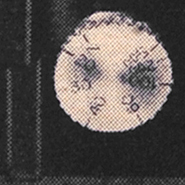
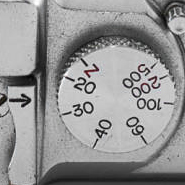

The auction Kwanon D is clearly the odd one out, missing the “30” speed and therefore only having 7 steps and the spacing is also quite different between the “20”, or possibly “25”, and what is presumably the “Z” marking. The “4” in “40” is open, I am not aware of any “4” on a Canon dial which is not the closed type. Note, the auction description claims the dial is marked “2, 25, 40, 60, 100, 200, 500”. Clearly, the “2” is not possible without a slow speed escapement and must be a typo for “Z”, but “25” could be correct because the second digit in the dial photo is impossible to discern with certainty, but nevertheless, is improbable for a period when focal plane shutter speeds generally started at 20. In any case, it confirms that “30” is missing.
Not obvious from these photos but can easily be confirmed from the Kwanon ads, Peter Dechert's Kwanon C sketch, the magazine/book Kwanon D photo and the auction Kwanon D photos is that the auction Kwanon D shutter dial has a slightly raised platform under it whereas all the other Kwanon prototype images show a completely level top plate in this area. Also, the accessory shoe features a Leica II-like pressure depression in the top of the side rail with two screws at the front and one at the rear - this only appeared on the Hansa Canon after Canon S production commenced in 1938. The best of the renderings in the Kwanon ads don't show the depression and the screw pattern is reversed with the single screw at the front. The early Hansa Canon was flat but with a curved cut-out from either side.
Along with film transport, another big issue for me is the base plate below. The earlier Kwanon designs wound film from one magazine to another (not the Kwanon X with its Leica-like rewind knob and maybe the magazine/book Kwanon D which is a bit of a mystery) , i.e. there was no need for a film rewind knob. This body has a rewind knob and what appears to be a fixed spindle shaft for the removable take-up spool so obviously has been adapted for single magazine use. However, the base plate still has two bottom locks, both with the Hansa Canon-like cassette opening/closing mechanism, which is the “C” shaped device on each lock. The one at the spool end is redundant now and that is a big problem. In its place, there should be a vertical shaft/pin to support the spool. Every Leica and Leica copy without a fixed spool has some method of supporting it, otherwise there would likely be winding and flatness issues. Both “C” shaped openers show an equal amount of brassing but only the one at the cassette end should have been contacting anything. The lock at the cassette end has a tab (outside of the “C”) which would normally turn under the saddle usually screwed to the end of the shutter crate (see Hansa shutters further below) which in this case is missing - screws are there but no marks on the paint to indicate it had been there. How the base plate is currently secured is a mystery to me (there also seems to be a tab at the spindle end - possibly redundant even with a cassette to cassette system):
.jpg)
.jpg)
In comparison, below are inside and outside views of an early Hansa Canon base plate with centre tripod mount still - on the outside there is the blanked-off indentation for the second lock/magazine key, so presumed to be an adapted Kwanon design. Note, both the Kwanon D replica and the Hansa Canon centre the tripod mount but the earlier Kwanon drawing further above shows it offset to align with the lens axis. The key for this Hansa Canon base plate lock is designed so that it can only fold in one direction, typical of most examples. Whilst the two way design featured on the auction Kwanon D didn't become a typical Canon feature until probably 1946 (the S I examples I have seen still have the one way key but the J IIs seem to have either), I have seen at least three early Hansa Canon examples with centre tripod socket and the two way keys. But there is a difference, none of the Hansa Canons feature a key, either two or one way, with a pin hole in the centre of the shaft at the base of the arrow like the auction Kwanon, generally this seemed to arrive after the War (although it is there on a one way key on a Canon NS base plate, if original):

 (Web images)
(Web images)
The outline of the three rivets for the tripod mount are just visible. On the inside, there is a pin for the spool end. There is also a channel section baffle/body support, typical of Leica practice and later Canons, blind riveted to the base plate in the same way as the tripod mount (Peter Dechert's book shows base plate 1316 with no signs of rivets on the inside for either the channel or mount but the items themselves are still the same). The notch in the channel is explained in the Hansa section. On the auction Kwanon, the missing channel can perhaps be explained by its prototype status but the tripod mount and its attachment are also completely different on the prototype and there seems to be some sort of lumpy bodge going on under the black paint.
It occurs to the cynic in me that the unexpected rewind knob and associated film transport bits, and the problems that this caused with the bottom plate etc., may have been added to explain the absence of parts for the “designed” cassette to cassette system and it is convenient that the damaged shutter curtain makes it inoperable.
Other than the redundant magazine opener, I also find other aspects of the brassing less than convincing. The black enamel paint on the body is in good, smooth, relatively scratch free condition (apart from the base plate) yet the brassing appears to some degree along all the hard edges. It seems to occur discreetly, evenly, symmetrically balanced and dare I say, with artistic good taste. Remember, this is supposed to be a prototype camera, perhaps a little rough at the edges and it wouldn't have been treated with care. The brassing on the bottom of the shutter crate appears to be rubbed with no hard or ragged edges whereas the reality is that there are very few wear points on a shutter crate and it is much more common to see chipped paint here or flaking paint, not worn. There is a lot of brassing and fine scratches and pitting on the lens barrel but much of it is even and circular, not really typical of a hard used retractable lens where scratches are usually along the barrel. Then there is the camera lens mount - there are fine marks on the surface but a lot of it is linear, not circular as would be expected and there are no signs of a well used mount that the degree of brassing and broken shutter curtains would suggest.
Yet with all my concerns about the camera, I look at the top plate shape and it is a work of art, except for the shutter dial platform, relatively faithful to the detail in the earlier renderings. The rewind knob is unexpected and the shutter dial, accessory shoe and the shutter button are questionable but the rest of it is convincing to a point. The lens too, with its unique focusing ring, is faithful to what we have already seen on the Kwanon X and renderings, however, lower down and under the skin, such as the body shell, the shutter crate, the unresolved locking and film transport issues with the bottom plate, all seem like the result of less careful attention to detail. It's like the story of two different cameras and makes me wonder whether the top plate, and possibly the lens too, may not be authentic prototype parts that someone has later assembled with newer bits and pieces into a complete make believe Kwanon? Maybe, but probably not. The impression I get is that the camera is meant to deceive and if you accept its appearance, you may not question the rest.
I should mention that whilst the KasyaPa lens looks authentic, its only real difference appearance wise to an Elmer, or Russian FED version, is that it uses a knurled focus ring at its base rather than a finger operated tab with knob, something relatively easy to reproduce, as are new engravings.
The back story to the Skinner auction (now called Bonhams Skinner) seems to be that although Peter Dechert is credited with assisting with the catalogue notes, there was no documented expert evaluation, supporting documentation, or other assurance of provenance. Peter Dechert's access to the camera and own thoughts are unknown, although a forum post from the time of the auction, by somebody I consider knowledgeable, claims his contribution was based simply on photos. The catalogue claims: “From information supplied by the consignor, the camera was acquired ten years ago from the daughter of a real estate agent in the Bronx, New York, along with a Contax I and a Leica II, who reported that all three cameras had been in the family since the early 1950s.”
A slightly more detailed story was provided by Jeanne Schinto writing for the November 2006 Maine Antiques Digest: “A consignment from a collector who is a Nikon specialist, it sold after a battle between two phone bidders for $138,000, more than four and a half times the high estimate and a Canon auction price record. Skinner sci-tech department head Nick Hawkins said the buyer was a collector overseas.”
And: “The Kwanon had good provenance. It also could legitimately be called extremely rare, even unique. Hawkins said the consignor acquired it about ten years ago from a family in the Bronx. They'd had it in their household since the 1950's after having received it as a partial rent payment from tenants, Hawkins said. How did the tenants get hold of it? Who knows? But the balance of their rent that month was paid by two other cameras, a Contax I and a Leica II, according to the family.”
Continuing: “The numeral 2, stamped into the inner surface of the Kwanon's base plate, lends credence to the idea that it was the second operable prototype made by the company.” To me, it seems that the “numeral 2” could actually mean anything, even if it had been one of the Kwanons made by Goro Yoshida. I also question the “good provenance”, I personally think that it is very questionable, there is virtually nothing about this camera's known history to link it to Japan and Seiki Kogaku circa 1934, or 1935.
However, regardless of anything else, apart from maybe the rewind knob and a few minor trim bits, you can accept it as a fair representation of what a late Kwanon prototype may have looked like, if built. Under the skin, I doubt that any bits even resemble a pre-War Canon. Is there a connection to the very similar magazine/book photo? Given the small but significant differences, unlikely, except as maybe inspiration for someone.
Hansa Canon & Canon Original
Production (Peter Dechert) |
Marketed (Canon) |
Slow Dial |
Main Dial |
Sync |
S/Timer |
1935/10-1940/06 |
1936/02 |
No |
Z, 1/20-1/500 |
No |
No |
Note, both Kannonji Makoto and Hayato Ueyama believe that production finished in 1938
Nippon Kogaku Mount Numbers |
||
Source |
From |
To |
| Peter Dechert | 55 |
5200 |
| Found | 6x |
515x |
Base Plate (BP) Numbers |
||
Source |
From |
To |
| Peter Dechert | 1119 |
1334 |
| Peter Dechert | 2022 |
2997 |
| Peter Dechert | 3019 |
3223 |
| Found | 116x |
123x |
| Found | 202x |
279x |
| Found | 316x |
|
(Note, the Hansa Canon/Canon Original does not have a serial number as we know it. However, the focusing mounts were numbered by Nippon Kogaku and there is a Seiki Kogaku stamped number on the inside of the base plate. Both are explained below).
| Lens Mount: Bayonet in J mount focusing unit | |||
| Normal 50mm Lens (Peter Dechert): Nikkor f/3.5 | |||
| Found with Lens: | |||
| Lens | Description | Serial Numbers |
|
|---|---|---|---|
From |
To |
||
| Nikkor f/3.5 | Collapsible. Black face | n/a |
5050x |
| Nikkor f/3.5 | Collapsible. White face | 50117x |
|
| Nikkor f/3.5 | Collapsible | 50142x |
50176x |
| Nikkor f/4.5 | Collapsible. White face | 502x |
5086x |
(Note, there are no serial numbers on early black face and very earliest white face lenses.)
The first production model was the “Canon” camera, or as Seiki Kogaku referred to it, “Canon Standard Model”, the majority but not all, also featuring the word “Hansa” engraved above the Canon name, hence the name “Hansa Canon” being used. Collectors, being collectors, call the plain Canon “Canon Original”. See The Canon Story for a detailed explanation but basically, “Hansa” is a trademarked brand name belonging to camera distributer Omiya Photo Supply Co., Ltd. “Hansa Canon” on left and late (new accessory shoe) “Canon Original” on right, otherwise identical except for any other early/late variations:
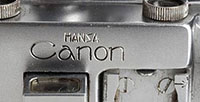
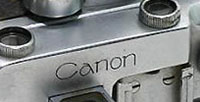 (Detail from larger web images)
(Detail from larger web images)
There is no doubt that the Hansa Canon was a direct development of the Kwanon designs and design elements obviously carried over to the production camera. Over time, some of these were modified, sometimes to simplify production, other times as improvements. These design cues are obvious but it is not necessarily the same thing as “using up parts intended for Kwanon production” claimed by some. There is still no evidence that any of the Kwanon designs, apart from the Kwanon X, were built as working prototypes, let alone parts being produced for their production.
Serial Numbering - Lens Mounts & Base Plates
In addition to Peter Dechert, for this camera, I'm also relying on Kannonji Makoto's articles in the May and June 1982 editions of Camera Collectors' News and author Hayato Ueyama. Dechert tells us that the numbers stamped on the inside of base plates are design types; 1xxx being with central tripod mount, 2xxx being with end mount and 3xxx having additional strengthening (the positions of the three internal tripod mount screws are noticeably different) and that the only way to put the cameras in production order is via the lens mount number. On the other hand, both Makoto and Ueyama claim that the base plate numbers are also Seiki Kogaku's serial numbers although they freely admit that some were fitted out of order when they didn't fit the current cameras and that there had also been subsequent swapping of base plates. Makoto is far more scathing of Nippon Kogaku's inability to supply mounts in the correct numerical order. Interestingly, I have ordered my database according to mount number but if i was to reorder it via base plate number, there would only be a couple of relatively minor changes and it is almost impossible to say which would be more correct. However, I do note that with the Canon S model, the mount numbers are wildly at odds with the top plate serial numbers, something also commented on by Dechert.
Notably, there is a late Original in my database with a base plate which I am fairly certain has not been stamped with a number. It is the correct type with the notch in the side. Perhaps it is a replacement spare part?
“Hansa Canon” & “Canon Original” Production
Makoto notes that a friend, who was familiar with the Roppongi facility, claimed that three “Canon” named prototypes had been built and that one had been shown to potential distributor, Omiya Photo Supply, an event repeated by Hayato Ueyama. He says that the “Hansa Canon” was first mentioned “in the new products column of the October 1935 issue of Asahi Camera magazine” (confirmed by Martin Bacardi, see below). However, there is some doubt about whether it went on sale in 1935, or early 1936. Makoto is quiet on this, Dechert says production began in October 1935 but very few were available. To this, Canon has responded with “... introduced to market in February 1936 (although some have said that the actual date was October 1935)”. Martin Bacardi, a Canon Historical Society member, who claims to have all the Omiya Photo Supply and Seiki Kogaku ads from the 1930s and early 1940s (and has posted key examples, including the first one), says that the first ad appeared in the December 1935 edition of Asahi Camera magazine, and that one and all the Hansa Canon ads placed during 1936 were produced by Omiya Photo Supply. He also believes Canon's claim that sales commenced in February 1936.
According to Japanese website nikonfan.cocolog-nifty.com, the article below about the release of the Hansa Canon appeared in the 1 February 1936 issue of Nihon Shashin Kogyo Tsushin. My translate app doesn't make much sense of it apart from the broadest detail and that the Hansa Canon is a new camera that is being sold by Omiya Photo Supply. Whilst in theory, it could fit a timeline anywhere from October 1935 to February 1936 for a release, it sounds more like an introduction, or announcement than a review, the sort of thing that a competent distributor like Omiya, might arrange for a release:
(Click on article for larger version)
In any case, the production rate at the Roppongi workshop during the first half of 1936 was quite low, according to Makoto, limited to about 10 cameras per month on average with frequent disruptions and according to Hayato Ueyama, initially only 1 to 2 units per month due to slow lens supply from Nippon Kogaku and problems with outsourced work.
There are four Canon Originals in my database from the end of production and one middle to late in production but they may have been made in small numbers throughout. Both Dechert and Makoto suggest 3 or 4 times as many Hansa engraved examples and Ueyama thinks that it is about 6 times. When I include two early ones in my database, it is just less than 6 times, but of course one, or two, cameras either way will affect that. Makoto provides details of an early Original example with mount number 113 and base plate 1175 (also identified by Ueyama). He says that such direct sales examples may have been to VIPs and army officers but apparently were frowned upon by Omiya Photo Supply.
Another early Original has recently surfaced in Australia. It has mount number 119, base plate number unknown. Both cameras have early numbers and would be expected to share features of the early Hansa examples around them, but that is not the case. Whereas early Hansas feature recessed top plates for the pop-up viewfinder, shutter collars with tapered base and plain shutter release levers without pointer, or any marking, both early Originals have typically later features, i.e. flat top plate, shutter collar with full height ribbing and release lever with pointer and “A-R” marking on the top plate. However, both still have early base plates with centre tripod socket which lasted about as long as the recessed top plates. In other words, these two cameras are a similar mix of very early and later parts. Perhaps they were both a result of rework and maybe that has something to do with why they were selected for direct sales?
Following the formation of the Seiki Kogaku company in August 1937, Makoto claims that the “Hansa” name disappeared from advertising and later, also the camera's top plate, which fits with my database and is confirmed by Hayato Ueyama. This is not unexpected, it is most unusual for the camera distributor's brand name to be co-included on the camera, something that Omiya Photo Supply no doubt achieved from a position of power over Seiki Kogaku's nascent future, however, as Seiki Kogaku developed momentum and achieved success, that power balance would have shifted. Notably, the Nippon Kogaku name also disappeared from the lens mount in 1937.
As evidence, Makoto presents the two ads below. Left is a 1936 Asahi Camera ad with “Hansa Canon” in big Japanese vertical characters in the big bar on the right side (according to Martin Bacardi, similar adds appeared in the July, August, October and November 1936 editions) and below right is a militaristic 1938 Asahi Camera ad with “Canon Camera” in smaller print under the Seiki vulture and just “Canon” on the camera top plate and the big text at the bottom translates to “Please contact Seiki Optical Industry Co., Ltd.”, no mention of Hansa:
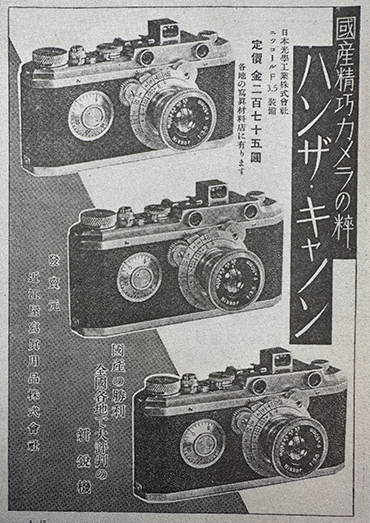
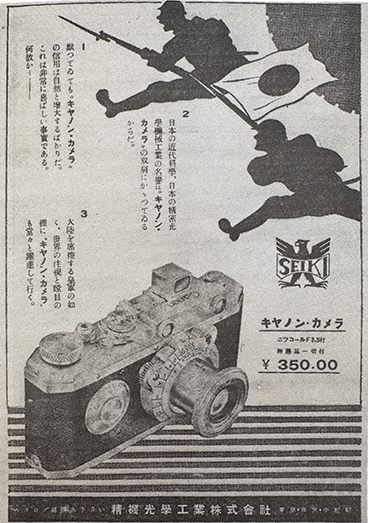
Hayato Ueyama's book similarly features a Hansa Canon ad from the June 1937 edition of Asahi Camera and a Canon Camera ad from the August 1938 edition, this time with the names in English:
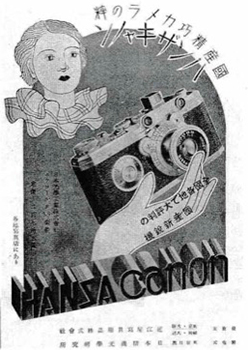

According to Peter Dechert, production of the Hansa Canon/Canon Original ended in June 1940. Kannonji Makoto, writing before Dechert, and Hayato Ueyama after him, both seem to think that it was when advertising seemed to end in late 1938, perhaps coinciding with the commencement of Canon S production in October 1938, although Canon didn't “market” the S until April 1939. Perhaps seeking interest from foreign importers, Omiya Photo Supply placed ads for a Hansa enlarger and the Hansa Canon in the British Journal Photographic Almanacs of 1938 and 1939 - that could indicate 1939 production, but probably, it does the opposite. Quite cheekily, the pictured 1939 camera is named “Hansa Canon New Model” at the top, i.e. Seiki Kogaku's “Canon Newest Model”, now known as the Canon S, and simply “Hansa Canon” in the description with slow speeds and all four lens options listed (f/2 to f/4.5) with no mention of the actual Hansa Canon without slow speeds. The camera in the earlier 1938 ad is the initial model and is marked “Hansa Canon” on the top plate, both ads somewhat contradicting Makoto's claims about “Hansa” disappearing from ads from 1937 on, but I think these two were a special case, all about raising overseas awareness of the Hansa brand and Omiya Photo Supply products, ergo, the Canon S being tagged with the Hansa name too. You would have to question whether theses ads had been cleared with Seiki Kogaku. Note, the slow speed shutter dial in the Canon S rendering is shown too far to the left and without its characteristic crank, this seems to be like the prototype S in both Hayato Ueyama's and Peter Dechert's books:
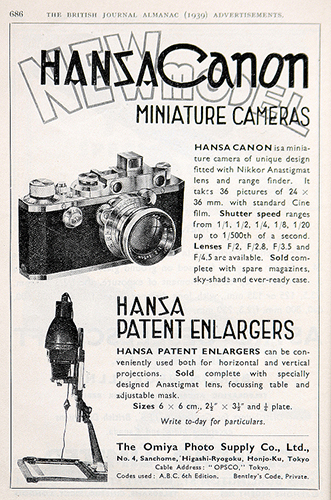
Dechert tells us that the “Original had been adopted as a Japanese army camera in April 1939, after the sales of the Canon S and J began”. At the end of very similar tables identifying variations, both Makoto and Ueyama (8 years later and more examples) list “Type 98 small camera (for Army use)” (Ueyama is unsure whether there were any differences to the Standard Model but believes only small numbers were procured by the military). Perhaps only this version continued on until 1940, although all three models are listed in the April 1939 Canon J ad further below. Ueyama does say that the Standard Model was a slow seller by this time and remained in stores for years after production finished - this could also be the source of confusion. I have to say that looking at my database mount numbers, there doesn't seem to be much of a possible cross over period with the S but it's certainly not conclusive given the vagaries of these numbers.
Lens Mount, Viewfinder & Rangefinder
As noted earlier, the Canon features lens, focusing mount and rangefinder system designed and made by Nippon Kogaku to circumvent Leica patents, the lens and mount heavily influenced by the Zeiss Contax I (Nippon Kogaku's name also appears in the first ad above). The main lens mount is 39mm diameter like the Leica but with a pitch of 24 TPI instead of 26 TPI and into this the focusing mount is screwed and secured by set screw. The removable lens barrel is inserted into the focusing mount using a bayonet fitting (see also Lens Mounts). The viewfinder is a pop up type:



(Detail from larger web images)
Early lens mounts up to at least 717 were engraved “No. (x)xx Nippon Kogaku Tokyo”, later ones (from 853 in my database, Dechert says 800) are simply engraved with the number in the format “Nr. (x)xxx”, Nr. being the German abreviation.
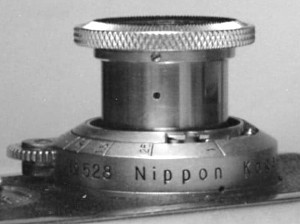

(Detail from larger web images)
The change seems to have occurred about the time that Seiki Kogaku formed into a company in 1937, but may be coincidental, according to Hayato Ueyama, a Nippon Kogaku employee claimed the change was due to the cost of engraving as it took a long time. Note, regarding claims that 712 was the last mount with Nippon Kogaku engraving and the only 7xx example known, 717 (BP 2452) is now the last one known. Both feature late black face lenses with serial numbers and “cm” markings (only two in my database).
A feature not mentioned by Dechert but covered in frustratingly little detail by Kannonji Makoto is magnification of viewfinder and rangefinder images. According to him, the first examples featured both magnified viewfinder and rangefinder images, camera with mount number 659, BP 2369, features a magnified rangefinder but life size viewfinder and by mount number 988, BP 2560, both finders are life size. Hayato Ueyama features virtually the same table with a couple of changes. Strangely, he lists mount 659 with different BP 2176 and both viewfinder and rangefinder being magnified. However, he has been able to bring forward the point of both finders becoming life size to mount 712, BP 2472.
Design
Two design features set this model apart from subsequent designs; the frame counter on the front, which is a carry over from the Kwanon winding knob design but resulted in a lower profile knob, and the one piece top plate design incorporating the rangefinder housing, which together gave it a more streamlined appearance.
The first Hansa Canons featured a recessed area on top of the viewfinder/rangefinder housing into which the pop-up viewfinder drops. It has been described as a carry over from the Kwanon prototypes. Design wise it certainly was but the visual evidence suggests that the Kwanon recess was much deeper to accommodate its fold-up viewfinder, probably as deep as the accessory shoe depression as it is in Peter Dechert's Kwanon C drawing and the auction Kwanon D replica. The second image demonstrates how vestigial the Hansa Canon version is (the button on the back allows the viewfinder to pop-up). In any case, the one-piece top plate pressing was all new, adding a platform under the shutter dial and removing the slight platform at the end of the top plate:
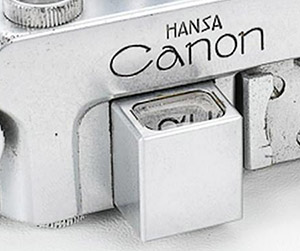
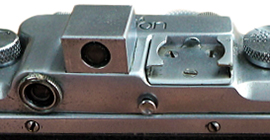
(Detail from larger web images)
The circular plug in the middle of the back is to assist with infinity focus adjustment when matching lens to body accomplished with adding or subtracting shims under the lens mount. It is found on all early bodies before the 1946 Canon S II (Leica also used this system until the early 1930s before they were able to adopt a standard back focus).
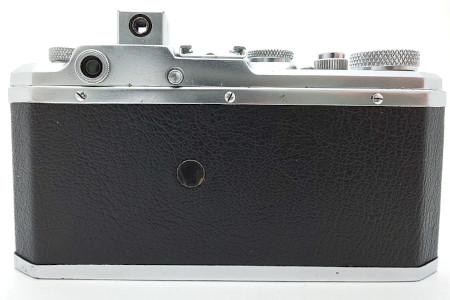 (Web image)
(Web image)
Most examples feature an accessory shoe with curved cutouts on the side rails but late examples, including the three Originals in my database, feature straight rails with pressure depressions inherited from the new Canon S:

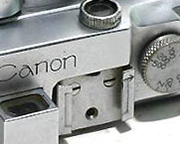 (Web images)
(Web images)
There were several iterations of the rewind release lever over time; the earliest was a basic lever to which a pointer was added to later (hard to see in the photos) and finally, “A-R” was engraved on the top plate:
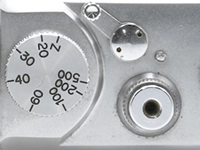
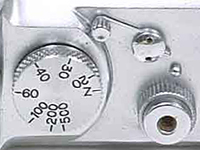
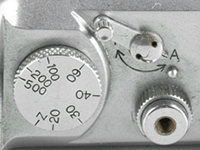
(Web images)
Note also that the earliest example on the left features a different shutter button collar; whereas later ones are simply ribbed for their full height, earlier ones featured a plain tapered base. As with the Kwanon designs, the shutter buttons feature a cable release thread which would disappear with the Canon S and not return until the 1956 Canon VT.
The shutter dial shared the Kwanon's Leica II speed progression markings: Z, 20, 30, 40, 60, 100, 200 and 500 (with “B” for “bulb” replacing the German “Z” for “zeit” starting with the 1946 S II and 20-1 used if fitted with slow speeds, it would remain the main dial progression until the Canon III).
Shutter Evolution
The bottom of the shutter crate started with a typical Leica II type flat spring and plain appearance but by maybe a third way through production, looked like a Leica III type, only missing the slow speeds retard rod flat spring (and the slow speeds mechanism inside). Kannonji Makoto explains that during production, Canon had already started development of a version with slow speeds, which would become the Canon S, and the necessary changes were slowly incorporated into the Hansa Canon. It probably made sense to have one shutter type which could be configured as required.
It probably also made it easier for slow speeds to be added later. In his book and monograph, “The Contax Connection”, Peter Dechert tells the story of Kōgaku Seiki-sha (Optics & Precision Co.), the future Nicca, which was an official Canon repair agency established in 1940 by eight former employees of Seiki Kogaku at the behest of Omiya Photo Supply. An ad in the June 1941 Asahi Camera magazine says that the company can install slow speed shutter dials in older Canons without them, presumably the Hansa Canon. Peter Dechert knew of one remaining example. This one, with mount number 853, came up for sale in 2023 and according to Hayato Ueyama, was once owned by the son of Seiki Kogaku founder, Saburo Uchida, so it could be either an in-house conversion, or one by Kogaku Seiki, however, another one in Ueyama's book, mount number 659, seems to have definitely been made inhouse:
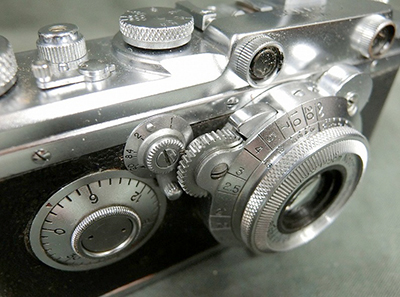 (Web image)
(Web image)
As expected, the shutter is fitted with a typical slow speeds flat spring (I've cranked up the levels to be able to see it). The top of the cylinderical pin in the disc which interacts with it is clearly visible (relevant to discussion below and Kwanon D Replica above):
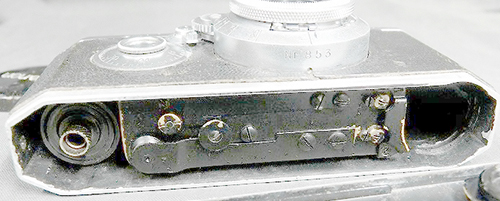 (Web image)
(Web image)
Peter Dechert suggests that the shutter below is the earliest type, which makes sense because it looks like the Leica II type and that was the starting point. In his book, he has photos of an example with mount number 127 and first type body shell (see further below). The flat spring has no cutouts, there is no disc and there are fewer screws. There are two examples in my database, the first with mount number 19x (BP 123x), this one is 20x (BP 202x):

This is actually the earliest, by mount number, Hansa Canon in my database with the shutter crate visible, number 15x (BP 116x). The flat spring has its cutouts already and there is a blanked off hole in preparation for the disc spindle but the pair of screws on the top right in later cameras is still missing:

The last type without the disc, now featuring the pair of screws at the top right which on the Canon S will secure the slow speeds retard rod flat spring. This is mount number 43x (BP 238x), the last of this type in my database has mount number 62x (BP 240x):

Finally, the transformation was complete. Dechert refers to the disk as a “flywheel”, however, on models with slow speeds, it has been identified as an “opening curtain cam”, a pin on the underside interacting with a hump on the slow speeds retard rod flat spring (see example with slow speeds above):

(Above are web images)
Body Shell Construction
Note, all the body shells above feature a “formed” construction, pressed from aluminium sheet metal and machined as required. This continued until die-casting was introduced post-War midway through Canon S II production. However, Peter Dechert notes on page 34 of his book, “a handful of Hansas (vide 127) was even made within body shells designed for the Kwanon” (“vide 127” referring to body shell with mount 127). On page 23, he clarifies this, in respect to 127, with “shell that seems to have been milled or die cast.” In addition to 127, I have seen partial images of the same type body shells with mount numbers 6x and 8x posted by someone on a forum, 8x shown below (either the first or second shutter type above):
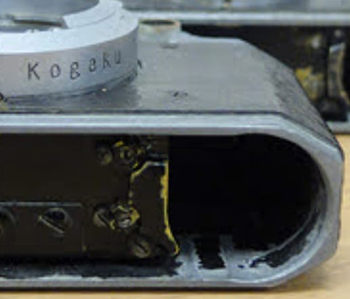 (Web image)
(Web image)
I have always been extremely dubious about the claims of milling, presumably from a solid billet, or die casting, an expensive process to set up and most suited to volume production. However, both Kannonji Makoto and Hayato Ueyama explain that these early bodies were sand cast and machined. Ueyama features such a body in his book, mount number 68 (shutter detail and wear is different to 6x mentioned above, i.e. different cameras). They note that sand casting is economical and well suited for prototypes and low volume production. Rather than being made for the Kwanon per se, Makoto also believes that all bodies were sand cast whilst limited production was based at the small workshop at Roppongi and only changed to the formed process with the move to the Meguro facility in June 1936 and the start of mass production. Dechert believes production started with mount 55 (Ueyama agrees), number 127 is 73 cameras on so at around 10 cameras production per month, that timeline is quite feasible. Makoto also claims that casting, pressing and plating were performed by subcontractors, Seiki Kogaku performing the machining, finishing and assembly.
Base Plates
The early base plates fitted to cameras up to mount 194, BP 1232, in my database feature a central tripod socket and blanked off indentation where the Kwanon's second magazine opening key would have been. In practice, this was a better design for use but perhaps more costly to make. Both Makoto and Ueyama believe the change was influenced by the development of the slow shutter, see above. Below are inside and outside views of first centre socket base plates and a later offset socket version, note standard 3/8” European thread of all examples (two cameras from near the end of production have Canon S style base plates, it is not known whether they are original or not). The key for most Hansa Canon examples (and following models to about 1946) base plate locks is designed so that it can only fold in one direction, but it seems that the very earliest examples of the centre tripod socket type featured the more common Leica style two way type - I've seen three (none in Peter Dechert's book), one of them is this base plate, number 1175 (camera mount number 113):

(Example from page 13, Camera Collectors' News, May 1982)
Later centre tripod socket:


Offset tripod socket:

 (Web images)
(Web images)
Note, the rectangular diversion in the side of the channel which is to clear the screw and tab for securing the shutter crate to the body - it's no longer there on the Canon S:
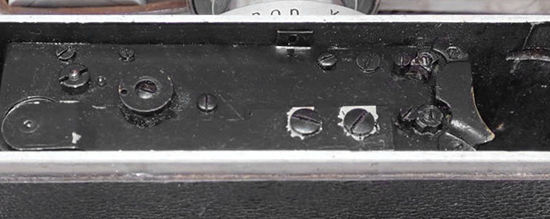 (Web image)
(Web image)
Nikkor Lenses
Approximately the first half of Hansa Canon cameras in my database feature a 50 mm Nikkor f/3.5 lens with “black face” with the aperture ring on the front:
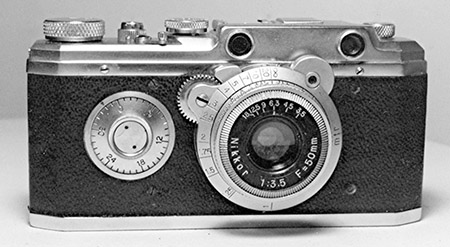 (Web image)
(Web image)
About the time that the Nippon Kogaku name disappeared from the mounts, these were replaced by a similar design 5 cm “white face” lens followed by the later Nikkor f/3.5 design on the right with outer aperture ring viewable from above (only fitted to some Hansa examples at the end of production):

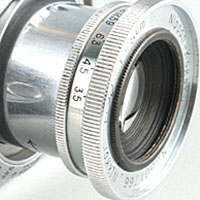 (Detail from larger web images)
(Detail from larger web images)
Earlier lenses were nickel plated, later ones chrome (Peter Dechert says from serial number 50540 onward).
Hansa Canon Kit
The items in the period Hansa Canon brochure are separately priced but some, or all, would have been included in the box. The camera with lens was priced at ¥275 with the lens ¥100 if sold separately:
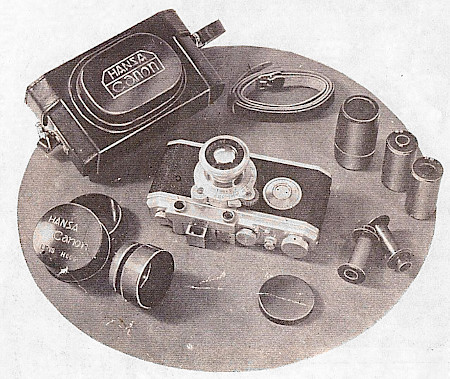
The “How to Use Canon” booklet found with several examples:
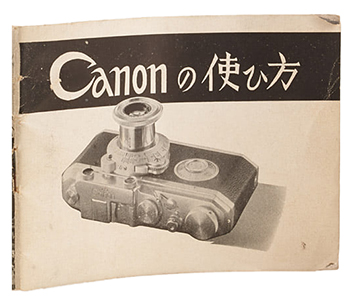
Pre-War Catalogues
Below is a 1936 Omiya Photo Supply catalogue (previously linked from the Japanese website https://w.atwiki.jp/saltysugar/pages/28.html, but the downloads from that site itself are no longer working). The covers and first 7 pages of content of the 78 page catalogue feature a very early version of the Hansa Canon with recessed viewfinder platform, first type shutter collar and rewind release lever and two way magazine/lock key:
(Click on cover for PDF download)
Note, whilst the commonly used Google translate app insists that the edition date on the cover is “year 10, month 10”, i.e. October 1935 (10 Showa = 1935), Canon camera collector and Japanese speaker Todd Belcher, has confirmed that it is fact “year 11, month 11”, i.e. the November 1936 edition (Todd says the app is reading the “10” but not the character for “1” which together make 11). This is consistent with Hayato Ueyama's book (slightly ambiguous because of three different covers shown) and the download site for the year.
Another catalogue on the site published by what seems like a store called Saneido, with the main store in Kanda, Tokyo, lists the Hansa Canon for ¥275, Leica Standard (without rangefinder) for ¥420, Leica III for ¥580, Contax (Contax I) for ¥600 and Contax II for ¥970, all with their basic f/3.5 lenses. On face value, the Hansa Canon was more than price competitive, but a very big negative compared to the German system cameras was that were no other focal length lenses offered for its unique mount, and wouldn't be for over 10 years, and accessories would also remain limited over that time.
Canon S
Production (Peter Dechert) |
Marketed (Canon) |
Slow Speeds |
Main Dial
|
Sync |
S/Timer |
1938/10-1945 |
1939/04 |
1-1/8 |
Z, 1/20-1/500 |
No |
No |
Serial Numbers |
||
Source |
From |
To |
| Peter Dechert | 10520 |
12500 |
| Found | 1055x |
1218x |
| Lens Mount: Bayonet in J mount focusing unit | |||
| Normal 50mm Lens (Peter Dechert): Nikkor f/2, f/2.8 or f/3.5, Canon adds f/4.5 | |||
| Found with Lens: | |||
| Lens | Description | Serial Numbers |
|
|---|---|---|---|
From |
To |
||
| Nikkor f/2 | Rigid | 502x |
5043x |
| Regno-Nikkor f/2 | Rigid | 5044x |
|
| Regno-Nikkor f/2 | Rigid | 140015A |
|
| Nikkor f/2.8 | Collapsible. White face | 5030x |
5015x |
| Nikkor f/3.5 | Collapsible | 50130x |
50223x |
| Nikkor f/4.5 | Collapsible. White face | 5018x |
5022x |
As noted earlier, Seiki Kogaku originally called this camera “Canon Newest Model”. When the Hansa Canon ended production, the new camera took over the mantle of “Canon Standard Model”, which was abbreviated to “Canon S” after the War (see also Canon NS which is known as the “New Standard Model”).
The Canon S updated the Hansa Canon design in order to implement the slow speeds introduced by the Leica III. The move of the film counter to the top deck under the film wind knob was made to provide more room for the slow speed dial whilst reducing complexity and assembly time, but necessitated a redesign of the full width top deck. A simplified, more Leica-like design was adopted which further reduced the work required. Due to the proximity of the toothed focusing wheel, a low profile slow shutter dial was used with a crank to make operation easier. A “normal” slow shutter dial located further away from the mount had apparently been trialled at the prototype stage but introduced unnecessary complexities and cost.
Peter Dechert says that production commenced in October 1938 but according to Hayato Ueyama, in one part of his book he says it was announced in November 1938 with only a prototype available, in another, in October 1938, but he claims that the production version with the slow shutter dial crank wasn't ready until 1939 which aligns more closely with Canon's “marketed” date of April 1939.
New f/2 and f/2.8 Nikkor 5 cm lenses were offered in addition to the existing f/3.5. Found in smaller numbers, there was also an f/4.5, originally developed for the Canon J model. The f/2 Nikkor was a 6 element Zeiss Sonnar design. Very early examples feature a front set aperture with a smallest stop of f/22, note the 4 digit serial number:

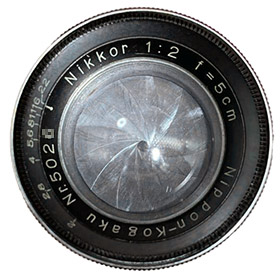 (Web images)
(Web images)
However, most feature an external aperture ring and minimum aperture of f/16. Additionally, there was also the uncommon f/2 Regno-Nikkor which has a minimum aperture of f/11 and was originally intended for use with X-Ray cameras, but due to War-time shortages, some were fitted to the Canon S bayonet mount barrels.
Surprisingly, Hayato Ueyama also claims that an f/1.5 lens was advertised. Earlier in his book, he matter of factly refers to the Nikkor f/1.5 several times in relation to X-ray camera development. I can find no other references anywhere to such a pre-War/War-time lens but I have wondered about the absence of a 5 cm f/1.5 Regno-Nikkor (for X-ray cameras) when f/1.5 seems to have been the preferred aperture size (at the start of the development of Japanese indirect X-ray photography, 20 f/1.5 Zeiss Sonnars were said to have been imported via submarine and there was Seiki Kogaku's own later f/1.5 R-Serenar). Of course, the lens may have just been an aspiration, Nippon Kogaku's role for the Japanese military machine was far more important than “wasting” resources on domestic camera lenses and maybe even X-ray camera lenses, other than its f/2 version. A mystery.
Canon S with later type standard Nikkor f/2 mounted (note, the tall mushroom shaped shutter guard is an accessory and features a new button with cable release thread - the same type is fitted to four Canon S examples and one JS in my database and also the Canon S II example on the Canon Camera Museum webpage):
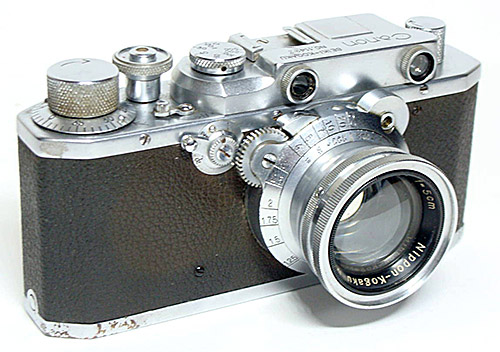 (Web image)
(Web image)
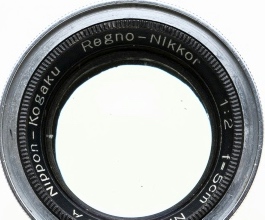
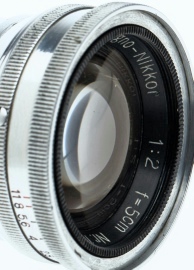
(Detail from larger web images)
Nikkor f/2.8:
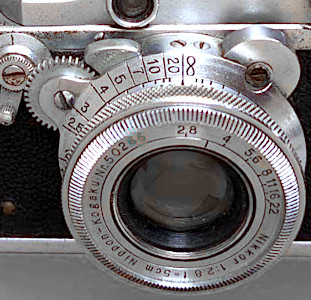 (Web image)
(Web image)
The base plate now looks more like later base plates but several things will change by the early 1950s. The lift-up “D” shaped locking key inherited from the Hansa Canon can still only lay flat in one direction and it wouldn't be until the Canon S II that the it could pivot down either way. It also features a European 3/8” tripod socket with the 1/4” socket first appearing on the Canon S II and becoming the most common type on II Bs. Also, the “S-O” dialogue will change to “Open-Close” with the Canon III:
 (Web image)
(Web image)
According to Peter Dechert, a very small batch of Canon S cameras was made with Imperial Japanese Navy markings in about 1942. They have their own serial numbers, those known to him were from 111 to 126, serial numbers that have surfaced more recently are 143, 167 and 170. Most/all were fitted with the Nikkor f/2 lens. Number 170 below, the mount number is 2540:
 (Japanese auction photo)
(Japanese auction photo)
There is a belief that is repeated on many websites that these were made for use on Japanese submarines. As most were destroyed during the War, it is said that it would explain the small number of these cameras found. Perhaps, but given the small number made, the War-time military environment and the circumstances of Japan's defeat, the fact that a number have surfaced (excuse the pun) suggests to me that there is nothing out of the ordinary about the ratio of found cameras to the total made.
Canon J
Production (Peter Dechert) |
Marketed (Canon) |
Slow Speeds |
Main Dial
|
Sync |
S/Timer |
1939/01-1941+ |
1939/04 |
None |
Z, 1/20-1/500 |
No |
No |
Serial Numbers |
||
Source |
From |
To |
| Peter Dechert | 1700 |
2125 |
| Found | 1707 |
204x |
| Lens Mount: J | |||
| Normal 50mm Lens (Peter Dechert): Nikkor f/4.5, some late Js with f/3.5 | |||
| Found with Lens: | |||
| Lens | Description | Serial Numbers |
|
|---|---|---|---|
From |
To |
||
| Nikkor f/3.5 | Collapsible | 50185x |
50222x |
| Nikkor f/4.5 | Collapsible. White face | 501x |
50364 |
The pre-War introduced models following the Hansa Canon continued to be different from Leica because of patent concerns. However, in Leica Standard fashion, the 1939 budget model Canon J without slow speeds also omitted the rangefinder, thus eliminating the need for the expensive Nikon focusing mount to avoid infringing Leica patents for the lens connection to the rangefinder and instead used the 39 mm 24 TPI screw mount directly in Leica fashion, but of course not being Leica compatible. This was referred to as the “J mount” and also used immediately post-War. The pop-up viewfinder of the earlier models was replaced by a simpler built-in more Leica-like type but with the top cover featuring a squared-off end next to the rewind lever to allow for its larger diameter than the more typical S model type. The lens was typically a Nikkor f/4.5 but when Nippon Kogaku ceased production of this later in the War, a few late examples were fitted with the Nikkor f/3.5 in a J mount barrel. Early example with f/4.5 lens:

(Mikio Awano's 1719 from the cover of Camera Collectors' News, see below)
Seiki Kogaku initially called this the “Popular Model”. According to Peter Dechert, some early orders referred to it as the “Junior” Canon but after the War, the abbreviation “J” stuck.
Mikio Awano (introduced in Links to the Good Stuff) wrote an article in the December 1977 edition of Camera Collectors' News about the three J models (J, JS, and J II). Even though he thinks that a military order may have been involved, the J model was well promoted in the marketplace. He included two short introductory articles to the camera, the first which appeared in the March 1939 edition of Asahi Camera and the second in an April 1939 magazine, the name of which translates as Photo Hokoku, and also the large ad below from the April 1939 Asahi Camera Spring Special Edition. To make sense of it, I have added translations of the main elements:
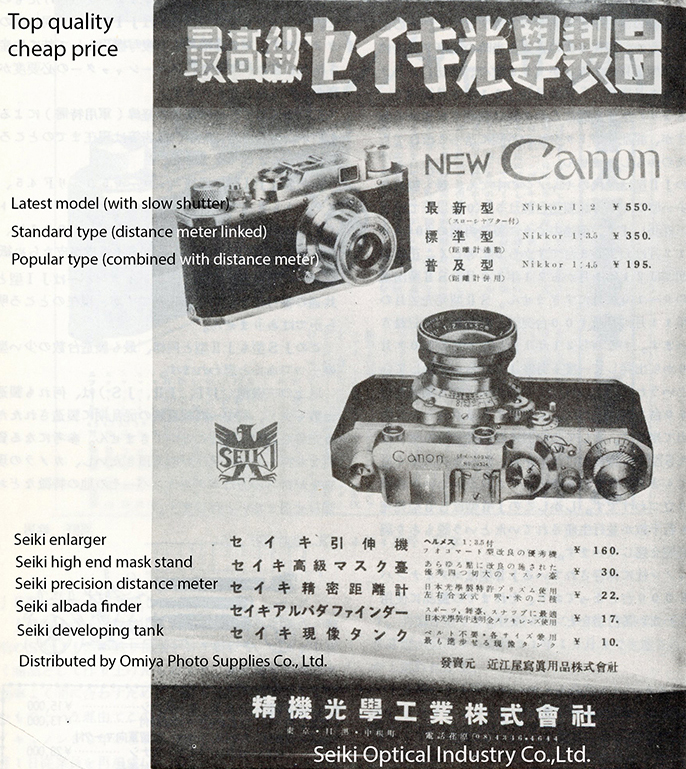
The price of the Canon J was almost half that of the Standard Model and one third of the Newest Model. Lower in the ad, Seiki Kogaku was willing to sell you an accessory (non-coupled) rangefinder for 22 yen. Note, the ad confusingly refers to “Popular type (combined with distance meter)” - was the accessory rangefinder included, was it just that the rangefinder was available, or is it the translation? With an f/4.5 lens, simply using the distance scale on the lens would be good enough for many use cases. Nevertheless, it was not a successful model with production probably of no more than a few hundred and after 1941, small numbers may have been made for military purposes only.
The example below has a fitting mounted that suggests that it may have been used as copy camera during the War.
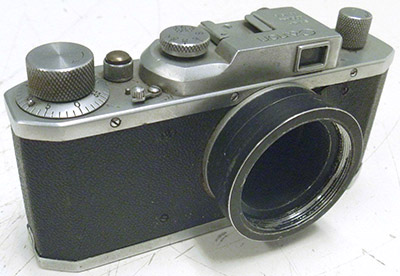
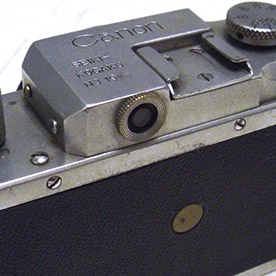
(Web images)
Canon NS
Production (Peter Dechert) |
Marketed (Canon) |
Slow Speeds |
Main Dial
|
Sync |
S/Timer |
1940/01-1942 |
1939/11 |
None |
Z, 1/20-1/500 |
No |
No |
Serial Numbers |
||
Source |
From |
To |
| Peter Dechert | 10800 |
11900 |
| Found | 1079x |
1156x |
| Lens Mount: Bayonet in J mount focusing unit | |||
| Normal 50mm Lens (Peter Dechert): Nikkor f/3.5 or f/4.5 | |||
| Found with Lens: | |||
| Lens | Description | Serial Numbers |
|
|---|---|---|---|
From |
To |
||
| Nikkor f/3.5 | Collapsible | 50138x |
50157x |
| Nikkor f/4.5 | Collapsible. White face | 503x |
|
| Nikkor f/4.5 | Collapsible. White face | 5025x |
5050x |
The Canon NS is a Canon S without the slow speed mechanism, or dial, and was to be a replacement for the Hansa Canon. According to Canon, it was introduced when the tax rate was significantly increased to support military expansion as war clouds were gathering, but wasn't a commercial success. According to Peter Dechert, advertisements described it as “Canon new standard model without slow speeds” and that “NS”, abbreviating “New Standard”, is a “recent suggestion”. He thinks that approximately 100 were made, as does Canon claim. According to Dechert, most were supplied with the f/4.5 lens, Canon says “Nikkor 50mm f/3.5 and others” and my database is 50% f/4.5 and 50% f/3.5. This one is the f/3.5:
 (Michaels' auction photo)
(Michaels' auction photo)
And this one is the f/4.5:
 (Web image)
(Web image)
Canon JS
Production (Peter Dechert) |
Marketed (Canon) |
Slow Speeds |
Main Dial
|
Sync |
S/Timer |
circa 1941 |
1939? |
1-1/8 |
Z, 1/20-1/500 |
No |
No |
Serial Numbers |
||
Source |
From |
To |
| Peter Dechert | 1900 |
2130 |
| Found | 196x |
210x |
| Lens Mount: J | |||
| Normal 50mm Lens (Peter Dechert): Nikkor f/4.5 | |||
| Found with Lens: | |||
| Lens | Description | Serial Numbers |
|
|---|---|---|---|
From |
To |
||
| R-Serenar f/1.5 | Rigid | 303x |
|
| Nikkor f/4.5 | Collapsible. White face | 5044 |
50118 |
The Canon JS is a Canon J with added slow speed mechanism and dial. According to the Canon Camera Museum, it was intended for close-ups, photomicrography, astrophotography and other special applications which required slow shutter speeds and didn't benefit from the rangefinder of the S model. Canon claims that it was released pre-War, Peter Dechert says that it was never advertised and thinks that it was mainly War-time production for the Japanese Army as a possible copy camera. He believes that no more than 50 were made. Mikio Awano is of a similar opinion.

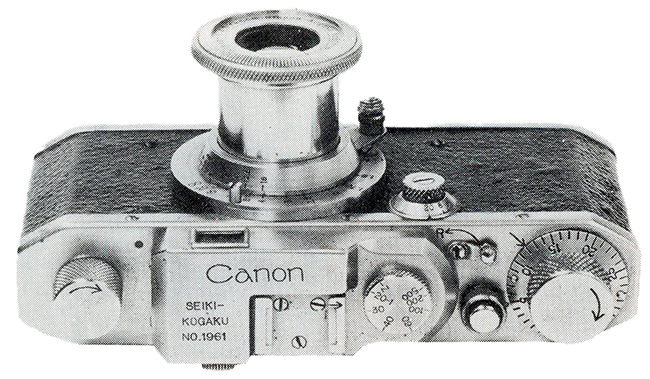
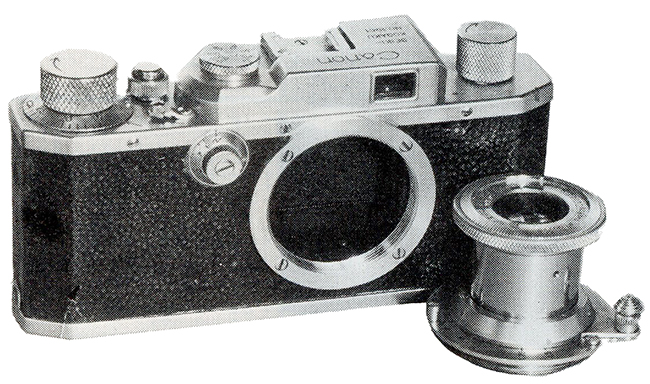
(Images are of Mikio Awano's No. 1961, from his December 1977 Camera Collectors' News article)
Peter Dechert also mentions JS examples found with the R-Serenar 5cm f/1.5 X-ray camera lens rehoused in J mount focusing barrels with diaphragms. Whilst most of these lenses were renamed “Serenar”, this unloved one retains its “R-Serenar” name:
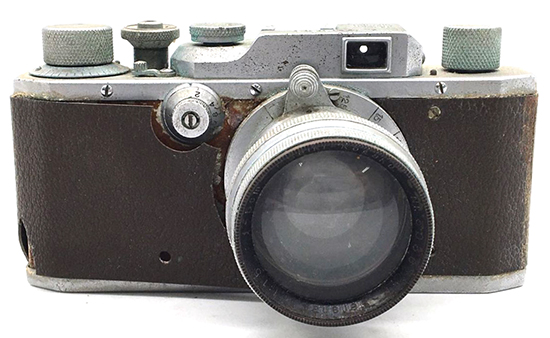
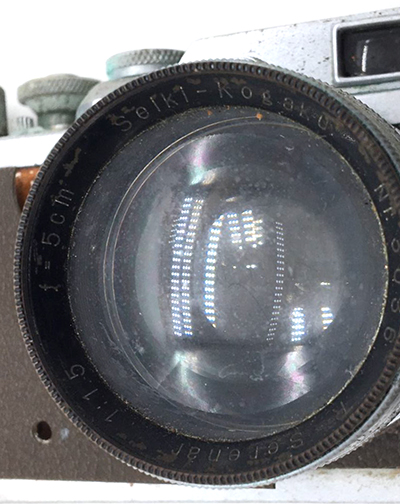
(Web images)
Hayato Ueyama was told that this version was intended for reconnaissance aircraft but has seen actual evidence of them being fitted out for oscilloscope photography. Either, or both, could be correct. See Serenar Lenses.
Canon J II
Production (Peter Dechert) |
Marketed (Canon) |
Slow Speeds |
Main Dial
|
Sync |
S/Timer |
1945/12-1946/11 |
1946/01 |
None |
Z, 1/20-1/500 |
No |
No |
Serial Numbers |
||
Source |
From |
To |
| Peter Dechert | 8000 |
8700 |
| Found | 803x |
856x |
| Lens Mount: J (early) & modified J (late) | |||
| Normal 50mm Lens (Peter Dechert): Nikkor f/3.5, a few with Serenar f/3.5 | |||
| Found with Lens: | |||
| Lens | Description | Serial Numbers |
|
|---|---|---|---|
From |
To |
||
| Nikkor f/3.5 | Collapsible | 50199x |
50223x |
| Nikkor f/3.5 | Collapsible | 5707x |
7041x |
| Nikkor f/3.5 | Collapsible | 46020x |
46021x |
| Serenar f/3.5 | Collapsible. Seiki Kogaku | 801x |
811x |
In order to get production going again, the post-War Canon J II featured the Canon J specs using mainly Canon S parts. This initially used up War-time parts stocks and were easiest and quickest to assemble into saleable cameras. The slow speed mechanism and dial were omitted and a plate with three screws was mounted over the hole for the dial. The viewfinder/rangefinder housing used the model S blank with the end wrapping around the smaller diameter S rewind knob.
The supplied lens was typically the Nikkor 5 cm f/3.5 (the f/4.5 had been discontinued earlier in the War) but according to Peter Kitchingman, it seems that some early Serenar f/3.5 lenses may have been made for the J mount from as early as December 1945. These were already range finder coupled, apparently in preparation for their implementation on future bodies.
In his December 1977 Camera Collectors' News article, Mikio Awano quotes from two articles which state that Seiki Kogaku reorganised its workforce on 1 October 1945 and restarted production with a total of 156 employees with sales restarting in December. In the beginning, production was very slow with only three J II cameras completed by the end of 1945. Production continued until November 1946. According to Peter Dechert, Canon records indicate 506 were made but other lists suggest only 164 completed.
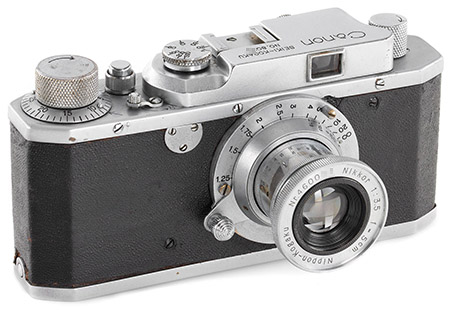 (Web image)
(Web image)
Because of the pop-up viewfinder, the Canon S had the maker name and serial number next to the model name. The Canon J on the other hand featured the shortened squared-off viewfinder/rangefinder housing without pop-up viewfinder and therefore the maker name and serial number moved to under the model name. With the model S housing, the J II reverted to the side-by-side layout up to somewhere between serial numbers 8078 and 8158 (see above photo) after which the details moved to below the name:
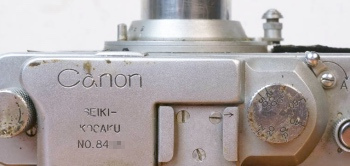 (Web image)
(Web image)
Canon S I
Production (Peter Dechert) |
Marketed (Canon) |
Slow Speeds |
Main Dial
|
Sync |
S/Timer |
1945/12-1946/11 |
1946/01 |
1-1/8 |
Z, 1/20-1/500 |
No |
No |
Serial Numbers |
||
Source |
From |
To |
| Peter Dechert | 12386 |
14160 |
| Found | 1228x |
1254x |
| Lens Mount: Bayonet in J mount focusing unit | |||
| Normal 50mm Lens (Peter Dechert): Nikkor f/3.5 | |||
| Found with Lens: | |||
| Lens | Description | Serial Numbers |
|
|---|---|---|---|
From |
To |
||
| Regno-Nikkor f/2 | Rigid | 14113x |
|
| Nikkor f/2.8 | Collapsible. White face | 5021x |
|
| Nikkor f/3.5 | Collapsible | 50203x |
50209x |
The Canon S I is the Canon S produced after the War at the same time as the Canon J II. However, unlike the J II, it appears to be physically identical to late War-time production and much the same as when released. Both Canon and Hayato Ueyama claim that rather than manufactured, the S I was simply assembled from leftover pre-War and War-time parts and Ueyama notes that because parts were pre-numbered, it is difficult to identify where a model precisely belongs. Peter Dechert says that “S I” was Seiki Kogaku's name for the model but these days, the Canon Camera Museum is a little more ambivalent, referring to it as simply “S”, followed by 1946, on the model chart whilst clicking on it brings up the detailed description with the “S I” model name. According to Canon's records, 97 made. Ueyama notes that any Nikkor f/2 lens fitted to these cameras was likely to be the Regno variety and this seems to be borne out by my database.
Canon S II
Production (Peter Dechert) |
Marketed (Canon) |
Slow Speeds |
Main Dial
|
Sync |
S/Timer |
1946/10-1949/06 |
1946/10 |
1-1/8 |
B, 1/20-1/500 |
No |
No |
(Main shutter dial is marked B, 20-1, 30, 40, 60, 100, 200 and 500)
Serial Numbers |
||
Source |
From |
To |
| Peter Dechert | 15000 |
23375 |
| Found | 1504x |
2362x |
| Lens Mount: Semi-universal (some J & experimental mounts) | |||
| Normal 50mm Lens: (Peter Dechert): Serenar f/2, f/3.5 or Nikkor f/3.5 |
|||
| Found with Lens: | |||
| Lens | Description | Serial Numbers |
|
|---|---|---|---|
From |
To |
||
| f/2 Serenar | Collapsible. Seiki Kogaku | 20003 |
2010x |
| f/2 Serenar | Collapsible. Canon Camera Co. | 2023x |
2156x |
| f/3.5 Serenar | Collapsible. Seiki Kogaku | 812x |
921x |
| f/3.5 Serenar | Collapsible. Canon Camera Co. | 961x |
1343x |
| f/3.5 Serenar | Collapsible. Canon Camera Co. | 8325x |
8347x |
| f/3.5 Nikkor | Collapsible | 57079x |
57101x |
| f/3.5 Nikkor | Collapsible | 610x |
|
| f/3.5 Nikkor | Collapsible | 6107x |
6108x |
| f/3.5 Nikkor | Collapsible | 70540x |
|
The first post-War designed model was the Canon S II released in October 1946. Ad from Camera times of 20 December 1947, by then the first accessory lens, the 135 mm f/4, had also been released and the maker name had changed to Canon Camera Co., Ltd.:
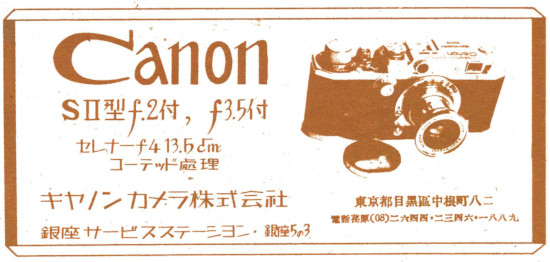
According to Hayato Ueyama, the prototype was completed in November 1945. Hidehiko Taguchi, who had recently transferred from Nippon Kogaku and had lead the design, described it as “the post-war model J with a rangefinder and slow shutter”. The S II featured Seiki Kogaku's first major innovation - the rangefinder and viewfinder were combined and there was a single viewfinder window. It was also the first Seiki Kogaku designed and manufactured rangefinder. However, with a short 38.5 mm rangefinder base length and 0.6x magnification giving an EBL of 23.1 mm, it was less than ideal from an accuracy viewpoint.
There was a small number of early Canon S II examples with the J lens mount but most featured the new “semi-universal” thread which is somewhere between the J mount's 24 and Leica's 26 TPI and would accept both J mount and most Leica lenses as well (see “Semi-universal Mount under ” Lens Mounts).
This example is probably from 1948, almost exactly halfway through the production run and from after the two major updates experienced by this model, the maker name change and body construction:
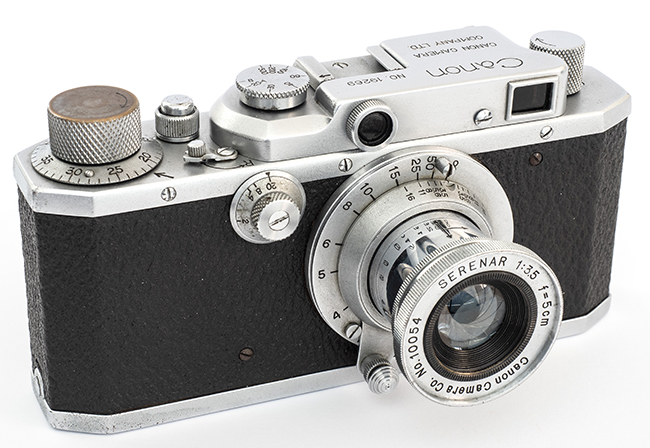
This was the first Canon model without the focus adjustment plug in the camera's back, although some early ones still have a hole in the pressure plate, probably remaining parts from earlier models:
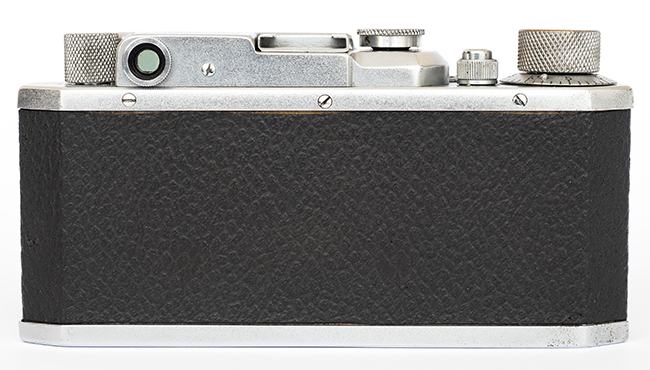
The top view is a typical Leica III layout. The accessory shoe side rails have lost the pressure depressions first introduced by the model S and as mentioned, this example already features the later maker name:
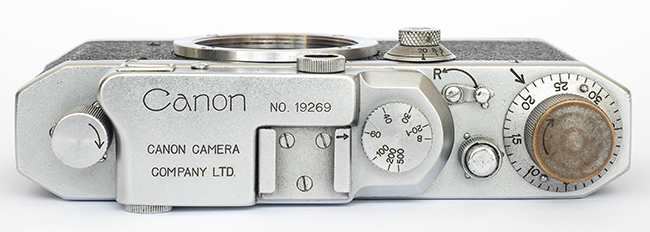
From now on, the base plate features a locking key that can fold flat in either direction, last seen on very early Hansa Canon examples and also some J II examples (perhaps borrowing from early S II production). As far as I am aware, until now, the tripod sockets had been the European standard 3/8”, as this one, but 1/4” started to appear with later production.:
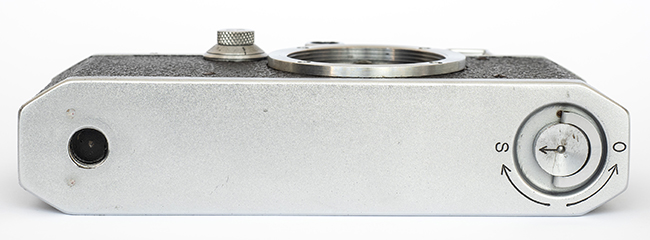
The other major change during production was the introduction of a stronger and more accurate die-cast body shell. Just slightly later, the four blind rivets securing the channel section inside the bottom plate (see further below) were replaced by non-mechanical attachment means (perhaps brazed?):
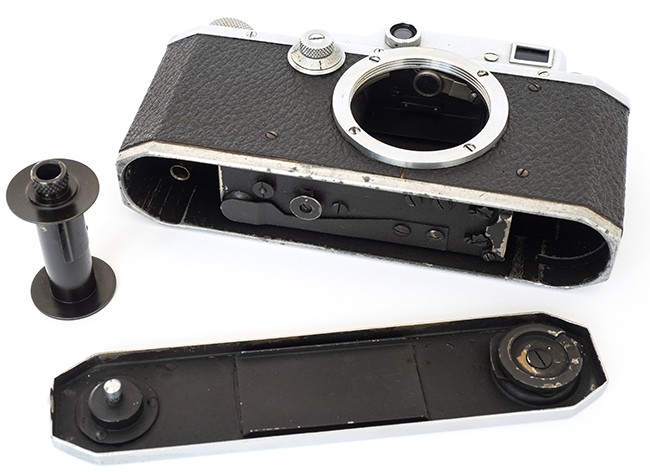
Maker Name Change
The company name officially changed on 15 September 1947. Generally speaking, until somewhere between serial numbers 1685x and 1693x according to my database, the maker name marked on the camera was “Seiki-Kogaku Tokyo” after which it became “Canon Camera Company Ltd.” However, there are also 4 earlier examples in my database with the Canon maker name mixed in between Seiki Kogaku named cameras, with serial numbers 1561x to 1595x, followed by another 14 cameras still with the Seiki Kogaku name. Hayato Ueyama explains that this happened because the company outsourced engraving to a number of subcontractors and some were quick and some were slow to return the top covers:
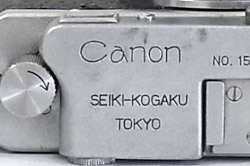
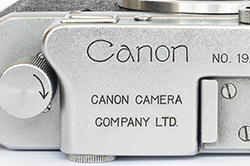
(Left detail from larger web image)
Body Shell
Between camera 1746x and 1784x, Canon changed construction of the body shells from forming to shape to the more accurate and stronger die-casting. Formed body on top with even thin thickness all around, note also the base plate channel section secured by four blind rivets, die-cast below with cylindrical internal ends, angular on the outside:

(Web image)
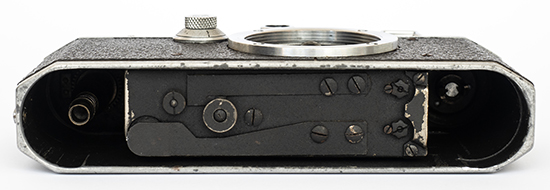
MIOJ and <CPO> Mark
In my database, there is the occasional base plate marked “Made in Occupied Japan” (MIOJ) beginning with serial number 1624x and becoming increasingly common until by 2021x, all have the marking:

(Web image)
A few late 1948 cameras also feature the <CPO> mark before changing to the <シーピーオー> version in early 1949 (see B II example).
Lenses
As in the ad further above, the usually supplied lenses were the new Seiki Kogaku Serenars (rebranded from Seiki Kogaku to Canon in October 1947), the f/3.5 (based on then current Nikkor Tessar design) and slightly later released f/2 5 cm (a Gauss based design quite different to the Nikkor Sonnar type), but early on, there were still some Nikkor f/3.5 lenses too. Canon branded f/3.5 Serenar on left, f/2 on right:
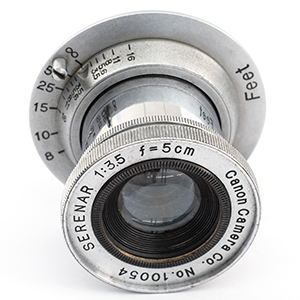
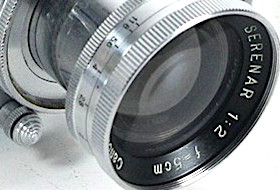
(Web image on right)
Canon S II with coated Nikkor f/3.5 5 cm lens from the October 1946 batch:
 (Web image)
(Web image)
Shutter Dial Markings
Before the S II, the main shutter dial had featured the German “Z” marking for bulb, now changing to “B”. Most S II examples are marked “B” but the four earliest examples in my database, the last being 1527x, plus a couple of random later ones, are still marked “Z”. Also, late camera, 2207x, and the last four S II examples in my database, 23335x, 2343x, 2360x and 2362x have the “20-1” marked on the main dial, the “20” on the slow speed dial and the “0” on the frame counter picked out in red, like the following II B. “Z” version found on some early examples, typical all black “B” version found on most S II examples in middle, red infill on main dial example on right:
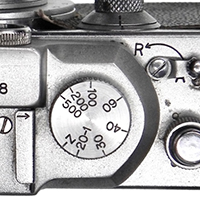
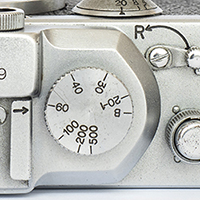
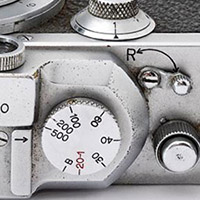
(Left and right detail from larger web images)
Canon II B
Production (Peter Dechert) |
Marketed (Canon) |
Slow Speeds |
Main Dial |
Sync |
S/Timer |
1949/01-1952/07 |
1949/04 |
1-1/8 |
B, 1/20-1/500 |
No |
No |
Serial Numbers |
||
Source |
From |
To |
| Peter Dechert | 21050 |
42400 |
| Found | 25002 |
4184x |
(Note: Dechert's 21050 is a prototype, he doesn't mention the first production cameras but the range is likely to start with 25000)
| Lens Mount: Semi-universal (maybe some late Universal ones) | |||
| Normal 50mm Lens (Peter Dechert): Serenar f/1.9 or f/3.5 |
|||
| Found with Lens: | |||
| Lens | Description | Serial Numbers |
|
|---|---|---|---|
From |
To |
||
| f/1.9 Serenar | Collapsible. Canon Camera Co. | 2094x |
3937x |
| f/3.5 Serenar | Collapsible. Canon Camera Co. | 1187x |
1505x |
The real innovation and major success came with the next model, the 1949 Canon II B (initially called the S IIb), which cleverly used a rotating prism to add three level magnification to the viewfinder of the S II. 1950 II B 33603 with early features:

The most commonly supplied lens was the new f/1.9 5 cm, basically a recomputed version of the f/2 released for the Canon S II, although the Serenar f/3.5 remained as a budget alternative. The f/1.9 lens ushered in the change to millimetre markings but the first f/3.5 lenses fitted to early S II examples used up the last of the centimetre marked stock.
Strap lugs were also added for the first time:



A new four screw accessory shoe with springs replaced earlier models' plain 3 screw type and the “20-1” marking on the main shutter dial, the “20” on the slow speed dial and the “0” on the frame counter were given a red infill instead of the uniform black numerals (hard to see on some examples, particularly earliest):

The 1.5x magnification provides the most accurate focusing and the approximate view of a 135 mm lens, the 1x magnification provides the approximate view of a 100 mm lens and the F position equates to 0.67x magnification and provides the view of a 50 mm normal lens:

In 1950, somewhere between serial numbers 35000 and 37000 in my database (Peter Dechert narrows it down to around 36000), Canon introduced a process to darken the natural alloy around the bottom lip of the body shell. After years of use, the difference is subtle in some photos, one of the reasons that I am not prepared to narrow the range. Natural 1950 body 33603 on bottom, darkened 1952 body 41005 on top:

Earlier Canon II B base plate, serial number 26256, with both MIOJ marking and red katakana version of the CPO mark, <シーピーオー>:
 (Image courtesy of Mohsen Saade)
(Image courtesy of Mohsen Saade)
The last Canon in my database with the CPO mark is II B 2936x. From between serial numbers 3894x and 3933x onward, base plates were no longer marked MIOJ (introduced with the Canon S II). Most Canon II B examples feature the 1/4” tripod socket rather than the earlier 3/8”:
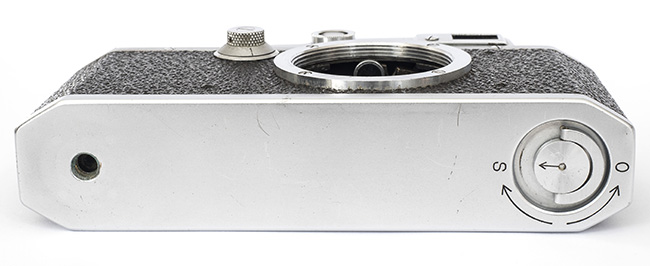
A minor change during production was that the screw in the rear of the viewfinder/rangefinder housing lined up with the screw below it in the top plate in cameras before 3966x, as in the camera above, and in front below, and lined up with the centre of the accessory shoe in later cameras after 3972x, as in the late camera below. The change was introduced by the new Canon III and IV and reflected the fact that even though there were still stocks of some older parts for the II B to use up, other parts were shared amongst models and hence updated:

The earliest found standard Canon II B is Peter Kitchingman's 25015, however, there is also Canon's early testbed, serial number 25002, used for developing rail mount synchro flash which debuted on the Canon IV-1950 trial series. The rail looks like the final item, the sync mechanism under the cover plate is familiar but different in detail to the Canon IV-1950 and later iterations. It also features unique strap lugs. In addition to its normal markings it is marked “Exp Model” on top between the “Canon” name and “Canon Camera”, presumably meaning “Experimental Model”. On the back edge of the top plate is marked “設.試.C.8”. The owner, Herbert Schlicker, translates the kanji text as “design and test”, Google translate suggests both “establishment trial” and “setup and tested”, another translator goes with “facilities.trial”. In any case, the characters are identical to those on a Serenar 50mm f/1.4 prototype lens made before being released as an f/1.5 lens and sold at Leitz Auction no. 46 (see Serenar Lenses). The Leitz Auction text translation is “Test Sample”. More on this camera, including a comparison of the sync mechanism with later models, can be found on the Facebook page of the Canon Historical Society.
Canon 1950 (trial series Canon III & IV)
Production (Peter Dechert) |
Marketed (Canon) |
Slow Speeds |
Main Dial
|
Sync* |
S/Timer |
1950/07-1950/10 |
T, 1-1/8 |
B, 1/25-1/1000 |
M/FP |
No |
(*Sync: Slow speed sync at 1/8 and below is for M class and other peak type bulbs as well as FP, high speed sync is for FP bulbs at 1/25 and above)
Serial Numbers |
||
Source |
From |
To |
| Peter Dechert | 50000 |
50199 |
| Found | 5005x |
5017x |
| Lens Mount: Semi-universal | |||
| Normal 50mm Lens (Peter Dechert): Serenar f/1.9 |
|||
| Found with Lens: | |||
| Lens | Description | Serial Numbers |
|
|---|---|---|---|
From |
To |
||
| f/1.9 Serenar | Collapsible | 2592x |
3873x |
The “Canon 1950”, 1950 being the year of its appearance, is the name given to the trial series of the Canon IV, which was later discovered to also include Canon III cameras. They shared all the important new features including a new shutter with 1/1000 top speed, a cross over speed of 1/25 instead of the old 1/20 and a “T” for Time setting for the first time. The shutter included a flash synchronisation mechanism for flashbulbs on the IV version, a first for Canon, and a side mounting rail with direct “hot shoe” type connection. There was also a new rewind release mechanism mounted on a raised platform.
Although Canon documents suggest the facility commenced with Canon III serial numbers, the take-up shaft on the bottom of the shutter crate was notched to allow use of the newly developed Canon Rapid Winder baseplate patterned on the Leitz Leicavit.
Like the Canon 7sZ, the Canon 1950 name is another Peter Dechert invention. In his book, he was aware that it was a trial series for the forthcoming Canon IV with flash sync. He thought that most of the 50 or so examples produced were shipped to new US importer, C. R. Skinner Manufacturing Co., for sale. He also believed that Canon confusingly called the camera Canon II C before reusing the name for a later unsynced model. The II C camera and new Flash Unit X are pictured in a C. R. Skinner ad in the February 1951 edition of US magazine, Photography.
However, in a 2006 article for Shutterbug, he updated his understanding as a result of what he had learnt since 1984. Production had been higher than 50 and probably closer to the 200 suggested by the serial numbers. Around 50 had been sent to C. R. Skinner for sale but some had been kept by Canon, presumably for further testing and marketing purposes (also used for some of the photos in the subsequent user manuals) and some had been issued to experienced photographers for evaluation. Also, some of the cameras were unsynced but had most of the new features and therefore appeared to be trial versions of the Canon III (their serial numbers appear to be at the end of the 200 number range). In this context, he considered the “Canon 1950” name a mistake and proposed three separate names “Canon IV-1950” (for testing and evaluation cameras), “Skinner Canon IV-1950” and “Canon III-1950”.
Also, rather than Canon naming the cameras Canon II C, he now believed that in the absence of any guidance from Canon, Skinner had given its allocation that name as the camera followed the II B.
There were some minor, mainly cosmetic variations in this period but by and large, the cameras are hard to tell apart from the following Canon III and IV except for their serial numbers and maker names. According to Peter Dechert, the 1950 models still feature “Canon Camera Company, Ltd.” on the viewfinder/rangefinder housing, except for the last few, whilst the Canon III and IV examples reflect the early 1951 change to “Canon Camera Co., Inc.” One of the “last few” Canon III-1950 examples (note the serial number 5019x) with the updated maker name:
 (Detail from larger web image)
(Detail from larger web image)
The Skinner Canon IV-1950 models featured a base plate marked: “MADE IN OCCUPIED JAPAN/SERVICED AND GUARANTEED IN SAN FRANCISCO CALIFORNIA”.
 (Detail from Peter Dechert's 2006 Shutterbug article)
(Detail from Peter Dechert's 2006 Shutterbug article)
Canon III
Production (Peter Dechert) |
Marketed (Canon) |
Slow Speeds |
Main Dial
|
Sync |
S/Timer |
1951/02-1952/12 |
1951/02 |
T, 1-1/8 |
B, 1/25-1/1000 |
No |
No |
Serial Numbers |
||
Source |
From |
To |
| Peter Dechert | 50200 |
81850 |
| Found | 5060x |
8102x |
| Lens Mount: Semi-universal (maybe some late Universal ones) | |||
| Normal 50mm Lens (Peter Dechert): Serenar f/1.9 or f/3.5 |
|||
| Found with Lens: | |||
| Lens | Description | Serial Numbers |
|
|---|---|---|---|
From |
To |
||
| f/1.9 Serenar | Collapsible | 3706x |
4894x |
The Canon III was an improved II B, the main change being the new shutter with 1/1000 speed, 1/25 cross over and T setting on the slow dial with the marked speeds now:
Front Dial: T, 1, 2, 4, 8 and 25
Main Dial: B, 25-1, 40, 60, 100, 200, 500 and 1000
It also added the ability to use the new Rapid Winder baseplate with a notch added to the take up spindle to connect to the lug on the Rapid Winder (later model with finer leatherette pattern pictured):
 (Detail from larger web image)
(Detail from larger web image)
A revised body shell for all new models featured a groove near the bottom of the shell from under the lens mount to where the flash sync connector would be installed on sync'd models. This was to enable the wiring to be installed under the leatherette. On non-sync'd models, like the Canon III, the groove and hole for the flash sync fitting was filled with a white grout (badly corroded Canon II D pictured):
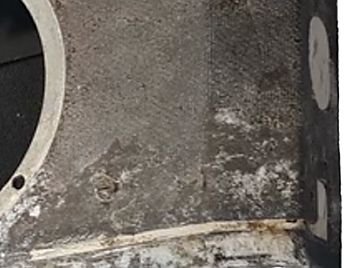 (Web image)
(Web image)
The new shutter was given a bottom cover plate for the first time allowing a warning label about the length of the the film leader to be included. As well as tidying things up, its main purpose was to protect the sync components of sync'd models. The body shell lip was also given a black finish instead of the dark grey of the II B:
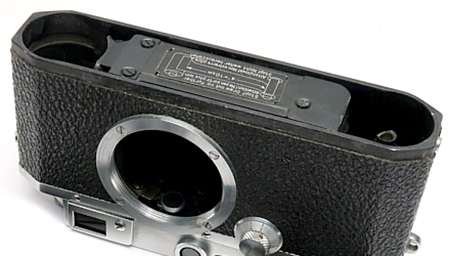 (Web image)
(Web image)
It also introduced the revised maker name, the earlier “Canon Camera Ltd.” becoming “Canon Camera Company Inc.” The well received Canon film take-up spool with spring loaded pop-up grip arrived shortly after release and was later copied by Leica (see IV Sb model). Early Canon III, note also the new raised platform under the rewind release lever and new mushroom shaped shutter collar. Whilst it can be unscrewed as before, it doesn't need to be for Canon Self-timers up to III, or other self-timers and cable releases using a Leica style connector, or “Leica nipple”:
 (Detail from larger web image)
(Detail from larger web image)
Late Canon III, note “Japan” and red dot film plane mark added under the maker name (they didn't arrive at the same time). For a period of maybe 12 months or less, a few cameras were also marked “Made in Japan” on the base plate. This one still has two of the three features that separate the III from the later III-A; the old style knurling on the film wind and rewind knobs and no film reminder, but it does have the new type magnification lever of the III-A. Peter Dechert calls these transition cameras “hybrids”. With these, the mix of parts can involve any of the three variables, deciding which model it is depends on majority rule:
 (Detail from larger web image)
(Detail from larger web image)
With the Canon III, the base plate lock/magazine key dialogue changed from the previous “S-O” to “Open-Close”. This example also features “Made in Japan” whilst the late camera itself has the new “Japan” marking on the top plate (but not red dot film plane mark yet) even though it is not one of the hybrids:
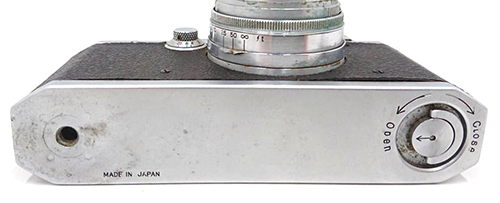
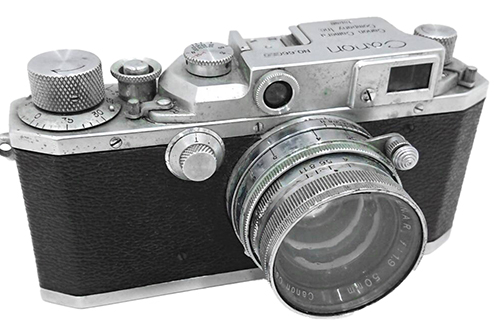 (Web images)
(Web images)
Canon II-C
Production (Peter Dechert) |
Marketed (Canon) |
Slow Speeds |
Main Dial
|
Sync |
S/Timer |
1951/03-1951/08 |
1950/07 |
T, 1-1/8 |
B, 1/25-1/500 |
No |
No |
Serial Numbers |
||
Source |
From |
To |
| Peter Dechert | 50200 |
57850 |
| Found | 5029x |
5550x |
| Lens Mount: Semi-universal | |||
| Normal 50mm Lens (Peter Dechert): Serenar f/1.9 or f/3.5 |
|||
| Found with Lens: | |||
| Lens | Description | Serial Numbers |
|
|---|---|---|---|
From |
To |
||
| f/1.9 Serenar | Collapsible | 3969x |
3984x |
The Canon II-C was the economy version of the Canon III, only differing from it by having a shutter top speed of 1/500. It makes sense that according to Peter Dechert, production started in March 1951, one month after the III. However, the Canon Camera Museum tells a different story. It claims that the II-C was “marketed” in July 1950, some 8 months before the III, and that the improvements over the II B were incorporated into subsequent models:
“Based on the II B, this camera had a T time exposure setting (pressing the shutter button once started the exposure and pressing it again stopped it) and slow shutter speed dial with click stops to prevent inadvertent rotation. The two shutter speed dials were split at 1/25 sec. The shutter release guard was larger for easier shutter button depressing. (These features were retained in later models.)”
In fact, Canon claims that the Canon III is an “improved version of the Canon II-C” and that “the III had a shutter curtain which remained at a fixed position even after the film was advanced”. I'm dubious of the Canon story, the II-C and III share the same start to their serial number ranges, and hence probably similar release times, and the early release of the II-C also doesn't fit what we know about the Canon III and IV trial series, Peter Dechert's “Canon 1950”. However, there isn't enough evidence to confidently decide one way, or the other. More interestingly, Canon claims that the optical performance of the II-C's 50 mm f/1.9 Serenar was improved - whether that was introduced on the II-C or III is immaterial, it would have applied to all future production. This is what Canon has to say:
“Although the fast Serenar 50mm f/1.9 lens which came with the II B was well received, people noticed lackluster performance at the maximum aperture. This was caused by the coma characteristic of Gauss-type lenses. Hiroshi Ito, who just joined the company, worked to improve the lens. He succeeded with a correction method that reduced the coma. Canon continued to employ him for lens design.”
With the II B continuing in production, the similar specs meant that there was little appetite to pay a premium for the improved model with new shutter and production only lasted 5 months with 800 made. The II-C improvements over the II B are the 1/25 cross over speed, the raised platform for the release lever and the mushroom shaped shutter button surround (it's similar to the later II-D but that has the die-cast shutter crate and the giveaway revised knurling on the knobs and one piece magnification lever):
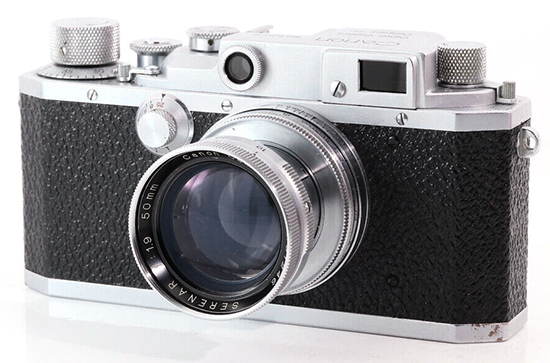 (Web image)
(Web image)
Peter Dechert tells us that many II-Cs featured 3/8" tripod sockets with expectation of European sales. I have found some, but probably more 1/4” types. It may have been the 3/8” socket's last appearance.
Canon IV
Production (Peter Dechert) |
Marketed (Canon) |
Slow Speeds |
Main Dial
|
Sync* |
S/Timer |
1951/04-1952/04 |
1951/04 |
T, 1-1/8 |
B, 1/25-1/1000 |
M/FP |
No |
(*Sync: Slow speed sync at 1/8 and below is for M class and other peak type bulbs as well as FP, high speed sync is for FP bulbs at 1/25 and above)
Serial Numbers |
||
Source |
From |
To |
| Peter Dechert | 51270 |
67825 |
| Found | 5124x |
6112x |
| Lens Mount: Semi-universal (maybe some late Universal ones) | |||
| Normal 50mm Lens (Peter Dechert): Serenar f/1.9 |
|||
| Found with Lens: | |||
| Lens | Description | Serial Numbers |
|
|---|---|---|---|
From |
To |
||
| f/1.9 Serenar | Collapsible | 3475x |
4697x |
The Canon IV was the flash sync version of the Canon III, the pair being issued as a limited trial series in 1950 before its formal release in 1951. Whilst it already looks similar to later flash sync'd models, it still has the first type magnifier lever and no film type reminder:
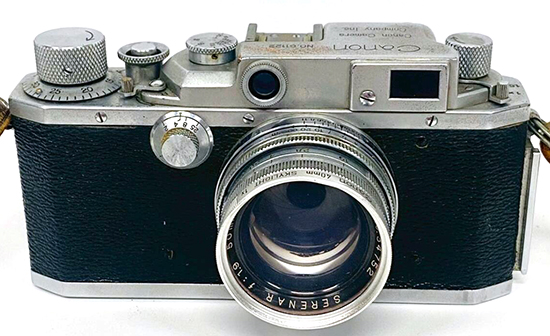 (Web image)
(Web image)
The flash sync mechanism was for flashbulbs only and operated via a contact in the side rail used for mounting the flashgun. Its companion flash unit was the Flash Unit X, the centrepiece of a comprehensive flash system. Canon IV and flash unit on cover of instruction manual:
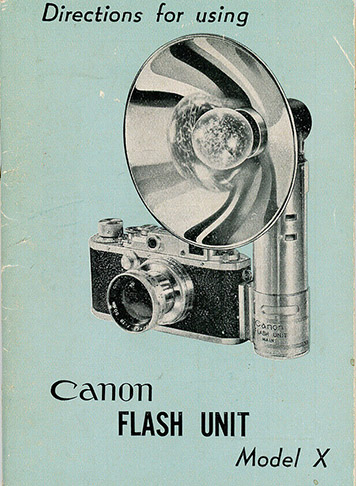 (Web image)
(Web image)
Note: In early 1953, US sales agent, Balfour, Guthrie & Co., Ltd., announced a free conversion of Canon IV cameras to IV-S2, i.e. adding zero second advance for electronic flash. A few months later, there was a second announcement that the temporary arrangement had been replaced by “a new official Canon Service Agency”, Professional Camera Repair Service. Undoubtedly, some Canon IV, IV-F and IV-S cameras have been converted. Presumably, these will now have slow speed shutter dial with “X” position.
Canon III-A
Production (Peter Dechert) |
Marketed (Canon) |
Slow Speeds |
Main Dial
|
Sync |
S/Timer |
1951/12-1953/09 |
1951/04 |
T, 1-1/8 |
B, 1/25-1/1000 |
No |
No |
Serial Numbers |
||
Source |
From |
To |
| Peter Dechert | 61150 |
105800 |
| Found | 6372x |
8973x |
| Lens Mount: Universal | |||
| Normal 50mm Lens (Peter Dechert): Serenar f/1.8 or f/3.5 |
|||
| Found with Lens: | |||
| Lens | Description | Serial Numbers |
|
|---|---|---|---|
From |
To |
||
| f/1.8 Serenar | Rigid | 6223x |
7965x |
At first appearance, the Canon III-A is largely a cosmetic update of the Canon III with new knurling on the film wind and rewind knobs, film speed reminder in the top of the film winding knob and new single piece magnification lever:
 (Detail from larger web image)
(Detail from larger web image)
Other changes that occurred during its life include the addition early on of “Japan” to the viewfinder/rangefinder cover (already there on late Canon III examples), the addition of a red dot to the right of “Japan” to indicate the film plane, a new high speed shutter dial with clearer numbers and significantly, a new die-cast shutter crate. Previously fabricated from a number of different parts, the die-cast version made assembly easier whilst improving rigidity and uniformity of production.
There is a significant discrepancy between Peter Dechert's claimed production dates and Canon's marketing, or release, dates, Peter Dechert claiming production started in December 1951, same as for the IV F, and Canon saying that the marketing date was April 1951, some 6 months before the production date but also 9 months before the IV F was released. Without access to Canon's records, there is no way to confirm one way or the other, however, whilst Peter Dechert says that the III-A and IV-F jointly introduced the universal lens mount, it may be that it came to the III-A once the IV-F was launched. That is the safe view I am taking but it may not be correct. In fact, although many examples have had their lenses removed, all found ones with lenses in my database came with the new Serenar f/1.8 which adds support to Peter Dechert's chronology as does the fact that the III-A and IV-F share the English language user manual (see below).
A small number of Canon III-A cameras have base plates marked “U.S. Army. Signal Corps”.
Canon IV-F
Production (Peter Dechert) |
Marketed (Canon) |
Slow Speeds |
Main Dial
|
Sync* |
S/Timer |
1951/12-1952/08 |
1952/01 |
T, 1-1/8 |
B, 1/25-1/1000 |
M/FP |
No |
(*Sync: Slow speed sync at 1/8 and below is for M class and other peak type bulbs as well as FP, high speed sync is for FP bulbs at 1/25 and above)
Serial Numbers |
||
Source |
From |
To |
| Peter Dechert | 52610 |
69000 |
| Found | 6458x |
6884x |
| Lens Mount: Universal | |||
| Normal 50mm Lens (Peter Dechert): Serenar f/1.8 |
|||
| Found with Lens: | |||
| Lens | Description | Serial Numbers |
|
|---|---|---|---|
From |
To |
||
| f/1.8 Serenar | Rigid | 5158x |
6609x |
The Canon Camera Museum ignores the IV-F as a model and simply notes that the IV-F was renamed IV-S. Peter Dechert says that is also how Canon recorded production details. Below is the cover of the user manual for Canon III-A and IV-F models:
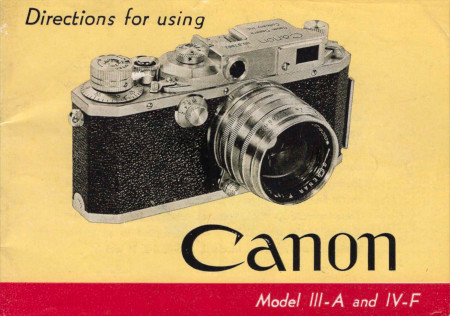
The Canon IV-F brought the same improvements to the IV model as the Canon III-A brought to the III model including new knurling on knobs, new magnification lever and film speed reminder:
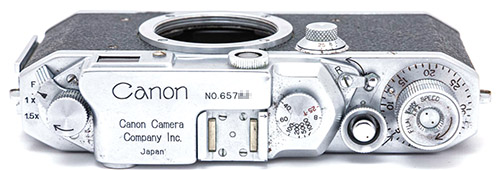
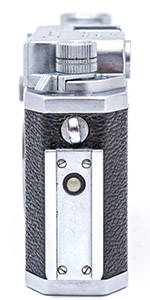
(Web images)
However, the biggest and most important news was that the Canon IV-F (perhaps shared with the III-A) was released with Canon's “universal” lens mount - Canon was finally fully Leica Thread Mount compatible. This came with a new matching lens, the highly regarded rigid f/1.8 50 mm Serenar:
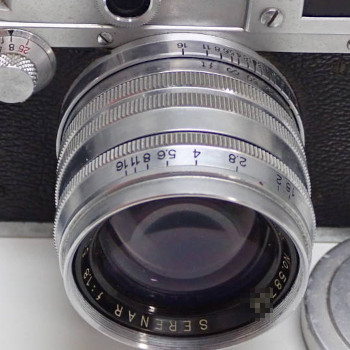 (Detail from larger web image)
(Detail from larger web image)
All subsequent bodies (and later III-A examples at least, all according to Peter Dechert) featured the universal mount but given stocks of lenses in other aperture and focal length sizes, some may have not changed until renamed “Canon” or were discontinued first.
However, unlike with the Canon III-A, the introduction of the die-cast shutter crate resulted in a new model designation, Canon IV-S.
Note: Some US sold items may have been converted to include X synch, see Canon IV above.
Canon II-A
Production (Peter Dechert) |
Marketed (Canon) |
Slow Speeds |
Main Dial
|
Sync |
S/Timer |
1952/03-1952/09 |
1952/03 |
None |
B, 1/25-1/500 |
No |
No |
Serial Numbers |
||
Source |
From |
To |
| Peter Dechert | 64255 |
73500 |
| Found | 7031x |
|
| Lens Mount: Universal | |||
| Normal 50mm Lens (Peter Dechert): Serenar f/3.5 |
|||
| Found with Lens: | |||
| Lens | Description | Serial Numbers |
|
|---|---|---|---|
From |
To |
||
| f/3.5 Serenar | Collapsible | 1507x |
|
According to Peter Dechert, produced a month earlier than the IV-S, the II-A is a III-A without slow speeds, the dial hole covered by a leatherette covered blank. Like the IV-F, it still features the earlier fabricated shutter crate. It was apparently ordered by distributor, Jardine Matheson Co., which only accepted partial delivery. Perhaps 99 made:
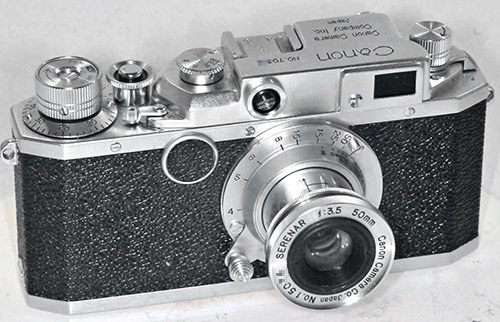 (Web image)
(Web image)
Canon IV-S
Production (Peter Dechert) |
Marketed (Canon) |
Slow Speeds |
Main Dial
|
Sync* |
S/Timer |
1952/04-1953/05 |
T, 1-1/8 |
B, 1/25-1/1000 |
M/FP |
No |
(*Sync: Slow speed sync at 1/8 and below is for M class and other peak type bulbs as well as FP, high speed sync is for FP bulbs at 1/25 and above)
Serial Numbers |
||
Source |
From |
To |
| Peter Dechert | 64000 |
85000 |
| Found | 6921x |
7609x |
| Lens Mount: Universal | |||
| Normal 50mm Lens (Peter Dechert): Serenar f/1.8 |
|||
| Found with Lens: | |||
| Lens | Description | Serial Numbers |
|
|---|---|---|---|
From |
To |
||
| f/1.8 Serenar | Rigid | 6438x |
6834x |
The only change from the Canon IV-F was the introduction of the die-cast shutter crate. Peter Dechert explains Canon's reason for the name change as being driven by the realisation that “4-F” meant “unfit for service” in US military parlance, a problem with Canon aggressively marketing to US military personnel. Cover of later Canon III-A and now IV-S user manual, note the typographical mistake, “VI-S”:
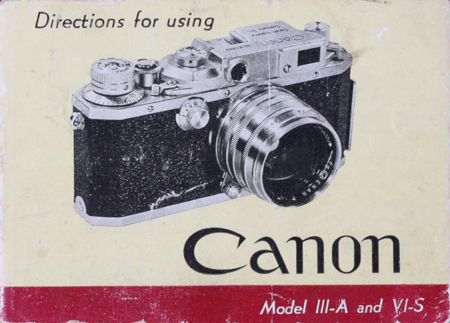
Note: Some US sold items may have been converted to include X synch, see Canon IV above.
Canon II-D
Production (Peter Dechert) |
Marketed (Canon) |
Slow Speeds |
Main Dial
|
Sync |
S/Timer |
1952/08-1955/02 |
1952/10 |
T, 1-1/8 |
B, 1/25-1/500 |
No |
No |
Serial Numbers |
||
Source |
From |
To |
| Peter Dechert | 64020 |
160150 |
| Found | 7624x |
15954x |
| Lens Mount: Universal | |||
| Normal 50mm Lens (Peter Dechert): Serenar/Canon f/1.8, f/2.8 or f/3.5 |
|||
| Found with Lens: | |||
| Lens | Description | Serial Numbers |
|
|---|---|---|---|
From |
To |
||
| f/1.8 Serenar | Rigid | 7323x |
|
| f/1.8 Canon | Chrome | 7780x |
13038x |
| f/3.5 Serenar | Collapsible | 1036x |
1233x |
| f/3.5 Canon | Collapsible | 2081x |
2357x |
Budget version of the unsynced Canon III-A with top shutter speed reduced from 1/1000 to 1/500 and no film reminder. Lens name changed from “Serenar” to “Canon” during production (with introduction of IV-Sb):
 (Web image)
(Web image)
From between serial number 11399x and 11498x onward, the model name was marked on the film loading diagram on the bottom of the shutter crate (see Canon II-F).
The II-D didn't get its own user manual, it shares the IV-S2 manual (see IV-Sb below), but it barely rates a mention in that apart from a note that it doesn't have flash sync. See also the II-F model.
Canon II-D1
Production (Peter Dechert) |
Marketed (Canon) |
Slow Speeds |
Main Dial
|
Sync |
S/Timer |
1952/10-1954/06 |
1952/10 |
T, 1-1/8 |
B, 1/25-1/500 |
No |
No |
Serial Numbers |
||
Source |
From |
To |
| Peter Dechert | 72400 |
12500 |
| Found | 94021 |
9873x |
| Lens Mount: Universal | |||
| Normal 50mm Lens (Peter Dechert): Serenar/Canon f/1.8 or f/3.5 |
|||
| Found with Lens: | |||
| Lens | Description | Serial Numbers |
|
|---|---|---|---|
From |
To |
||
| f/1.8 Serenar | Rigid | 79533 |
|
| f/1.8 Canon | Chrome | 8230x |
8455x |
Simply a Canon II-D model with film reminder added to film winding knob. Only 2,400 produced compared to 21,725 II-Ds. Earlyish example (94021) with Serenar 50 mm f/1.8 lens (79533):

(Image courtesy of Mohsen Saade)
Canon IV-Sb/IV-S2
Production (Peter Dechert) |
Marketed (Canon) |
Slow Speeds |
Main Dial
|
Sync* |
S/Timer |
1952/12-1955/03 |
1952/12 |
T, 1-1/8 |
B, 1/25-1/1000 |
M/FP/X |
No |
(*Sync: Slow speed sync at 1/8 and below is for M class and other peak type bulbs as well as FP, high speed sync is for FP bulbs at 1/25 and above, X sync is approximately 1/25)
Serial Numbers |
||
Source |
From |
To |
| Peter Dechert | 65760 |
160000 |
| Found | 6757x |
16516x |
| Lens Mount: Universal | |||
| Normal 50mm Lens (Peter Dechert): Serenar/Canon f/1.5 or f/3.5 or Canon f/1.8 or f/2.8 |
|||
| Found with Lens: | |||
| Lens | Description | Serial Numbers |
|
|---|---|---|---|
From |
To |
||
| f/1.5 Canon | Chrome | 1428x |
1829x |
| f/1.8 Serenar | Rigid | 7086x |
7713x |
| f/1.8 Canon | Chrome | 8439x |
12589x |
| f/2.8 Canon | Zebra | 1019x |
|
| f/3.5 Canon | Collapsible | 2345x |
|
Canon IV-Sb was the official factory and domestic market name but for export markets, it was usually called IV-S2, e.g. all the English language manuals I have seen refer to the IV-S2. It is a Canon IV-S with two additions, a slow speed shutter dial lock and X sync for using electronic flash. X sync was engaged by setting the slow speed dial to the new “X” position with the sync speed being around 1/15 according to Peter Dechert, but 1/25 according to the notes to the tables in the Canon Flash Unit Y user manual printed in October 1955. Canon IV-Sb with f/1.8 50mm Canon lens, note the film take-up spool with spring loaded pop-up grip introduced shortly after release of the Canon III:
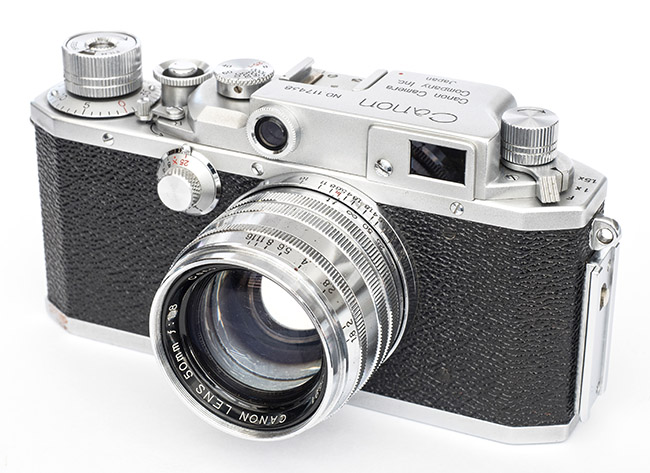
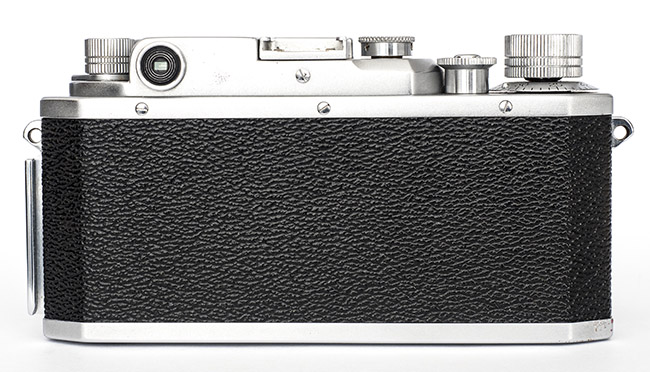
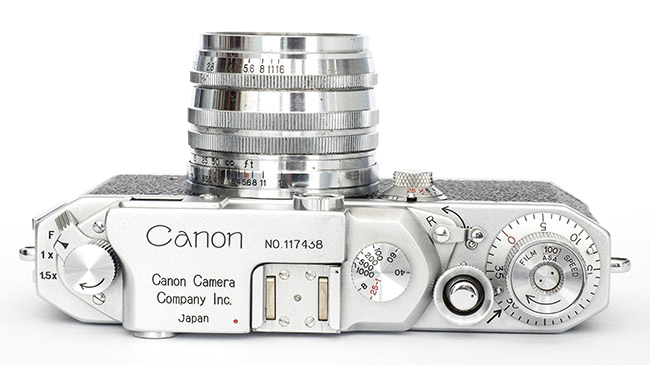
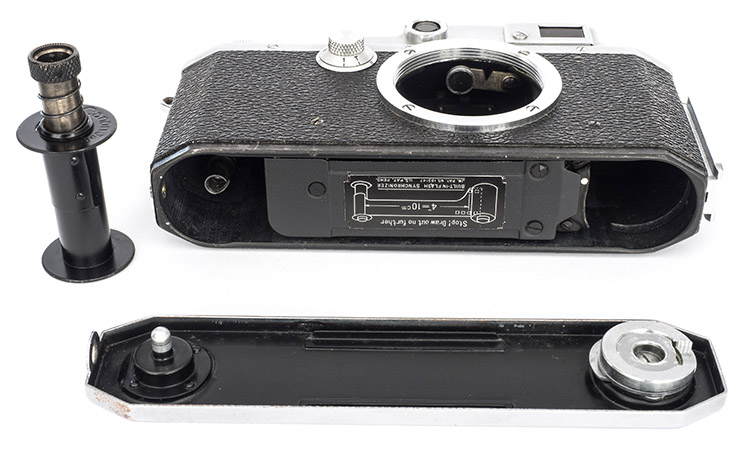
The IV-Sb was a very important model for Canon with 34,975 produced and the first model to make a real impact outside of Japan. Only the Canon P and 7 models sold more.
According to Peter Dechert, Canon announced that it was replacing the Serenar name with “Canon Lens” and lenses with that marking were delivered from the beginning. However, the seven earliest IV-Sb examples in my database with the f/1.8 lens still have lenses marked Serenar. Five of the lenses have serial numbers in the 7086x to 7713x range which seems to lead into the Canon range, the other two are slightly lower and could be later replacements. The newly arrived f/1.5 50 mm lens was initially available as a Serenar but soon changed to the Canon name. The alloy barrelled black and silver “zebra” patterned Canon f/2.8 50 mm lens arrived a little later and was destined to replace the f/3.5.
The top half of the Japanese ad below is for the new “IV-Sb”. The lens is named as the Serenar 50 mm f/1.8. The ad is titled “Two Announcements”, the other announcement being a flash unit update (see Flash Unit X). Canon's name and address is at the bottom (Shimomaruko, Ohta Ward, Tokyo):
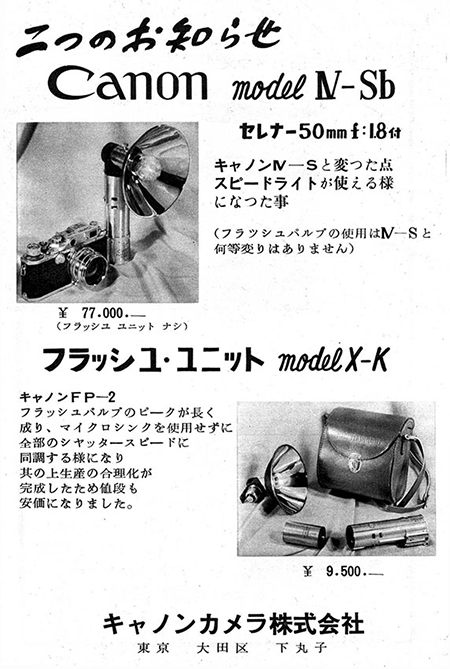
By the way, one Canon claim to fame doesn't quite stack up. On the Canon Camera Museum page for the Canon IV-Sb, “marketed Dec 1952”, Canon claims; “The world’s first camera of its kind to feature X-sync for Speedlites.” Technically, perhaps it was the first with an “X” marked on the shutter dial but on the relevant History Hall page it makes a broader claim with; “The IV-Sb was the world’s first 35mm rangefinder camera with electronic flash synchronisation.” That's simply not correct. The Nicca Type-III S with a likely September 1952 release had both FP and X sync sockets but the two years earlier 1950 Leica IIIf featured a flash delay setting dial (like Canon's “Micro Sync” on its flash units) with the ability to use electronic flash as well as most types of bulbs. For electronic flash, 1/30 sec with delay set to 2 on the earlier black dial model, 1/25 with delay set to 0, or 1/50 set to 20 on the 1952 red dial model. A more correct statement would be; “The world’s first camera of its kind to feature simplified X-sync switching for Speedlites.”
July 1953 English Language user manual for II-D and IV-S2:
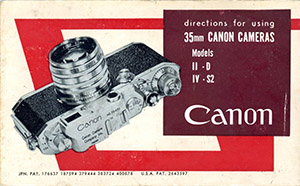 (Click on cover for PDF manual)
(Click on cover for PDF manual)
June 1954 Japanese user manual for IV-Sb and II-D (the Japanese manual has different content and additional information, e.g. sportsfinder and loading the Canon film magazine):
 (Click on cover for Japanese PDF download page)
(Click on cover for Japanese PDF download page)
Cover of September 1954 manual for IV-S2 and II-S (not “2” version cameras). II-D and superseded III-A also mentioned regarding flash use. Downloadable from Pacific Rim Camera, Flynn Marr and Mike Butkus.
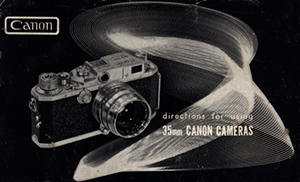
Canon II-AF
Production (Peter Dechert) |
Marketed (Canon) |
Slow Speeds |
Main Dial
|
Sync* |
S/Timer |
1953/06-1953/08 |
1953/06 |
None |
B, 1/25-1/500 |
FP |
No |
(*Sync: There is no slow speed sync for M class and other peak type bulbs, only high speed sync for FP bulbs at 1/25 and above)
Serial Numbers |
||
Source |
From |
To |
| Peter Dechert | 92165 |
95500 |
| Found | None |
|
| Lens Mount: Universal |
| Normal 50mm Lens (Peter Dechert): Canon f/3.5 (“presumed”), Canon claims it was the Canon f/1.8 |
Peter Dechert describes the Canon II-AF as a Canon II-A, the model without slow speeds, but with flash rail and flash sync for flash bulbs added. The only other material difference is that the II-A still featured the fabricated shutter crate whereas the II-AF was updated with the new die cast version. Or alternatively, you could describe the II-AF as a Canon II-F without slow speeds:

(From cover of March 1984 edition of Camera Collectors' News)
The Canon Camera Museum identifies both the AF and AX as “for export only” as there was no Japanese price. The reason for making these two variations, and in such small quantities is unknown, but it is surmised that it may have been another cancelled order, somewhat like the Jardine order for the Canon II-A.
Peter Dechert presumes that the normal lens was the Canon f/3.5. The Canon Camera Museum claims that the normal lens for both the AF and AX was the the Canon f/1.8 but the magazine photo above features the f/3.5 version. Peter Dechert also says “exactly 15” were produced.
Canon II-AX
Production (Peter Dechert) |
Marketed (Canon) |
Slow Speeds |
Main Dial
|
Sync* |
S/Timer |
Doesn't exist |
1953/06 |
None |
B, 1/25-1/500 |
X |
No |
(*Sync: Canon claims that X sync is at approximately 1/40)
Serial Numbers |
||
Source |
From |
To |
| Peter Dechert | n/a |
n/a |
| Found | None |
|
| Lens Mount: Universal |
| Normal 50mm Lens: Canon claims it was the Canon f/1.8 |
According to Peter Dechert, the Canon II-AX is “mythological”, he claims that it didn't exist. His reasoning, based on his assertion that Canon “did not manage X synchronisation on the fast shutter speed dial” for another two years, sounds plausible and he adds, “it is my understanding that Canon's own historians now agree with this conclusion.” However, notwithstanding his belief, almost 40 years after his book was published, the Canon Camera Museum still lists the model and has this to say about it:
“Often called the mysterious Canon, the II-AX was named “Flash-dedicated Camera” during its development. It was a II-A with 1/40 sec. X-sync and a side flash rail with built-in flash sync contacts. Shutter speeds slower than 1/8 sec. were not provided. The slow shutter speed dial hole was covered by a round patch like the II-A. Altogether only about 20 II-AX and II-AF cameras were made.”
History doesn't always follow a logical path and in any case, logic requires that you have access to all salient facts, rarely the case in the historical context. It may well be that an X synch at the then unusually high speed of 1/40 on the main dial was not especially difficult to implement, noting that it is the only Canon with X sync but without slow speeds and separate flashbulb sync. A somewhat similar example of this was the 1958 Nicca Type 33, a budget version of the popular 3-F models. Since 1952 (1955 for single socket models), Niccas featured X sync at the changeover speed (not marked with an “X”, first at 1/25 and then 1/30). The budget Type 33 saved money by dropping flashbulb sync but offered X sync at 1/60. The flagship Nicca III-L followed with flashbulb sync restored and X sync reduced back to the crossover speed. My mind remains open on this one.
If Peter Dechert's claim is correct that precisely 15 Canon II-AF cameras were made and Canon is correct about the total for the two models being around 20, then 5 Canon II-AX cameras may have been made.
Canon II-F
Production (Peter Dechert) |
Marketed (Canon) |
Slow Speeds |
Main Dial
|
Sync* |
S/Timer |
1953/07-1955/03 |
1953/06 |
T, 1-1/8 |
B, 1/25-1/500 |
FP |
No |
(*Sync: There is no slow speed sync for M class and other peak type bulbs, only high speed sync for FP bulbs at 1/25 and above)
Serial Numbers |
||
Source |
From |
To |
| Peter Dechert | 84380 |
166050 |
| Found | 9817x |
15920x |
| Lens Mount: Universal | |||
| Normal 50mm Lens (Peter Dechert): Canon f/1.8, f/2.8 or f/3.5 |
|||
| Found with Lens: | |||
| Lens | Description | Serial Numbers |
|
|---|---|---|---|
From |
To |
||
| f/1.8 Canon | Chrome | 8738x |
14296x |
The Canon II-F is another budget model but with 11,900 made, was well received even though it was largely anonymous - it didn't seem to appear in any Canon advertising or documentation, perhaps because the great majority were sold through US military exchange stores. It is missing the IV-Sb's 1/1000 top speed, slow speed shutter dial lock and X and slow speed sync sync whilst still offering sync for FP flash bulbs at 1/25 and above which would have fulfilled most amateur photographer's needs in the 1950s.
Whilst I am not aware of a user manual, or “Directions”, which specifically mentions the II-F, an earlier II-F has been found with a July 1953 Canon II-D/IV-S2 (IV-Sb) user manual and another such manual sold by itself had the yellow II-F slip below loosely inserted inside so presumably, this manual with the slip is what was supplied with the camera. A later II-F, originally bought in a PX store by a correspondent's father, was supplied with the different September 1954 printed manual for the IV-S2/S-II. Now well used, unfortunately this doesn't include any slip but it may have been there originally (see IV-Sb/IV-S2 above for more manual information). The found slip explains the relevant spec differences and flash limitations between the three models:

Although it doesn't have slow speed sync either, without the dial lock and X sync, it is more like an IV-S with 1/500 top speed in the same way as the II-S is an IV-Sb with 1/500 instead. Whilst there is no <EP> mark on the first 1953 cameras from 9817x to 10777x (the mark was only introduced in 1953), from that point on, most have the mark with only the odd exception. Nearly all the examples in my database found with lenses came with the f/1.8 50 mm Canon. Example below with the Canon lens but later camera with no <EP> mark:
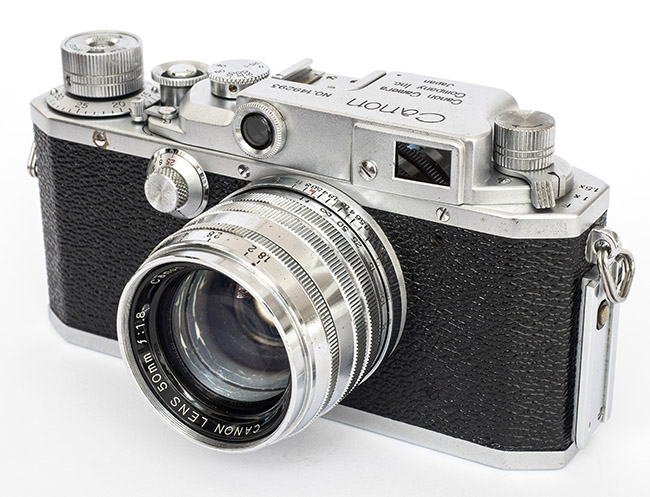
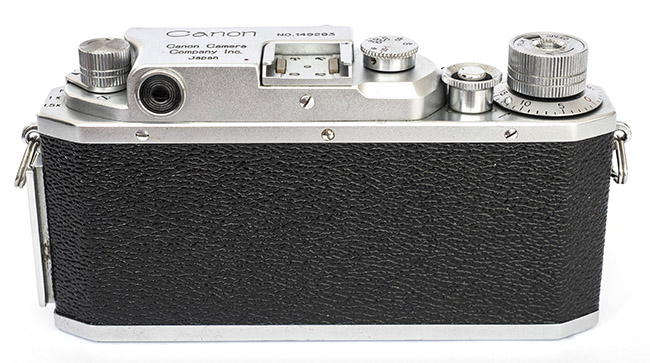
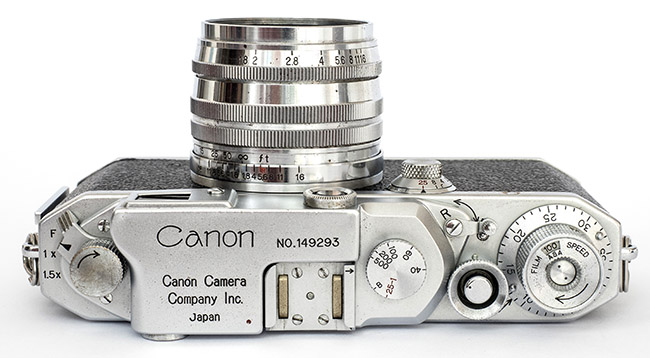
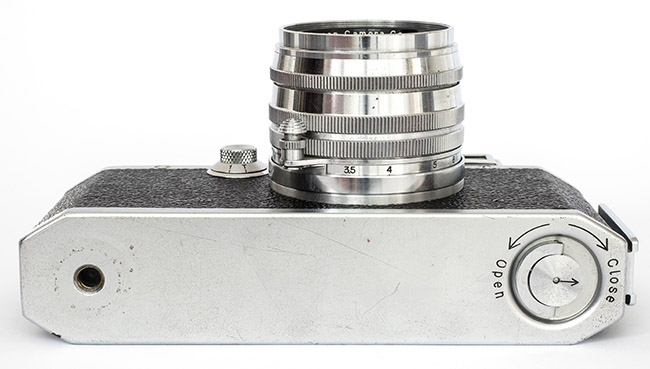
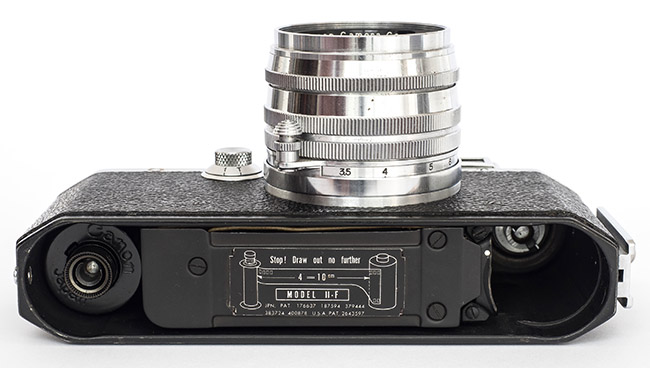
Up to serial number 12704x, there was no model name, but from 13991x onward, the model name was marked on the film loading diagram on the bottom of the shutter crate. Between those numbers is a cross over period where both types are found.
Canon II-S
Production (Peter Dechert) |
Marketed (Canon) |
Slow Speeds |
Main Dial
|
Sync* |
S/Timer |
1954/02-1955/03 |
1954/02 |
T, 1-1/8 |
B, 1/25-1/500 |
M/FP/X |
No |
(*Sync: Slow speed sync at 1/8 and below is for M class and other peak type bulbs as well as FP, high speed sync is for FP bulbs at 1/25 and above, X sync is approximately 1/25)
Serial Numbers |
||
Source |
From |
To |
| Peter Dechert | 108870 |
160150 |
| Found | 10826x |
12678x |
| Lens Mount: Universal | |||
| Normal 50mm Lens (Peter Dechert): Canon f/1.5, f/1.8, f/2.8 or f/3.5 |
|||
| Found with Lens: | |||
| Lens | Description | Serial Numbers |
|
|---|---|---|---|
From |
To |
||
| f/1.8 Canon | Chrome | 10020x |
11243x |
| f/3.5 Canon | Collapsible | 1933x |
|
Whilst the Canon II-F features sync for high speed flash bulbs only, the Canon II-S also includes X and low speed sync - it is basically a Canon IV-Sb without the highest shutter speed of 1/1000. Only 1,850 were made. Unless it is one of the later examples with the name inside, the only way to tell the II-F and II-S apart is the slow speed dial, the II-S has the IV-Sb dial lock and the “X” sync marking both missing on the II-F:
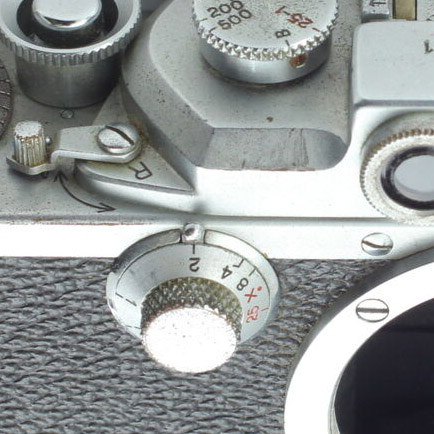 (Detail from larger web image)
(Detail from larger web image)
From between serial number 10826x and 11327x onward, the model name was marked on the film loading diagram on the bottom of the shutter crate.
Released after the July 1953 IV-S2 user manual was printed, it is briefly mentioned in the September 1954 manual.
Canon IV-Sb2
Production (Peter Dechert) |
Marketed (Canon) |
Slow Speeds |
Main Dial
|
Sync* |
S/Timer |
1954/07-1956/07 |
1954/03 |
T, 1-1/15 |
B, 1/30-1/1000 |
M/FP/X |
No |
(*Sync: Slow speed sync at 1/15 and below is for M class and other peak type bulbs as well as FP, high speed sync is for FP bulbs at 1/30 and above, X sync is approximately 1/45 on main dial or approximately 1/30 on slow dial for older electronic flash units)
Serial Numbers |
||
Source |
From |
To |
| Peter Dechert | 122490 |
229000 |
| Found | 17123x |
22893x |
(See comments below regarding serial numbers from 122490 to 169999)
| Lens Mount: Universal | |||
| Normal 50mm Lens (Peter Dechert): Canon f/1.5, f/1.8 or f/2.8 |
|||
| Found with Lens: | |||
| Lens | Description | Serial Numbers |
|
|---|---|---|---|
From |
To |
||
| f/1.5 Canon | Chrome | 1877x |
2310x |
| f/1.8 Canon | Chrome | 10626x |
16668x |
| f/2.8 Canon | Zebra | 1552x |
|
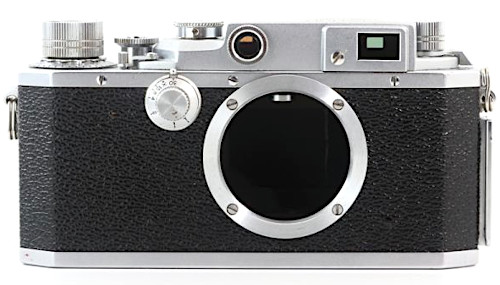 (Web image)
(Web image)
Whilst the IV-Sb2 is externally similar to the IV Sb there were a number of improvements, all but two visible in the photo below. The changeover speed from slow to high speeds has increased from 1/25 to 1/30 and for the first time, a Canon shutter uses a geometric speed sequence (speeds increase by a factor of 2). X sync has moved to the main dial with a speed of about 1/45 whilst the position on the slow dial remained to cater for older long delay strobes. The slow dial also adds a 1/15 speed for the first time. The revised shutter dial markings and new speed progression are now:
Front Dial: T, 1, 2, 4, 8, 15, X, 30
Main Dial: B, 30-1, X, 60, 125, 250, 500, 1000
The main shutter dial is now in two parts and the speed can be set cocked or uncocked and although the dial still spins, the two parts and set speed stay locked together. There is also the serrated wheel between the film wind knob and frame counter disc which can be set against the frame counter to indicate the number of exposures available on the roll (e.g. 24 or 36, in 1955 20 was suggested as an option). Not visible in the photo is the improved viewfinder eyepiece or the re-engineered shutter which enabled the updates noted above:
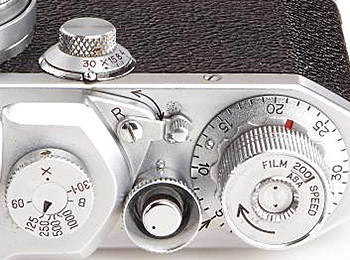 (Detail from larger web image)
(Detail from larger web image)
A minor update on the “2” models is a new film leader instruction label on the bottom of the shutter crate. Whilst it looks more “modern”, it sacrifices the “Stop! Draw out no further” warning for more patent numbers:
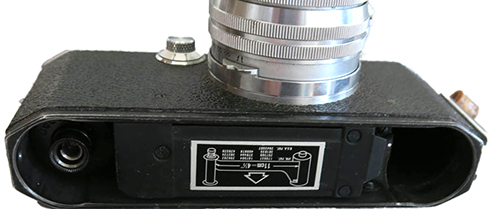
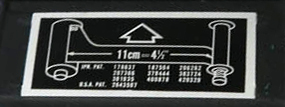 (Web images)
(Web images)
Peter Dechert says that production started with serial number 122490 in July 1954 but numbers under 170000 are quite low (I haven't found any) whereas the companion models, the II-S2, II-D2 and II-F2, didn't arrive until serial number 170000 starting in February 1955. Canon actually claims that the IV-Sb2 was “marketed” in March 1954 yet strangely, an October 1955 user manual for the Canon Flash Unit Y offers two sets of tables; one for IV-Sb, II-S and II-F cameras up to serial number 169999 with shutter cross over speed of 1/25, the other for the same models (see below) over 170000 with cross over speed of 1/30. That ignores any earlier IV-Sb2 production. It is an anomaly I have no answer for, a guess is that there may have been a trial series, a reason perhaps for the low numbers, its purpose misremembered in the passing of time.
The IV-Sb2 was an important model for Canon, setting the high bar for bottom loading LTM rangefinders. Peter Dechert called it “the finest bottom-loading 35 mm rangefinder camera anyone has ever built” but I'm certain that he wasn't including the bottom loading Leica M3 in that comparison. About 16,800 were made, less than half the IV-Sb number which continued concurrently for some time. The new shutter lived on in Canon's V series models.
Canon has now embraced the naming of the IV-Sb2 and its lesser siblings but the evidence is that back in the mid-1950s, Canon barely acknowledged any difference to the earlier IV-Sb, e.g. an April 1955 Canon camera brochure displays pictures of the IV-Sb2, II-S2 and II-D2 (not the II-F2 though) showing the updated features, casually includes the new shutter progression including 1/15 and 1/30 speeds but avoids any other discussion and uses the old names without the “2” suffix. Peter Dechert tells us that the confusion started with Canon simply referring to the new models as “improved” and that the Japanese character for that looked like a western “2” and then the 2 stuck. Sellers in Japan these days still refer to the IV-Sb2 as “IV-Sb (modified)”, or similar (as machine translated), and the same for its companion models.
The IV-Sb2 and the other two models are among the few Canon post-War cameras that I have not found downloadable user manuals for, however, these are the covers of 2 different versions. I presume the first, because of the similarity of the cover to the September 1954 version of the IV-Sb/IV-S2 manual, this is the February 1955 printing:
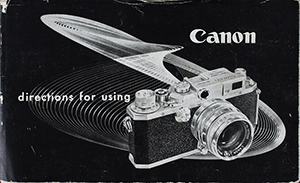
Presumably, the second version:
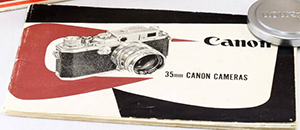
Note, the “Canon” name on both covers is in the form of the new corporate logo with backward sloping “o” which Canon claims was adopted in 1956. Not official yet? A mistake with its own history?
Canon II-S2
Production (Peter Dechert) |
Marketed (Canon) |
Slow Speeds |
Main Dial
|
Sync* |
S/Timer |
1955/02-1956/07 |
1955/04 |
T, 1-1/15 |
B, 1/30-1/500 |
M/FP/X |
No |
(*Sync: Slow speed sync at 1/15 and below is for M class and other peak type bulbs as well as FP, high speed sync is for FP bulbs at 1/30 and above, X sync is approximately 1/45 on main dial or approximately 1/30 on slow dial for older electronic flash units)
Serial Numbers |
||
Source |
From |
To |
| Peter Dechert | 170000 |
227000 |
| Found | 17171x |
227593 |
| Lens Mount: Universal | |||
| Normal 50mm Lens (Peter Dechert): Canon f/1.5, f/1.8 or f/2.8 |
|||
| Found with Lens: | |||
| Lens | Description | Serial Numbers |
|
|---|---|---|---|
From |
To |
||
| f/1.5 Canon | Chrome | 2089x |
2172x |
| f/1.8 Canon | Chrome | 13229x |
16731x |
| f/2.8 Canon | Zebra | 1467x |
|
The Canon II-S2 is the IV-Sb2 minus the 1/1000 shutter speed. It is still a very capable camera and proved quite popular with 16,575 made, a lot more than the II-S it replaced:
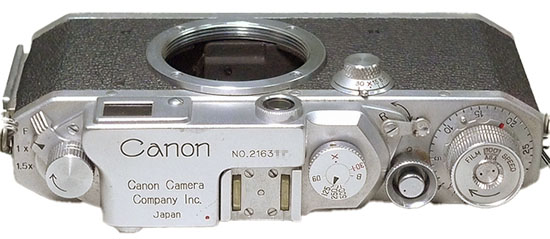 (Web image)
(Web image)
Canon II-D2
Production (Peter Dechert) |
Marketed (Canon) |
Slow Speeds |
Main Dial
|
Sync |
S/Timer |
1955/03-1956/07 |
1955/04 |
T, 1-1/15 |
B, 1/30-1/500 |
No |
No |
Serial Numbers |
||
Source |
From |
To |
| Peter Dechert | 170160 |
228200 |
| Found | 17851x |
22770x |
| Lens Mount: Universal | |||
| Normal 50mm Lens (Peter Dechert): Canon f/1.8 or f/2.8 |
|||
| Found with Lens: | |||
| Lens | Description | Serial Numbers |
|
|---|---|---|---|
From |
To |
||
| f/1.8 Canon | Chrome | 13727x |
16630x |
| f/2.8 Canon | Zebra | 1105x |
1590x |
The Canon II-D2 brings the same improvements to the II-D1 (the II-D version with film speed reminder) as the the IV-Sb2 brought to the IV-Sb plus it adds the slow dial lock missing from the original. Or, a simpler way to consider it is as a Canon II-S2 minus flash sync and side rail. It was also made in similar numbers to the II-S2:
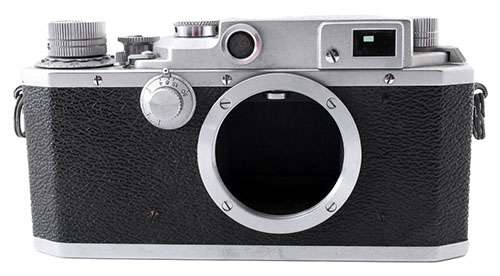 (Web image)
(Web image)
Canon II-F2
Production (Peter Dechert) |
Marketed (Canon) |
Slow Speeds |
Main Dial
|
Sync* |
S/Timer |
1955/06-1955/11 |
1955/04 |
T, 1-1/15 |
B, 1/30-1/500 |
FP |
No |
(*Sync: There is no slow speed sync for M class and other peak type bulbs, only high speed sync for FP bulbs at 1/30 and above)
Serial Numbers |
||
Source |
From |
To |
| Peter Dechert | 173200 |
217100 |
| Found | 18175x |
20035x |
| Lens Mount: Universal | |||
| Normal 50mm Lens (Peter Dechert): Canon f/1.8 or f/2.8 |
|||
| Found with Lens: | |||
| Lens | Description | Serial Numbers |
|
|---|---|---|---|
From |
To |
||
| f/1.5 Canon | Chrome | 2267x |
|
| f/1.8 Canon | Chrome | 12434x |
14868x |
The Canon II-F2 is identical to the II-S2 except that there is no slow speed sync or X sync, as indicated by the shutter dials without the “X” position marked. Production of 2,625 was much lower than the original II-F but it arrived late and was only made for 5 months. Canon II-D2/II F2-dials:
 (Detail from larger web image)
(Detail from larger web image)
Canon VT
Production (Peter Dechert) |
Marketed (Canon) |
Slow Speeds |
Main Dial
|
Sync* |
S/Timer |
1956/04-1957/02 |
1956/08 |
T, 1-1/15 |
B, 1/30-1/1000 |
M/FP/X |
Yes |
(*Sync: 2 position switch, FP/M is for FP bulbs from 1 to 1/1000 and M bulbs from 1 to 1/250, X/F is for electronic flash at approximately 1/50 and F bulbs from 1 to 1/30)
Serial Numbers |
||
Source |
From |
To |
| Peter Dechert | 500010 |
540000 |
| Found | 50011x |
51814x |
| Lens Mount: Universal | |||
| Normal 50mm Lens (Peter Dechert): Canon f/1.2, f/1.5, f/1.8 or f/2.8 |
|||
| Alternative 35 mm Lens (Peter Dechert): Canon f/1.8 or f/2.8 | |||
| Found with Lens: | |||
| Lens | Focal Length/ Description | Serial Numbers |
|
|---|---|---|---|
From |
To |
||
| f/1.8 Canon | 50mm Black | 20745x |
22129x |
Whilst there is an argument that the Canon IV-Sb2 was superior to the Leica IIIf, the Canon VT was Canon's first effort to try to narrow the gap to the Leica M3 by offering something different. It used the same IV-Sb2 shutter and much of the internals were the same but there were some major changes to how it operated. Instead of adopting lever film wind, Canon had in fact permanently mounted its trigger operated Rapid Winder on the bottom and made the courageous call that this was the future. Whilst no doubt in some circumstances for some people it offered advantages, in others such as portrait mode and using on tripods, or copy stands, it was an obstacle and for that reason, and also for winding on the first two frames when loading film, a vestigal film wind knob was also provided (note, the requirement to knob wind the first two frames and be gentle with the lever wind for the last three frames only appeared as red stamped additions on pages 11 and 20 of the later version user manual marked “VT”).
More usefully, it features a hinged opening back for film loading/unloading with fixed take-up spool.
Canon had taken note of the trend to using 35 mm focal length lenses as normal lenses and modified the viewfinder/rangefinder to give a 35 mm lens view at the widest setting with 0.4x magnification, a 50 mm lens view at the middle setting with 0.72x magnification and a setting with 1.4x magnification for accurate focus purposes only. The magnification lever was replaced by a thumbwheel on the back and a circular indicator window in the top plate with clockwise markings “50”, “35” and “RF”. In addition, Canon now offered camera sets with 35 mm normal lenses in addition to the usual 50 mm lenses.
Whilst the camera's viewfinder doesn't offer parallax correction, a very useful feature is built-in parallax correction for the matching Series V accessory viewfinders. A pin at the front of the accessory shoe raises or lowers the front of the viewfinder as the camera is focused.
The “X” position was removed from the slow speed shutter dial and a tab operated switch added under the high speed dial for selecting X or bulb sync, although it is not quite as simple as that, see above table and description under. The 1/250 maximum speed for M sync was perhaps overly ambitious, it dropped initially to 1/125 on the L1 and following Series V models, then back to 1/250 on Series VI cameras before dropping to 1/15 on the 7 models, the 7s user manual mentioning that up to 1/250 was possible “where only the central part of the picture is necessary.” The earlier flash rail was incompatible with the opening back and was replaced by a bayonet fitting at the end of the top plate. Inside this is a standard PC socket which allows connection of any flashgun with cable and PC plug, or cleverly, direct mounting of the new Canon Flash Unit Model V.
With the new 35 mm lens focusing capability also came a new f/1.8 35 mm lens. The earlier chromed brass f/1.8 50 mm lens was rehoused in a new lighter alloy barrel in mainly black to better match the style of the VT. At the same time, a new hero lens was launched, the f/1.2 50 mm.
Other new features included the first self-timer offered by Canon and a pop-up rewind knob released by the surrounding lever:
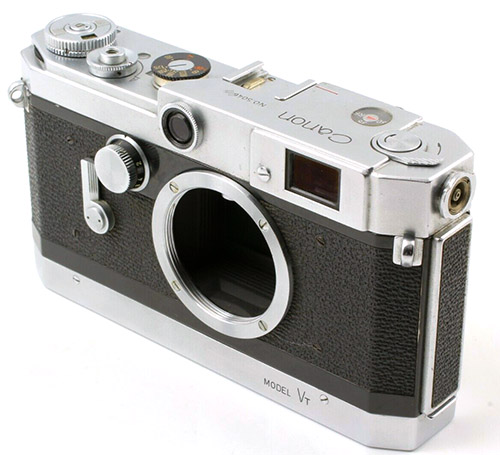
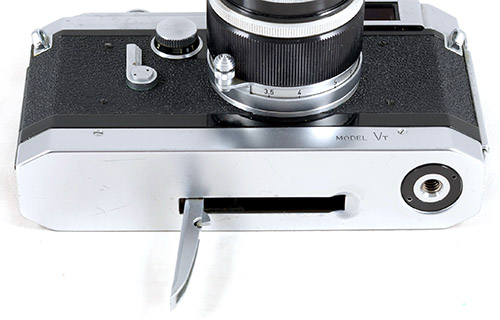
(Web images)
Note, the Canon VT has a tripod socket on the right side (when viewed from the front), i.e. the wrong side, to enable mounting of the accessory pistol grip. Consequently, there is no key to close and open the reloadable film magazine as found on the prior bottom loading models and in a different form, on the earlier accessory Rapid Winder. That means that Canon film magazines can't be used.
The Canon VT is easy to recognise, the name “MODEL VT” is engraved on the right side (looking at the camera) of the front of the base plate. This wasn't so before its actual release. Perhaps Canon hadn't even envisaged a future lever wind version, or maybe it just hadn't thought through its naming system. There are a lot more brochures and ads found for the “Canon V” camera than the “Canon VT” and there are instruction manuals for both names. Below are instruction and brochure covers. Top left is the original “Canon MODEL V” instructions, below left is a B & W reprint of the later “Canon MODEL VT” instructions (Peter Kitchingman posted his original on a forum, the colours are the same as the earlier version) and on the right is a “Canon VT” brochure (note range of standard lenses offered):

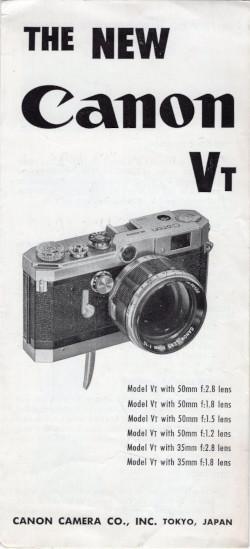
The camera that is mostly featured in the “V” documents has serial number 303002 whereas production cameras belong to the range beginning with 500010 so it is clearly a pre-production example. Where the relevant area is visible, most documents show it without a model name, including the first user manuals, but at least a couple of “V” brochures show the same camera with “MODEL” visible under the lens, presumably with modified artwork rather than camera but it is too far to the left in any case. Examples of both below, the serial number may be hard to see but it is 303002 in each case:


Canon L2
Production (Peter Dechert) |
Marketed (Canon) |
Slow Speeds |
Main Dial
|
Sync* |
S/Timer |
1956/11-1956/12 |
T, 1-1/15 |
B, 1/30-500 |
FP |
No |
|
1957/05-1957/12 |
1957/03 |
(*Sync: The L2 is synchronised for FP bulbs only from 1/60 to 1/500, i.e. there is no slow speed or M synch)
Serial Numbers |
||
Source |
From |
To |
| Peter Dechert | 505850 |
583000 |
| Found | 506096 |
58328x |
| Lens Mount: Universal | |||
| Normal 50mm Lens (Peter Dechert): Canon f/1.8 or f/2.8 |
|||
| Alternative 35 mm Lens (Peter Dechert): Canon f/1.8 or f/2.8 | |||
| Found with Lens: | |||
| Lens | Focal Length/ Description | Serial Numbers |
|
|---|---|---|---|
From |
To |
||
| f/1.8 Canon | 50mm Black | 20871x |
22428x |
| f/2.8 Canon | 50mm Zebra | 1945x |
2148x |
Peter Dechert tells us that 11 Canon L2 cameras were produced in November and December 1956 and the rest from May 1957 onward. That makes the first batch another trial series and means that the L2 didn't really come before the L1 based on his production dates but according to Canon's marketing, it did and I think that in this case, Canon is correct, see further below. Also, a Japanese user manual, dated February 1957, features camera number 506008, suggesting perhaps that volume production commenced with serial number 506001 and that Canon's March marketing date is realistic. Peter Dechert's earliest serial number, 505850, is no doubt the first of the 1956 batch of 11.
Compared to the VT, the L2 replaces the VT's trigger with lever wind but misses out on its 1/1000 top speed, self-timer, X sync and slow speed sync for both FP and peak bulbs. The sync switch is absent, the window left empty. The L2 brought back the key to open and close the film magazine but it seemed to necessitate a change from the Zeiss inspired magazine design of the bottom loaders to a more Leica-like design for V series magazines. The name is marked on the bottom of the base plate. Lens selection was limited to just the f/1.8 and f/2.8 50 mm lenses. Early camera 506096:
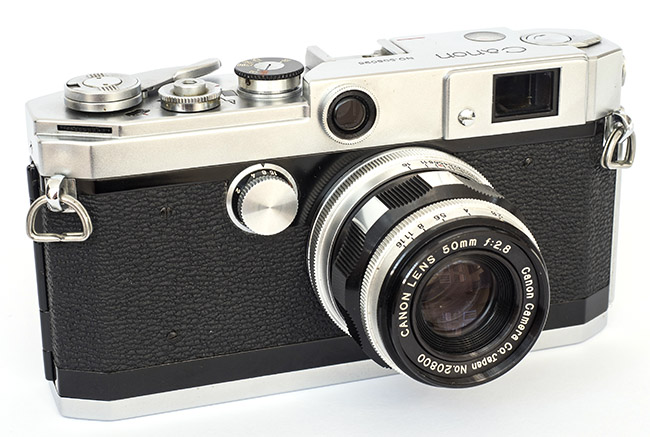
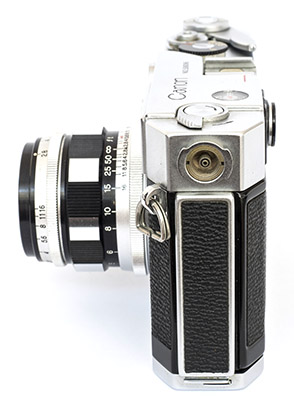
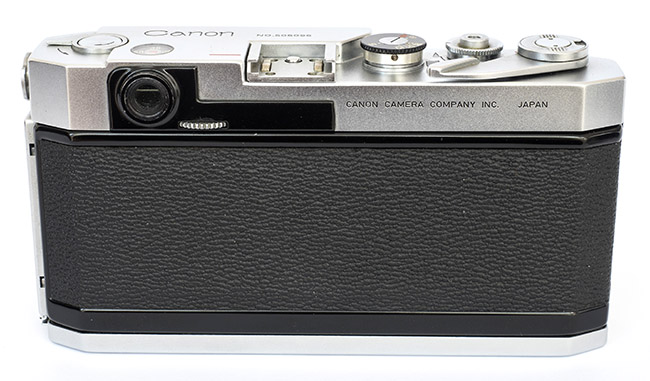
Note the parallax correcting pin in the front of the accessory shoe and also the style of the “Canon” which hadn't really changed on camera bodies from the Hansa Canon to Canon VT:
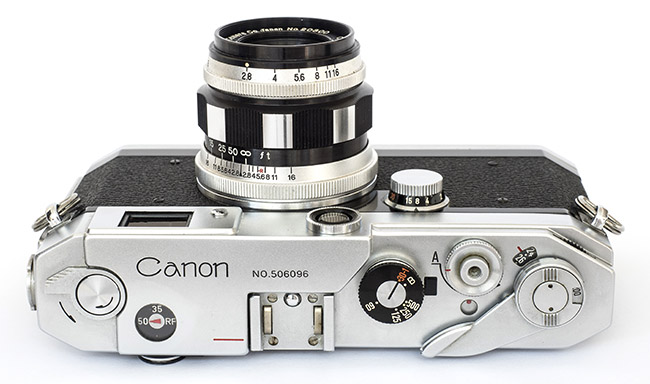
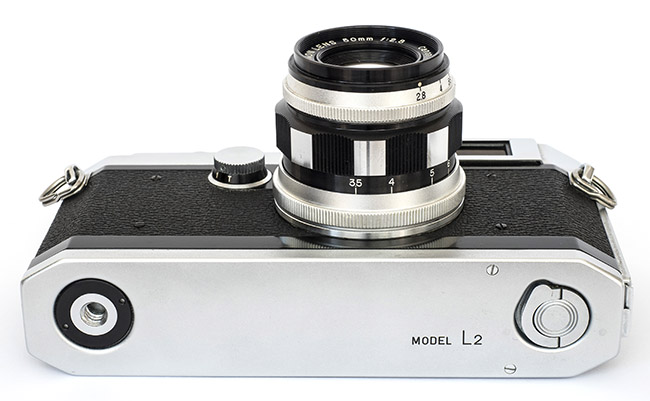
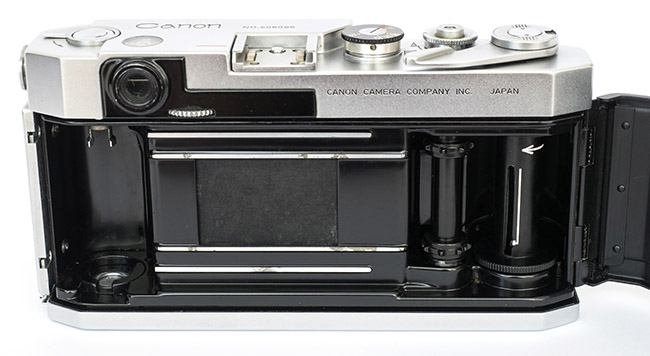
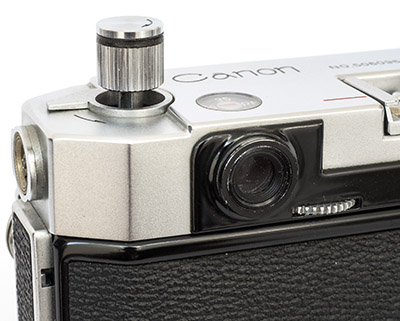
The style of the “Canon” name above changed between L2 serial number 523143 and 524163 to the new style below:
 (Web image)
(Web image)
As the L2 was the only model to be released after the VT still with the old style name (approximately the first half of my L2 database), it follows that the L2 was released before the L1.
Correspondent Todd Belcher has sent me a photo of an L2, serial number 506940, with the base plate marked “L-2” instead of “L2”:

(Image courtesy of Todd Belcher)
It's a mystery, but both of us are of the opinion that it may have been the initial design and was possibly changed even before the camera went on sale. However, this style of name may well have been found on the the first batch of 11. Whilst the found camera is a relatively early one, it is not as early as the user manual camera, 506008, or my example above, 506096, both of which are marked “L2” already, which leads us to further speculate that perhaps there was a supply of base plates with the earlier engraving and Canon later decided to use them up. Another possibility that occurs to me is that they may have been used up as spare parts, but how often does a base plate need replacement?
Japanese L2 & L3 user manual dated October 1957, note, the featured L2 is still the same 506008 as in the February 1957 L2 manual:
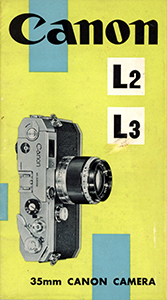 (Click on cover for PDF manual)
(Click on cover for PDF manual)
Canon L1
Production (Peter Dechert) |
Marketed (Canon) |
Slow Speeds |
Main Dial
|
Sync* |
S/Timer |
1957/02-1957/12 |
1957/05 |
T, 1-1/15 |
B, 1/30-1/1000 |
M/FP/X |
No |
(*Sync: 2 position switch, FP/M is for FP bulbs from 1 to 1/1000 and M bulbs from 1 to 1/125, X/F is for electronic flash at approximately 1/50 and F bulbs from 1 to 1/30)
Serial Numbers |
||
Source |
From |
To |
| Peter Dechert | 540000 |
566000 |
| Found | 54206x/div> |
56328x |
| Lens Mount: Universal | |||
| Normal 50mm Lens (Peter Dechert): Canon f/1.2, f/1.5, f/1.8 or f/2.8 |
|||
| Alternative 35 mm Lens (Peter Dechert): Canon f/1.8 or f/2.8 | |||
| Found with Lens: | |||
| Lens | Focal Length/ Description | Serial Numbers |
|
|---|---|---|---|
From |
To |
||
| f/1.2 Canon | 50mm Black | 4347x |
|
| f/1.8 Canon | 50mm Black | 21039x |
24160x |
The L1 is a cross between the VT and L2 but brings a new innovation as well. It is a VT with lever wind but misses out on the self-timer whilst adding the L2's magazine key. The top sync speed for M class bulbs is 1/125, half of the VT's 1/250, as it is for the other Series V models (see VT above). The innovation is a new rewind crank that folds neatly into its top plate recess:
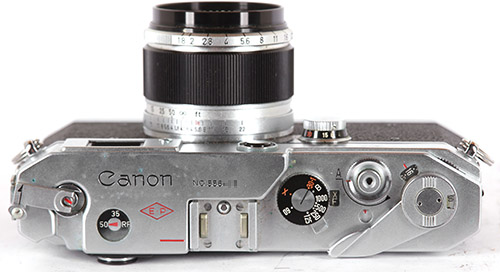 (Web image)
(Web image)
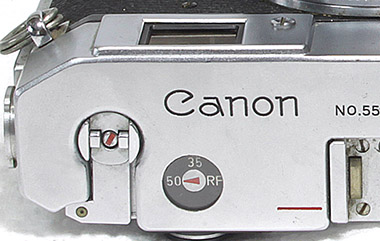

(Detail from larger web images)
According to Peter Dechert, the L1 and VT de luxe were the first Canon models available in a black painted finish.
The last camera in my database is an anomaly. It has serial number 581721 (not included in the range above) which is higher than Peter Dechert's range end, 566000, and my second highest found, 56328x. It has metal shutter curtains and the viewfinder system seems to have the cooler colour of the later VL which would make sense in terms of its serial number, however, it doesn't have a self-timer.
Canon VT de luxe
Production (Peter Dechert) |
Marketed (Canon) |
Slow Speeds |
Main Dial
|
Sync* |
S/Timer |
1957/02-1957/09 |
1957/05 |
T, 1-1/15 |
B, 1/30-1/1000 |
M/FP/X |
Yes |
(*Sync: 2 position switch, FP/M is for FP bulbs from 1 to 1/1000 and M bulbs from 1 to 1/125, X/F is for electronic flash at approximately 1/50 and F and M-2 bulbs from 1 to 1/30)
Serial Numbers |
||
Source |
From |
To |
| Peter Dechert | 540000 |
545500 |
| Found | 54074x |
54486x |
| Lens Mount: Universal | |||
| Normal 50mm Lens (Peter Dechert): Canon f/1.2, f/1.5, f/1.8 or f/2.8 |
|||
| Alternative 35 mm Lens (Peter Dechert): Canon f/1.8 or f/2.8 | |||
| Found with Lens: | |||
| Lens | Focal Length/ Description | Serial Numbers |
|
|---|---|---|---|
From |
To |
||
| f/2.8 Canon | 35mm Black | 3376x |
|
The only change from Canon VT to Canon VT de luxe is the substitution of the pop-up rewind knob with the new L1 rewind crank. There is still no magazine key. As with all three VT de luxe variations, the name “MODEL VT de luxe” is engraved on the right side (looking at the camera) of the front of the base plate.
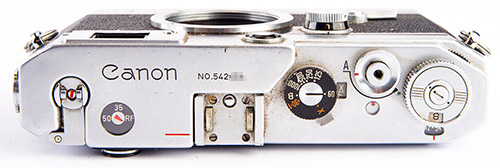

(Web images)
Peter Dechert says that the model name is generally picked out in red but so far, only the three earliest I have found, 540110, 540745 and 541267 are in red, from serial number 542454 the ones I have found are in black. Red and black examples below:
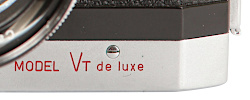

(Detail from larger web images)
Canon VT de luxe Z (Peter Dechert name)
Production (Peter Dechert) |
Marketed (Canon) |
Slow Speeds |
Main Dial
|
Sync* |
S/Timer |
1957/04-1958/06 |
T, 1-1/15 |
B, 1/30-1/1000 |
M/FP/X |
Yes |
(*Sync: 2 position switch, FP/M is for FP bulbs from 1 to 1/1000 and M bulbs from 1 to 1/125, X/F is for electronic flash at approximately 1/50 and F and M-2 bulbs from 1 to 1/30)
Serial Numbers |
||
Source |
From |
To |
| Peter Dechert | 540500 |
560000 |
| Found | 54812x |
55499x |
| Lens Mount: Universal | |||
| Normal 50mm Lens (Peter Dechert): Canon f/1.2, f/1.5, f/1.8 or f/2.8 |
|||
| Alternative 35 mm Lens (Peter Dechert): Canon f/1.8 or f/2.8 | |||
| Found with Lens: | |||
| Lens | Focal Length/ Description | Serial Numbers |
|
|---|---|---|---|
From |
To |
||
| f/1.2 Canon | 50mm Black | 2475x |
2537x |
| f/1.8 Canon | 50mm Black | 21857x |
22728x |
The Canon Camera Museum only acknowledges one version of the Canon VT de luxe but there were two updates. Whilst internal Canon production summaries differentiate between the first and this one, there was no separate name, the naming of this one “Canon VT de luxe Z” is another Peter Dechert initiative.
The update the VT de luxe Z brings is the new L1/L2 style magazine key now adapted to the trigger type base plate with combined key and tripod mount also used for the accessory pistol grip.
 (Detail from larger web image)
(Detail from larger web image)
Canon L3
Production (Peter Dechert) |
Marketed (Canon) |
Slow Speeds |
Main Dial
|
Sync |
S/Timer |
1957/10-1958/12 |
1957/11 |
T, 1-1/15 |
B, 1/30-1/500 |
No |
No |
Serial Numbers |
||
Source |
From |
To |
| Peter Dechert | 529000 |
592000 |
| Found | 52692x |
581829 |
| Lens Mount: Universal | |||
| Normal 50mm Lens (Peter Dechert): Canon f/1.8 or f/2.8 |
|||
| Alternative 35 mm Lens (Peter Dechert): Canon f/1.8 or f/2.8 | |||
| Found with Lens: | |||
| Lens | Focal Length/ Description | Serial Numbers |
|
|---|---|---|---|
From |
To |
||
| f/1.8 Canon | 50mm Black | 23782x |
24475x |
| f/2.8 Canon | 50mm Black | 2426x |
3051x |
The Canon L3 is a Canon L2 with the flash sync removed and the bayonet socket fitting blanked off:
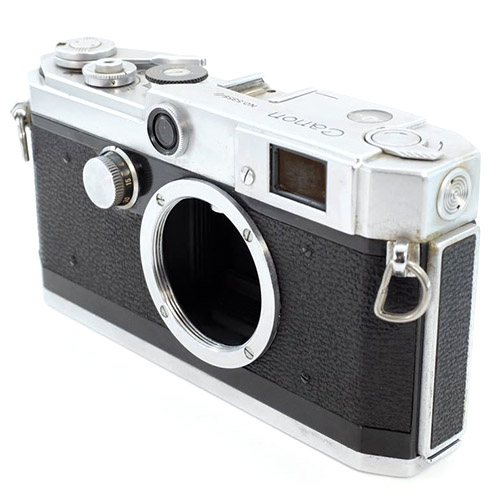 (Web image)
(Web image)
But sometimes it is a lot more than the L2. Below are photos of an L3 with flash socket, X sync and X sync/flashbulb switch. This is not an odd one, there are 10 examples with the expected 1/500 speed that I have either seen, or that have been confirmed by members of the Canon Historical Society Facebook group, and there are another 4 examples with a 1/1000 speed. One of the group members claims that he has recorded around 20 from observing eBay auctions:
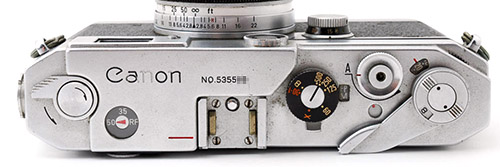
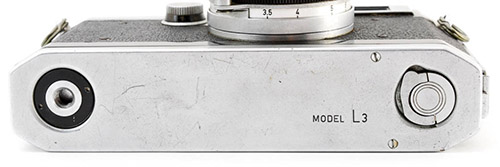
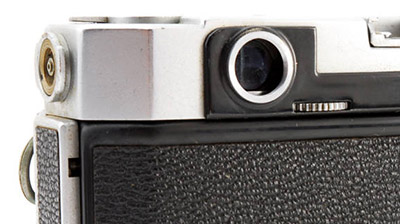 (Detail from larger web images)
(Detail from larger web images)
Another L3 oddity is that unlike the L1 and L2, the L3 name does not appear on all base plates. In my database, the name is there on all examples from serial number 526928 up to 537348. It is not there from serial number 537971 to the end at 581829. All except the last two L3s with flash sync fit into the first half of serial numbers and all have the “L3” marked base plate as expected. Of the two examples with higher serial numbers, on one the base plate is not visible but the second also features the L3 name.
The examples with the 1/1000 top speed have the same specs as the L1 but remain differentiated by retaining the pop-up rewind knob instead of crank. The 1/500 shutter dial with X sync marked is likely to be a Canon VL2 part. Speaking of the VL cameras, I also have photos of a camera with L3 base plate, L3/L2/VL-2 top plate with knob rewind, L1/VL shutter dial with 1/1000 and X sync, L1/VL/VL-2 mode switch and sync socket, i.e. the same as the 4 previous 1/1000 examples so far, but it also adds the VL/VL-2 self-timer. Unfortunately, the serial number is hidden by the accessory finder.
Rather than thinking of these cameras as L3s with flash sync, it's probably better to think of them as part of a bigger L/VL group of cameras with a mix of features/parts, it's just that these ones have an L3 base plate, more in Odd Spec Canon L and VL Cameras.
For a niche model, the L3 sold in good numbers, some 12,975 even though it seems to have been a domestic Japanese market only model. Strangely, according to Peter Dechert, it entered production in October 1957, only two months before the L1 and L2 ended production in December 1957, being replaced by the VL and VL-2. Therefore, even though it was an L2 without flash sync, it was more a junior partner to the VL and the VL-2 than to the L1 and L2.
Japanese L2 & L3 user manual dated October 1957:
 (Click on cover for PDF Manual)
(Click on cover for PDF Manual)
Canon VL
Production (Peter Dechert) |
Marketed (Canon) |
Slow Speeds |
Main Dial
|
Sync* |
S/Timer |
1956/05 (22) |
T, 1-1/15 |
B, 1/30-1/1000 |
M/FP/X |
Yes |
|
1957/12-1958/12 |
1958/03 |
(*Sync: 2 position switch, FP/M is for FP bulbs from 1 to 1/1000 and M bulbs from 1 to 1/125, X/F is for electronic flash at approximately 1/50 and F and M-2 bulbs from 1 to 1/30)
Serial Numbers |
||
Source |
From |
To |
| Peter Dechert | 555000 |
592000 |
| Found | 547640 |
56774x |
| Lens Mount: Universal | |||
| Normal 50mm Lens (Peter Dechert): Canon f/1.2, f/1.5, f/1.8 or f/2.8 |
|||
| Alternative 35 mm Lens (Peter Dechert): Canon f/1.8 or f/2.8 | |||
| Found with Lens: | |||
| Lens | Focal Length/ Description | Serial Numbers |
|
|---|---|---|---|
From |
To |
||
| f/1.2 Canon | 50mm Black | 2291x |
|
| f/1.8 Canon | 50mm Black | 22711x |
|
| f/2.8 Canon | 50mm Black | 2884x |
|
The Canon VL does not have a name marked on its body. The only obvious external difference between the Canon VL and L1 is the addition of the self-timer, however, the VL was an important Canon milestone introducing metal shutter curtains made of thin stainless steel for the first time. These operate the same way as cloth curtains and are interchangeable. Whilst subject to wrinkling, more often a euphemism for careless finger poking, they have proven entirely reliable whilst also eliminating the problem of pinholes burnt by the sun. One other improvement was to use silver coated finder optics, noticeable by the comparatively cooler cast to the view:
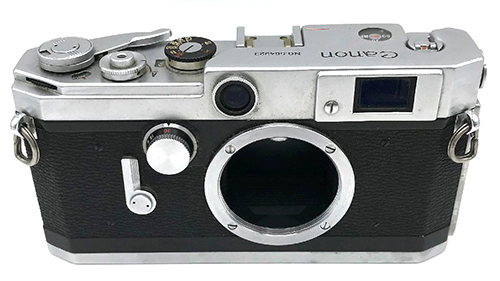
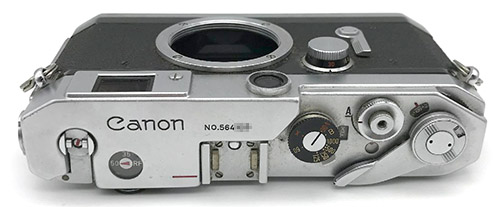
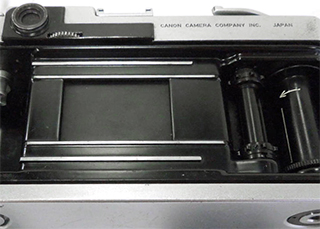 (Web images)
(Web images)
Peter Dechert tells us that an initial 22 VL examples were made in May 1956, some 18 months before release, presumably for long term testing. However, he adds that these may have had the “L1” marked baseplates, the name hadn't been finalised and they may or may not have had self-timers. To my mind, these could simply have been L1s fitted with metal curtains and Peter Dechert says as much. These are both V series cameras but Canon only used “V” in the name for models with self-timer, perhaps because “V” is commonly found on German cameras to indicate self-timer. I don't think the name had anything to do with the curtains. As such, I wouldn't include the 22 early examples in VL reckoning other than as part of the background to development of the metal curtains.
However, Peter Dechert's serial number range for the VL is from 555000 to 592000, not including the original 22 (serial numbers unknown) but I have found 4 cameras below that range, 547640, 553456, 554285 and 554610. Of these 553456 appears to have a cloth shutter but also an “L1” base plate. Whilst that might sound like some fiddling going on, 554610 has both metal curtains and an L1 base plate as does a slightly later camera from within Peter Dechert's VL serial numbers range, 564323. It seems that perhaps these are not full VLs per se, but like the flash synchronised L3s, may be part of the special production discussed in Odd Spec Canon L and VL Cameras.
Canon VL-2
Production (Peter Dechert) |
Marketed (Canon) |
Slow Speeds |
Main Dial
|
Sync* |
S/Timer |
1958/01-1958/12 |
1958/03 |
T, 1-1/15 |
B, 1/30-1/500 |
M/FP/X |
Yes |
(*Sync: 2 position switch, FP/M is for FP bulbs from 1 to 1/500 and M bulbs from 1 to 1/125, X/F is for electronic flash at approximately 1/50 and F and M-2 bulbs from 1 to 1/30)
Serial Numbers |
||
Source |
From |
To |
| Peter Dechert | 527000 |
585000 |
| Found | 53697x |
58350x |
| Lens Mount: Universal | |||
| Normal 50mm Lens (Peter Dechert): Canon f/1.8 or f/2.8 |
|||
| Alternative 35 mm Lens (Peter Dechert): Canon f/1.8 or f/2.8 | |||
| Found with Lens: | |||
| Lens | Focal Length/ Description | Serial Numbers |
|
|---|---|---|---|
From |
To |
||
| f/1.2 Canon | 50mm Black | 2047x |
|
| f/1.8 Canon | 50mm Black | 23017x |
24192x |
The only two differences between the Canon VL and VL-2 are that the VL-2 uses the pop-up rewind knob instead of crank and that it is missing the 1/1000 top speed. Unlike the earlier L2 version of the L1, it retains the full VL flash synchronisation:
 (Web image)
(Web image)
Canon VT de luxe M (internal Canon name)
Production (Peter Dechert) |
Marketed (Canon) |
Slow Speeds |
Main Dial
|
Sync* |
S/Timer |
1958/01-1958/12 |
T, 1-1/15 |
B, 1/30-1/1000 |
M/FP/X |
Yes |
(*Sync: 2 position switch, FP/M is for FP bulbs from 1 to 1/1000 and M bulbs from 1 to 1/125, X/F is for electronic flash at approximately 1/50 and F and M-2 bulbs from 1 to 1/30)
Serial Numbers |
||
Source |
From |
To |
| Peter Dechert | 540100 |
585000 |
| Found | 54624x |
58370x |
| Lens Mount: Universal | |||
| Normal 50mm Lens (Peter Dechert): Canon f/1.2, f/1.5, f/1.8 or f/2.8 |
|||
| Alternative 35 mm Lens (Peter Dechert): Canon f/1.5, f/1.8 or f/2.8 | |||
| Found with Lens: | |||
| Lens | Focal Length/ Description | Serial Numbers |
|
|---|---|---|---|
From |
To |
||
| f/1.2 Canon | 50mm Black | 2301x |
|
| f/1.8 Canon | 50mm Black | 26750x |
|
| f/2.8 Canon | 50mm Black | 2858x |
|
The name marked on the front is “MODEL VT de luxe”, the same as the previous two versions identified by Peter Dechert. Whilst he notes that Canon used “M” internally to distinguish this version, Canon's marketing only ever treated the three variations as one model, as reflected on the Canon Camera Museum website.
The VT de luxe M updates the previous version by adding metal curtains and silver coated optics, as on the VL update to the L1. Well used example but with the cooler optics and stainless shutter curtains (wrinkled) clearly on display:
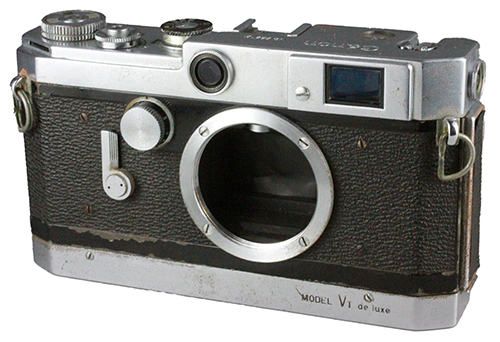 (Web image)
(Web image)
Canon VI-T
Production (Peter Dechert) |
Marketed (Canon) |
Slow Speeds |
Main Dial
|
Sync* |
S/Timer |
1958/06-1960/07 |
1958/09 |
Single dial |
B, 1-1/1000 |
M/FP/X |
Yes |
(*Sync: FP sync from 1 to 1/1000, except 1/30. M sync from 1 to 1/250, except 1/30. F bulbs 1 to 1/30. X sync at 1/55)
Serial Numbers |
||
Source |
From |
To |
| Peter Dechert | 600000 |
620000 |
| Found | 60163x |
61795x |
| Lens Mount: Universal | |||
| Normal 50mm Lens (Peter Dechert): Canon f/1.2, f/1.4, f/1.5, f/1.8 or f/2.8 |
|||
| Alternative 35 mm Lens (Peter Dechert): Canon f/1.5, f/1.8 or f/2.8 | |||
| Found with Lens: | |||
| Lens | Focal Length/ Description | Serial Numbers |
|
|---|---|---|---|
From |
To |
||
| f/1.2 Canon | 50mm Black | 2247x |
3387x |
| f/1.8 Canon | 50mm Black | 24259x |
|
The Canon VI-T, with “Model VI-T” engraved in the usual place for trigger models on the the front of the base plate, was released at the same time as its lever wind companion, the VI-L. They are the first two of the Series VI cameras which were attempting to play catch up with Leica and Nikon and the VI-T is Canon's last attempt to convince the market about trigger operated film wind.
Canon had finally caught up with the competition with a single non-spinning shutter dial which also enabled the use of a shutter coupled exposure meter like the Leica M3 and Leica Meter and the 1957 Nikon SP with its meter, however, the “T” position did not carry across from the previous shutter. Also, the viewfinder/rangefinder was improved to provide a 0.65x magnification for the 35 mm view, 1x magnification for the 50 mm view and 1.55x magnification for the accurate focusing position. The indicator window in the top plate was re-ordered to now read clockwise “Mg”, “50” and “35”. The 50 mm lens view was a little wider and now incorporated parallax corrected 50 mm and 100 mm bright line frames.
Canon also implemented an auto reset film counter for the first time. Flash sync speed increased to around 1/60 and no longer required switching between flashbulbs and X sync.
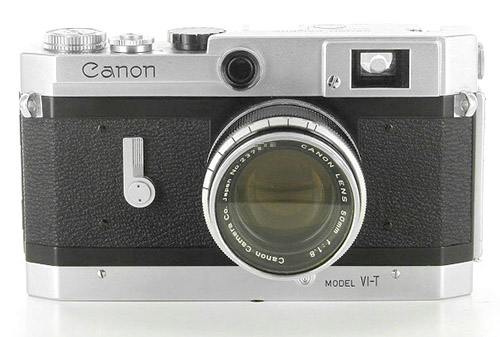 (Web image)
(Web image)
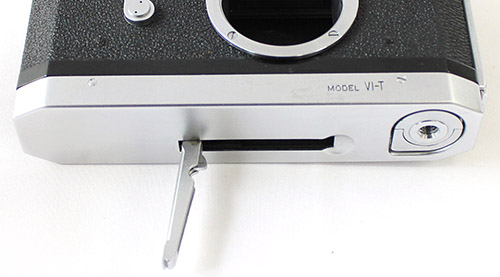 (Detail from larger web image)
(Detail from larger web image)
The Series VI cameras also feature a new film type/speed reminder on the camera back instead of on the rewind knob. Earlier black on silver version on top which featured on nearly all examples, later colour coded type on bottom, camera serial number unknown, but on the sibling lever wind VI-L, the change occurred between camera 61580x and 62020x, so right towards the end of VI-T production which finished earlier:
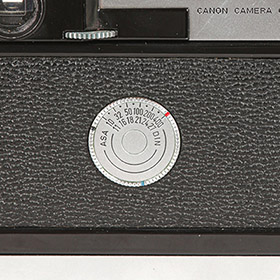
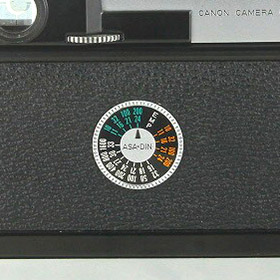
(Web images)
Accessory shutter coupled Canon Meter mounted via the accessory shoe:
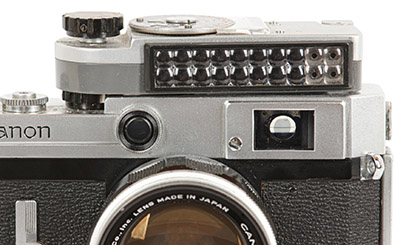 (Detail from larger web image)
(Detail from larger web image)
See Canon Meters for more information.
Canon VI-L
Production (Peter Dechert) |
Marketed (Canon) |
Slow Speeds |
Main Dial
|
Sync* |
S/Timer |
1958/06-1961/03 |
1958/09 |
Single dial |
B, 1-1/1000 |
M/FP/X |
Yes |
(*Sync: FP sync from 1 to 1/1000, except 1/30. M sync from 1 to 1/250, except 1/30. F bulbs 1 to 1/30. X sync at 1/55)
Serial Numbers |
||
Source |
From |
To |
| Peter Dechert | 600000 |
621000 |
| Found | 60061x |
62020x |
| Lens Mount: Universal | |||
| Normal 50mm Lens (Peter Dechert): Canon f/1.2, f/1.4, f/1.5, f/1.8 or f/2.8 |
|||
| Alternative 35 mm Lens (Peter Dechert): Canon f/1.5, f/1.8 or f/2.8 | |||
| Found with Lens: | |||
| Lens | Focal Length/ Description | Serial Numbers |
|
|---|---|---|---|
From |
To |
||
| f/1.2 Canon | 50mm Black | 2652x |
4893x |
| f/1.8 Canon | 50mm Black | 20516x |
23783x |
| f/2.2 Canon | 50mm Black | 1026x |
|
The Canon VI-L is the lever wind companion model to the VI-T released at the same time but like the late L3, VL and VL-2 lever wind models and unlike its trigger operated sibling, its name is not marked on the body. All the same improvements apply including the non-spinning single shutter dial, increased magnification viewfinder, raised X sync speed, auto frame counter reset etc.:
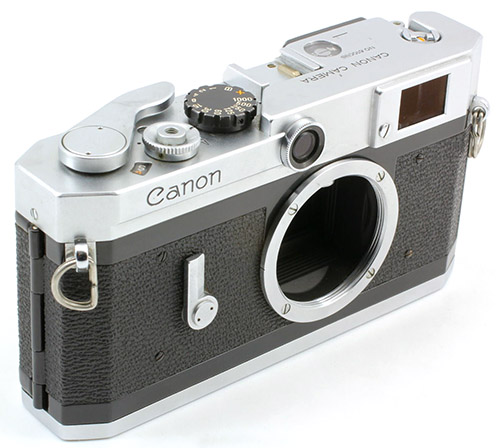 (Web image)
(Web image)
I have found only one f/2.2 lens (released in January 1961) with a VI-L (a late example). Whilst according to Peter Kitchingman, the lens was made for the Canon P, the VI-L was still in production and I have only found one with the Canon P as well. Whether any were sold with the VI-L is unknown. Peter's reasoning for singling out the Canon P is that the two colour distance scale of the lens matches the colours of the later type Canon P film reminder dial on the back, this also featured on the very late VI-L (and also right at the end of the VI-T, see above) - it's there on the last two VI-L cameras in my database, 62011x and 62020x but not the previous one, 61580x (the only large gap in my VI-L database), or the late example found with the f2.2 lens. Peter Dechert didn't identify this lens, it is believed to have been sold only in the Japanese domestic market and is quite hard to find.
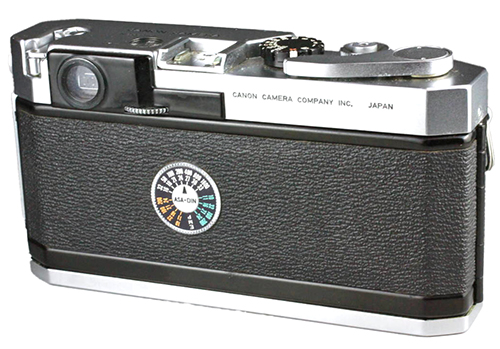 (Web image)
(Web image)
Example with meter mounted and the earlier and much more common black on silver film reminder dial:
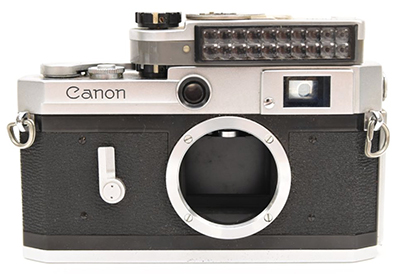
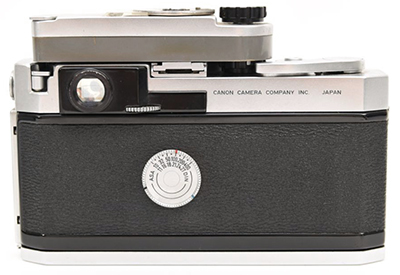 (Web images)
(Web images)
The VI pair were not a success for Canon, the VI-T was a hard sell in any case but the reality was that they were only a little less expensive than Leica M3 and Nikon SP but the VI pair had been late to market and didn't offer enough to get attention. Nevertheless, the VI-L is an excellent camera and has more to offer than the very popular Canon P offspring.
See Canon Meters for more information regarding the accessory coupled exposure meter.
Canon P (Populaire)
Production (Peter Dechert) |
Marketed (Canon) |
Slow Speeds |
Main Dial
|
Sync* |
S/Timer |
1958/12-1961/05 |
1959/03 |
Single dial |
B, 1-1/1000 |
M/FP/X |
Yes |
(*Sync: FP sync from 1 to 1/1000, except 1/30. M sync from 1 to 1/250, except 1/30. F bulbs 1 to 1/30. X sync at 1/55)
Serial Numbers |
||
Source |
From |
To |
| Peter Dechert | 700000 |
798000 |
| Found | 70007x |
79x999 |
| Lens Mount: Universal | |||
| Normal 50mm Lens (Peter Dechert): Canon f/1.2, f/1.4, f/1.8 or f/2.8 |
|||
| Alternative 35 mm Lens (Peter Dechert): Canon f/1.5, f/2 or f/2.8 | |||
| Found with Lens: | |||
| Lens | Focal Length/ Description | Serial Numbers |
|
|---|---|---|---|
From |
To |
||
| f/1.2 Canon | 50mm Black | 3610x |
4246x |
| f/1.4 Canon | 50mm Black | 1902x |
2857x |
| f/1.8 Canon | 50mm Black | 24238x |
30186x |
| f/2.2 Canon | 50mm Black | 1001x |
|
| f/2.8 Canon | 50mm Black | 3754x |
|
(The 50 mm f/2.2 was made from January to June 1961, believed to have been for the Japanese domestic market only. It is a hard to find lens these days and not identified in Peter Dechert's book.)
The Canon P, in some markets known as the “Canon Populaire” certainly lived up to its name with 87,875 produced, second only to the Canon 7. This was at a time when other Japanese rangefinder makers were either abandoning the market or going bankrupt. The Canon P is the third Series VI model and is the VI-L with simplified viewfinder and the accessory shoe parallax correcting pin removed, changes which enabled a price that seemed to totally change the value for money perception.
The viewfinder/rangefinder was modified by removing the variable magnification facility and making it 1x with a 35 mm bright line frame added to the 50 mm and 100 mm parallax corrected frames:
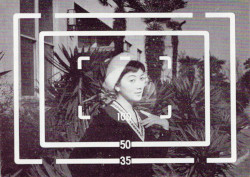
Whilst the magnification was competitive, it was applied to an exisiting rangefinder design with a relatively short base length of either 43 mm (Canon) or 41 mm (other sources) resulting in an Effective Base Length of either 43 mm or 41 mm, about 2/3 of the Leica M3 and Nikon EBLs and the shortest of any Canon since the 1946 S II. First image shows shutter coupled Canon Meter 2 mounted (see Canon Meters for more information):
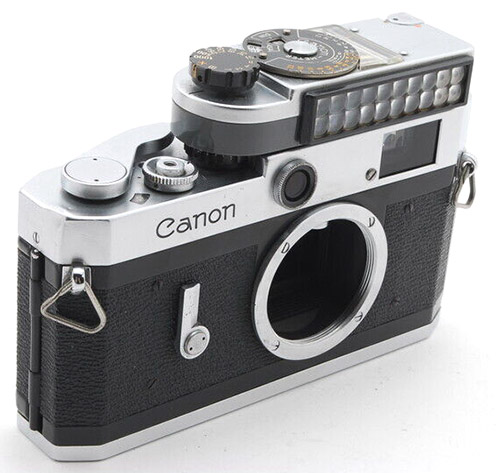
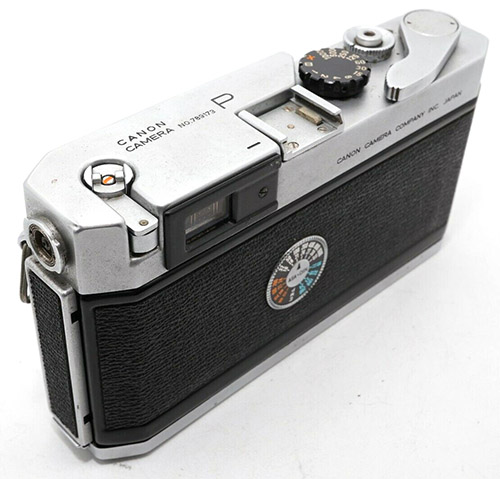
 (Web images)
(Web images)
Like the Canon VI-T and VI-L, the Canon P started with a black on silver film reminder dial on the camera back and changed to the colour coded type above. Being introduced some 6 months later, the Canon P change occurred very early on between serial numbers 70711x and 70994. First black on silver type:
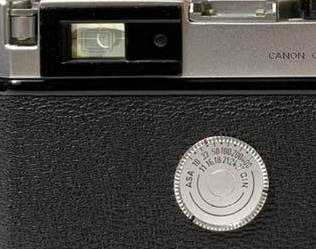 (Web image)
(Web image)
Black bodied example with matching black 50 mm f/1.8 lens:
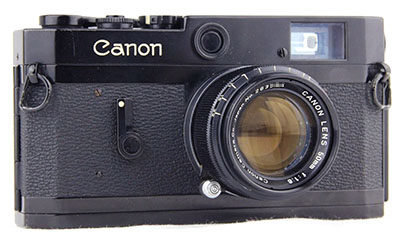 (Web image)
(Web image)
Canon 7
Production (Peter Dechert) |
Marketed (Canon) |
Slow Speeds |
Main Dial
|
Sync* |
S/Timer |
1961/06-1964/11 |
1961/09 |
Single dial |
T, B, 1-1/1000 |
M/FP/X |
Yes |
(*Sync: FP sync from 1 to 1/1000, except 1/30. M sync from 1 to 1/15. F bulbs 1 to 1/30. Electronic flash at X, B and 1 to 1/30 positions)
Serial Numbers |
||
Source |
From |
To |
| Peter Dechert | 800000 |
999000 |
| Found | 80135x |
94155x |
| Lens Mount: Universal | |||
| Normal 50mm Lens (Peter Dechert): Canon f/0.95, f/1.2, f/1.4 or f/1.8 |
|||
| Found with Lens: | |||
| Lens | Focal Length/ Description | Serial Numbers |
|
|---|---|---|---|
From |
To |
||
| f/0.95 Canon | Black | 1133x |
1498x |
| f/1.2 Canon | Black | 5053x |
5154x |
| f/1.4 Canon | Black | 5215x |
11577x |
| f/1.8 Canon | Black | 29695x |
33749x |
| f/2.2 Canon | Black | 1282x |
1385x |
(The 50 mm f/2.2 was made from January to June 1961, an economy option believed to have been for the Canon P, and possibly the Canon VI L, for the Japanese domestic market only. It is a hard to find lens these days and not identified in Peter Dechert's book. However, I have only found one lens with a Canon P, one with a VI-L but three with Canon 7 bodies. Lenses get swapped around but all three have higher serial numbers than those on the other two cameras. It is possible, but by no means necessarily likely, that excess stock may have been sold with some Canon 7 bodies.)
In September 1961, Canon launched the Canon 7, its by far most successful model of all with 137,250 made. It featured a built-in shutter coupled exposure meter, projected frame lines rather than the earlier reflected type and an external bayonet lens mount for the optional f/0.95 50mm lens (also used with the Mirror Box II reflex housing). It was also the last model available in black.
The superstructure was new, incorporating the new viewfinder, its illumination window and the selenium cell exposure meter, essentially the Canon-Meter 2 built in. The “T” setting made a return to the shutter dial and the film rewind crank changed from the unique Canon recessed design to the more common crank on a disc type. The camera's footprint remained the same but its height increased to be basically the same as the trigger operated models. However, the superstructure is thicker than earlier models with the selenium cell adding a some millimetres at the front and the rangefinder/viewfinder housing bulging out at the rear.
The rangefinder base length was increased to 59 mm to improve focusing accuracy, particularly with the new f/0.95 lens. Peter Dechert notes that the base length is longer than any previous Canon model but with magnification of 0.8x, the effective base length (EBL) is only 47.2 mm which is significantly less than the Leica and Nikon competition and less than Canon models offering 1.5x magnification (variable magnification models) and only longer than the 1946 Canon S II and Canon P. However, the viewfinder is a far more useable and pleasant experience than Canon's earlier ones. The five projected frame lines are parallax corrected and selectable with a four position dial switch on the top plate; 35 mm, 50 mm, 85 mm and 100 mm together and 135 mm.
The large meter readout in the middle of the top plate caused a problem for placement of the accessory shoe so it was simply omitted, probably the main negative that can be said about the camera. To be fair, the Canon flash system didn't require an accessory shoe and most focal length lenses didn't require a matching accessory viewfinder and in any case, Canon did offer two accessory shoe types. Both mounted via the sync socket bayonet, the smaller neater one placing the shoe over the rewind knob and only really being suitable for non-Canon flashguns, the larger one placing the accessory shoe in the middle of the top plate over the meter readout and this also makes it suitable for mounting viewfinders for wider and longer lenses, an essential feature of most rangefinder cameras. However, the removable shoes are ungainly extras and not entirely satisfactory solutions, both have to be removed to rewind film and whilst the larger one has a cut-out for the meter readout, the meter is difficult to read with anything mounted in the shoe. Canon was happy to sell you one of these shoes back in the 1960s but finding them these days is not easy.
The Canon 7 was undoubtedly the finest LTM rangefinder made till then, only surpassed by the updated Canon 7s. It is not perfect but features wise it was also competitive with the perhaps slightly more professional Nikon models (by then, they had ceased series production) and the rangefinder benchmark, the Leica M3.
Canon 7 with f/1.18 50mm lens which was now the budget option. The serial number is a bit early for this model and the lens probably originally belonged to a Canon VI-T, VI-L or P:
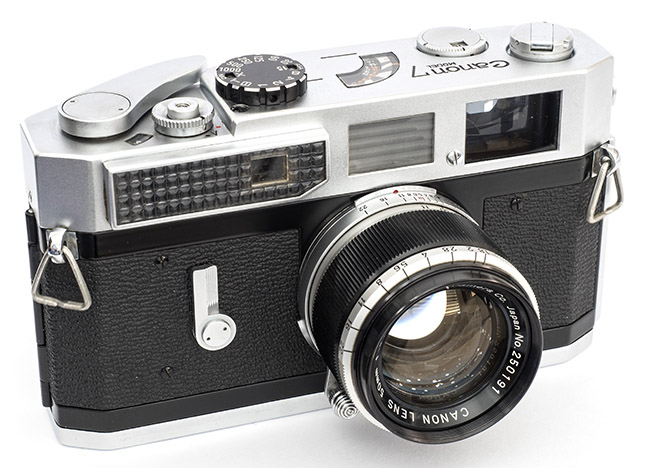
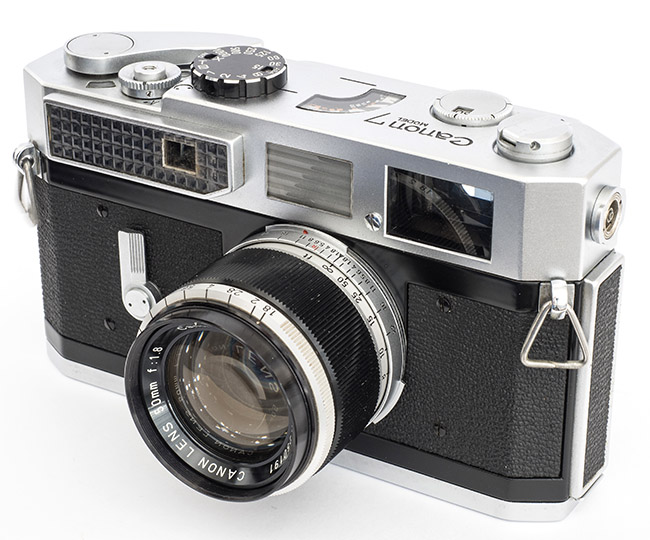
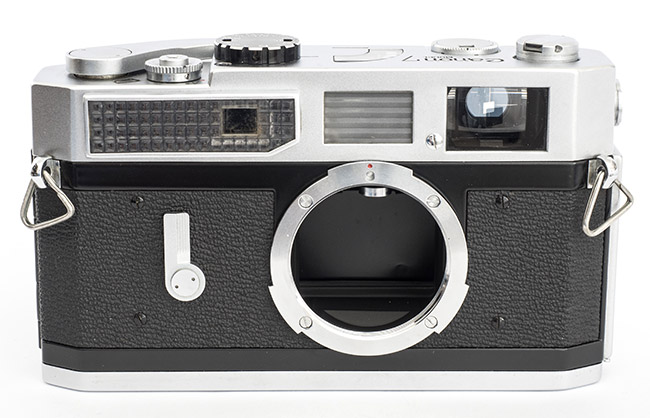
The knob on the back is for setting the light meter sensitivity:
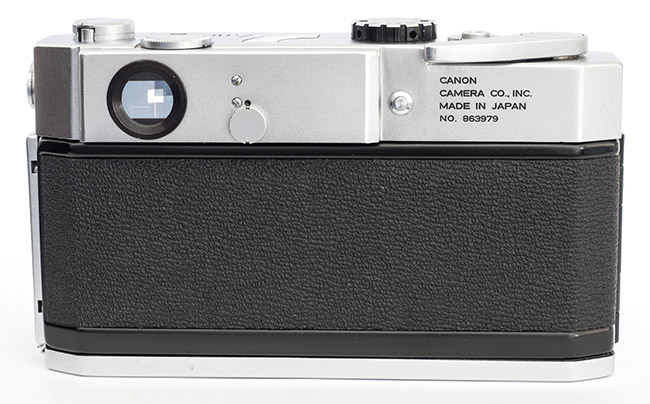
The dial near the rewind crank is for selecting the viewfinder frame lines:
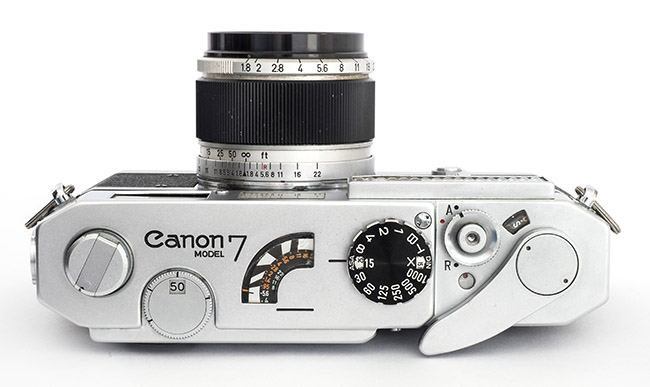

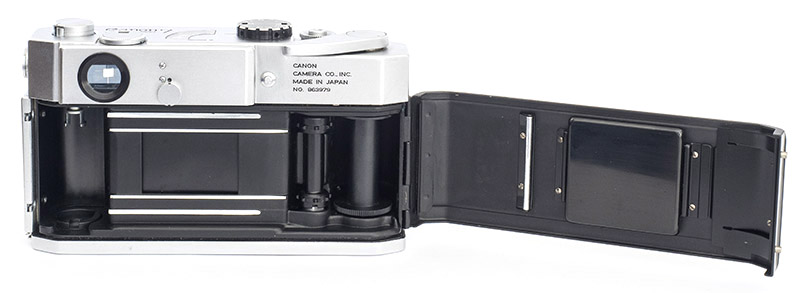
An example with the f/0.95 50 mm lens mounted:
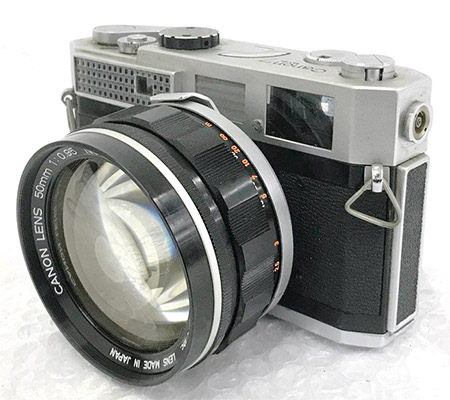 (Web image)
(Web image)
A black body (with correct paint over brass strap lugs, white dot on self-timer and chrome film rewind crank) and an example with Bell & Howell co-branding resulting from Bell & Howell taking over USA distributorship in 1962 (features the rare Canon 50 mm f/2.2 lens but this is almost certainly not original to the camera, production ended mid-1961 at the time of the Canon 7 release, well before the Bell & Howell distributorship, and in any case, it was likely a domestic Japanese market only product):
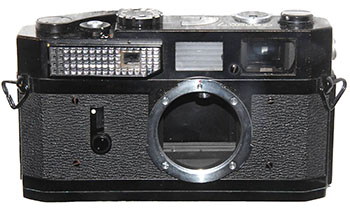
 (Web images)
(Web images)
Canon 7s
Production (Peter Dechert) |
Marketed (Canon) |
Slow Speeds |
Main Dial
|
Sync* |
S/Timer |
1965/02-1967/08 |
1965/04 |
Single dial |
T, B, 1-1/1000 |
M/FP/X |
Yes |
(*Sync: FP sync from 1 to 1/1000 plus B and T, except 1/30. M sync from 1 to 1/15 plus B and T, also from 1/60 to 1/250 “where only the central part of the picture is necessary”. F bulbs 1 to 1/30 plus B and T. Electronic flash at X, B, T and 1 to 1/30 positions)
Serial Numbers |
||
Source |
From |
To |
| Peter Dechert | 100000 |
118500 |
| Found | 10072x |
11557x |
| Lens Mount: Universal | |||
| Normal 50mm Lens (Peter Dechert): Canon f/0.95, f/1.2, f/1.4 or f/1.8 |
|||
| Found with Lens: | |||
| Lens | Focal Length/ Description | Serial Numbers |
|
|---|---|---|---|
From |
To |
||
| f/0.95 Canon | Black | 1700x |
|
| f/1.4 Canon | Black | 10767x |
|
| f/1.8 Canon | Black | 28777x |
33179x |
The Canon 7s was released in April 1965. This update brought two significant improvements and some smaller related changes. The biggest change was the replacement of the selenium cell exposure meter with a battery powered CdS type. In the process, a new small meter readout window in the top plate allowed the second major change, the return of the accessory shoe.
The new exposure meter resulted in several other changes as well. A battery compartment was added to the base plate (see below) and the Canon 7 meter sensitivity switch, function now incorporated into the CdS cell bezel, was replaced by a meter off/on switch with battery check position.
Two minor unrelated changes were the removal of the bayonet flashgun mount, probably due to rationalising flashgun production away from bayonet models to more standard types shared with Canon's SLRs and fixed lens rangefinders, and restarting serial numbers at 100000 with 6 digits instead of ticking over to 7 digits.
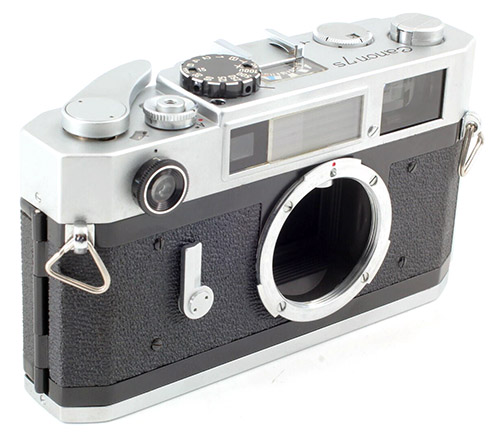 (Web image)
(Web image)
The rear of a different camera, this one has the <EP> mark on the film wind lever. The light meter sensitivity knob is now an exposure meter on-off switch and battery check:
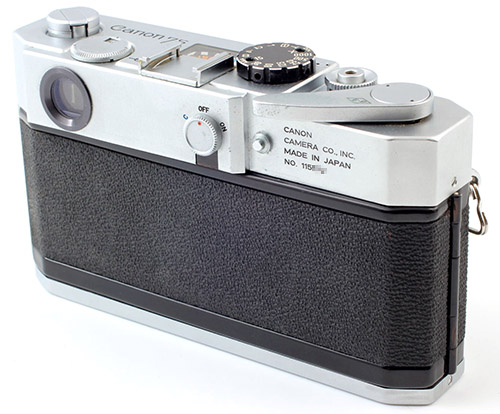 (Web image)
(Web image)
The battery compartment for the CdS meter is where the tripod mount used to be so the mount was moved towards the other end:
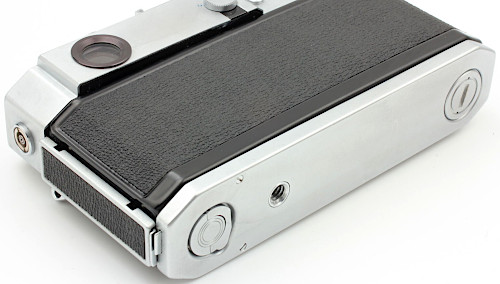 (Web image)
(Web image)
The PC flash sync socket on the end of the camera is now without the bayonet fitting of the Series 5 to Canon 7 models making it necessary to use either a typical accessory shoe mount type or bottom mount bracket. Note the spanner slots in the fitting, these disappeared with the 7sZ:
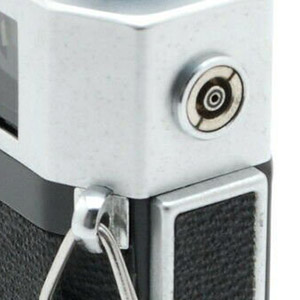 (Detail from larger web image)
(Detail from larger web image)
Canon 7sZ (Peter Dechert name)
Production (Peter Dechert) |
Marketed (Canon) |
Slow Speeds |
Main Dial
|
Sync* |
S/Timer |
1967/08-1968/09 |
n/a |
Single dial |
T, B, 1-1/1000 |
M/FP/X |
Yes |
(*Sync: FP sync from 1 to 1/1000 plus B and T, except 1/30. M sync from 1 to 1/15 plus B and T, also from 1/60 to 1/250 “where only the central part of the picture is necessary”. F bulbs 1 to 1/30 plus B and T. Electronic flash at X, B, T and 1 to 1/30 positions)
Serial Numbers |
||
Source |
From |
To |
| Peter Dechert | 115000 |
123000 |
| Found | 11647x |
123001 |
| Lens Mount: Universal | |||
| Normal 50mm Lens (Peter Dechert): Canon f/0.95, f/1.2, f/1.4 or f/1.8 |
|||
| Found with Lens: | |||
| Lens | Focal Length/ Description | Serial Numbers |
|
|---|---|---|---|
From |
To |
||
| f/1.4 Canon | Black | 11382x |
11693x |
| f/1.8 Canon | Black | 31873x |
34381x |
Canon made some improvements to the Canon 7s during its production run but whilst Canon chose not to identify it differently, or additionally, to the original, author Peter Dechert decided that it needed its own name and coined “Canon 7sZ”, the “Z” being the final letter in the Roman alphabet seemed to be a fitting name for the last model. For the record, I don't like the idea of inventing names for models that didn't exist, there are other ways of identifying an updated version, e.g. “late type”, maybe in brackets, but 7sZ has stuck almost universally so that is what we all call it, even though you will not find that model in the Canon Camera Museum.
The external changes are the screw-in PC flash sync socket no longer has any spanner slots, the rewind crank and knob are now larger diameter and lower profile but are no longer semi-recessed and the cover for the rangefinder adjustment screw and cover has moved from adjacent to the top right of the shutter dial, just opposite the shutter button, to above and between the “n” and “7” in the name “Canon 7s”. The more important internal change was a new viewfinder/rangefinder to address ghosting issues with the Canon 7/7s. Note, the changes didn't occur simultaneously, there was a transition period from about camera serial number 11532x (featuring only the new rewind knob) to 11836x (first with new sync socket as well as the other two changes). In my database, the signature change to the rangefinder/viewfinder was around camera 11647x:
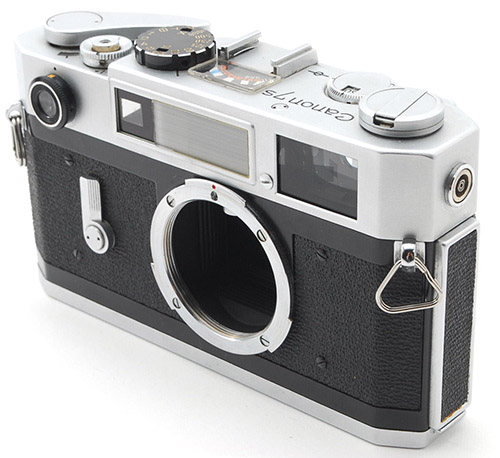 (Web image)
(Web image)
This then was the ultimate form of the ultimate series of Canon rangefinder cameras.
X-Ray Cameras
From the perspective of our Leica copy narrative, the X-ray cameras are a footnote to the main story but they are relevant to the development of the company and the first Serenar lenses. Peter Dechert covers the 35 mm versions on pages 164 to 170 of his book and Peter Kitchingman has a picture of one and details of the R-Serenar 5 cm f/1.5 on pages 84 to 85 of his book. Serious collector Kirk Thorsteinson features his post-War Circa 1948 6 x 6 cm version and several others on the Canon page of his Flickr site and provides detailed notes and variation history which I have relied on for the larger version of the camera.
Development of the Seiki Kogaku X-ray camera began around 1939. It was intended for recording fluoroscope images rather than direct imaging. According to Hayato Ueyama, there was considerable demand for a Japanese version of an indirect recording camera like featured in overseas medical articles. Leitz did something similar but it was based on the Leica Standard body. Initial Seiki Kogaku prototypes used the Canon J body before settling on a unique design said to be based on the Carl Zeiss Tenax body which used a 24 mm x 24 mm film format. The camera was basically a light tight box with film transport. There was no shutter, a dark slide being used instead. The camera featured a bayonet lens mount with the lens surrounded by a metal cone for mounting to the pyramid shaped fluoroscope hood. It used 35 mm film with the Tenax image format of 24 x 24 mm being settled on for maximum economy. Hayato Ueyama continues:
“It was delivered to the Navy through Colonel Seijiro Yokokura, the chief orthopedic surgeon at Naval Yokosuka Hospital. Yokosuka Hospital had about 20 Zeiss-Ikon Sonnar lenses 5cm f1.5 brought from Germany by submarine, so the original Seiki X-Ray camera was used with them.” and: “ The lenses were later changed to Nikkor 5 cm f/2 and f/1.5 and then Seiki Serenar 5 cm f/1.5.”
Production commenced in early 1940 and in 1942, deliveries began to the Army Medical School. Ueyama says that this version was fitted with the Serenar 5 cm f/2, later replaced by the f/1.5 version which he says was developed from the f/2 (the designer is said to have claimed that the result was closer to f/1.6). Note, as mentioned elsewhere, apart from Ueyama's book, I have found no other references anywhere to a pre-War Serenar 5 cm f/2. A pre-War Nikkor 5 cm f/1.5 is just as elusive, although Peter Dechert speculates that prototypes of the X-ray camera used a Nippon Kogaku made 5 cm f/1.5 lens but he is more certain that Nippon Kogaku supplied 50 such lenses for the first production cameras. Ueyama does also mention it (see above quote). The Nikon Museum has displayed a Regno-Nikkor 5 cm f/1.5 lens with the year shown as 1944. Although other items on display suggest that is the year of release of the lens, it is still a little unclear whether it might not be just that version, or even the year of the particular lens itself (“Nikon Museum Special Collection 2”, 29 September 2020 to 30 January 2021 - see Red Book Nikkor site). It seems unlikely to me that Dechert and Ueyama can both be correct.
There were only minor changes until production ended in 1957. Initially only engraved with the Kogaku Seiki eagle logo, from 1947 it was named “X-Ray Canon 35” and from 1951 or 1952, “X-Ray Canon CX-35”. Early 35 mm type with Seiki eagle, missing both front leatherette and chain usually attached to the film winding knob which enables winding on remotely:
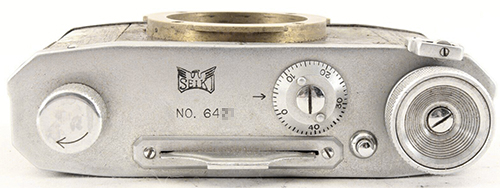 (Web image)
(Web image)
Below are the basic components of a post-1951 CX-35 set normally supplied in a timber box; camera body, lens and lens mounting cone. Note that unlike the normal Canon rangefinder cameras, the body tapers slightly before ending in the typical hexagonal shape. This example also is missing the winding on chain:
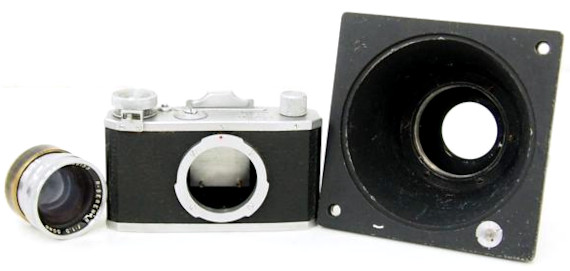
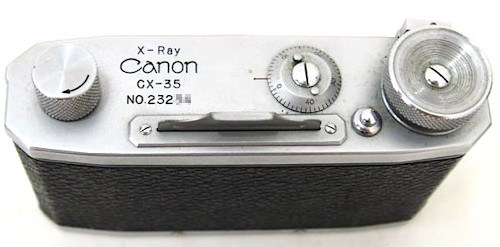 (Web images)
(Web images)
The winding on chain on another 1950s CX-35:
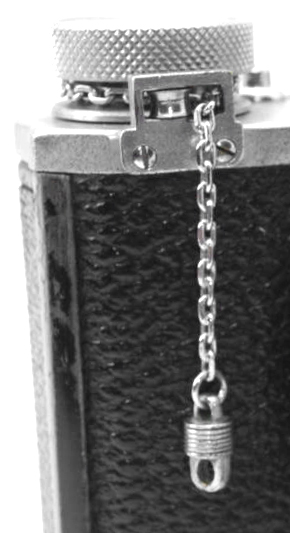 (Web image)
(Web image)
According to Peter Kitchingman, the R-Serenar ended production in 1946. What replaced it is not clear. The rangefinder camera Serenar 50 mm f/1.5 arrived in October 1952 and one month later, it was already named “Canon Lens”. The CX-35 examples I have seen have been fitted with Canon 50 mm f/1.5 lenses, presumably the standard glass in special barrels. The serial numbering appears to be part of the normal 50 mm f/1.5 range. What happened between 1946 and 1952 is a mystery to me:
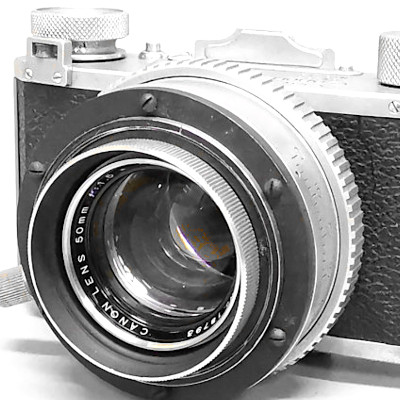 (Web image)
(Web image)
The larger 6 x 6 cm 120 roll film camera was released in 1946 (from 5th version Canon user manual) and is engraved “X-Ray Canon 6x6”, becoming “X-Ray Canon CX-60” in Circa 1950. These cameras underwent more significant development than the 35 mm version, by the fourth version, the body also losing its hexagonal ends in favour of rounded ones. The 6 x 6 camera didn't retain the winding chain feature. Five versions have been identified, by the third, the boxed kit included the roll film body, lens and cone plus 6 cut-film holders and a second “body” for use with the film holders. Kirk Thorsteinson calls this an “adapter” but whilst the roll film camera is simply a light tight box with film transport built in, this is also a light tight box when the cut-film holder is mounted, even though it looks like a shallow rectangular funnel with a lens mount at its mouth. It is in effect a second camera even though it doesn't look like one. Canon also treats it as a second class citizen, a fifth version one is named “CX60B” without serial number. Probably from the fourth version, the kit also included a second roll film body.
Initially, the 8 cm f/2 lens was named as a “Seiki Kogaku Serenar”, this soon changed to “Canon Serenar” and then “Canon X-Serenar”. A new 100 mm f/1.5 “Canon R-Serenar” lens was introduced in 1949 (Kirk Thorsteinson research) or 1950 (5th version Canon user manual), becoming the “X-Canon Lens” when the Serenar name was dropped. Below is Kirk Thorsteinson's early 2nd version X-Ray Canon 6x6. See his site for higher resolution photos and his research into the x-ray cameras:
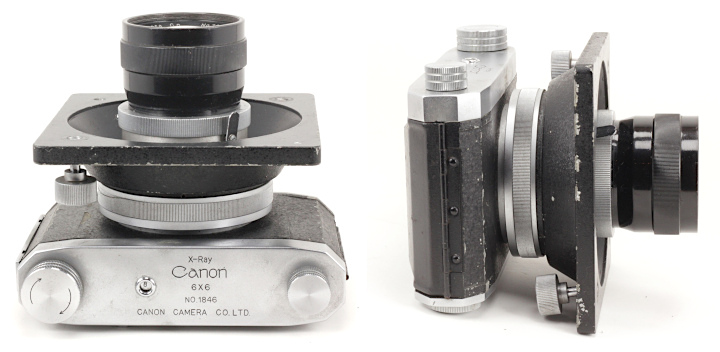
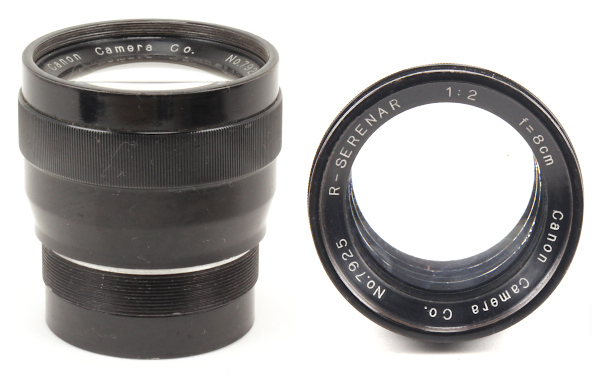
(Images courtesy of Kirk Thorsteinson)
Below are images of a fifth version set without its timber kit box, note the cut-film holders and their “camera body”:
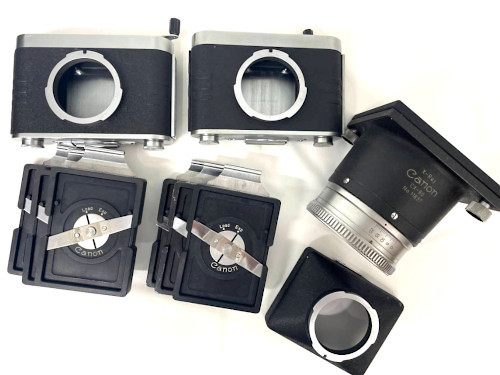
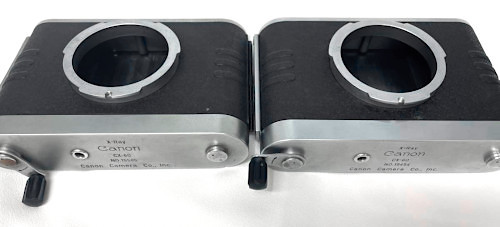
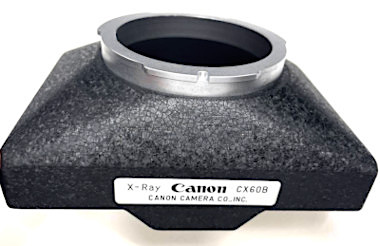
(Web images)
Canon Lenses, Flash & Accessories Page
Contact Details
My name is Paul Sokk and I can be contacted by email at paulsokk@live.com.au.
.jpg)
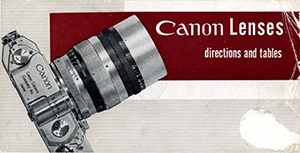
.jpg)
.jpg)
.jpg)
.jpg)
.jpg)
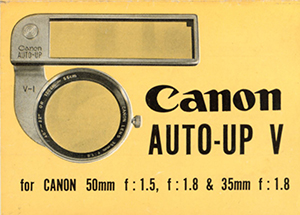
.jpg)
